CSS (Chinese Space Station)
EO
Quick facts
Overview
| Mission type | EO |
CSS (Chinese Space Station) Tiangong
Launch Mission Status Supply Missions References
The Chinese large modular space station is a planned space station to be placed into LEO (Low Earth Orbit) between 340 and 450 km above the surface. The planned Chinese Space Station will be roughly one-fifth the mass of the ISS (International Space Station) and about the size of the decommissioned Russian Mir space station. The Chinese station is expected to have a mass between 80 and 100 tons. Operations will be controlled from the Beijing Aerospace Command and Control Center in China. The planned launch date of the core module, the Tianhe (“Harmony of the Heavens”), is 2021. In 2017, the Chinese launched the Tianzhou-1 ("Heavenly Vessel") cargo spaceship, which is based on the Tiangong 1 and 2 space laboratories. 1)
China formally launched its manned space program, known as Project 921, in September 1992. Chief objectives of the multi-phase Project 921 include achieving human spaceflight and developing and operating what Wu Ping, then-Deputy Director of China’s Manned Space Agency (CMSA), called a “permanent” manned Chinese space station. 2)
A critical aspect of Project 921 was the development of the Tiangong (“Heavenly Palace”) space laboratories that served as critical testbeds for gaining the technical know-how for operating the CSS. The 8.5 metric ton Tiangong-1 launched in September 2011 and enabled Chinese astronauts – or “taikonauts” – to practice rendezvous and docking maneuvers and carry out short-term missions in space. China lost communication with the space module in March 2016, and on April 2, 2018 the Tiangong-1 plunged through Earth’s atmosphere, scattering debris over the South Pacific.
Chinese engineers applied lessons from the Tiangong-1 to improve the design of its successor, the Tiangong-2, which launched in September 2016. The Tiangong-2 featured a greater capacity for scientific experimentation and was therefore described by Wu Ping as a laboratory “in the true sense of the word.” According to China’s 2016 white paper on space activities, the Tiangong-2 offered a platform for China to master key capabilities, such as cargo transport and replenishment, necessary for operating a permanent space station.
The advantages of developing space capabilities are manifold. Satellites facilitate military and civilian communications. Human spaceflight garners international prestige, while also providing opportunities for cutting-edge research. Experiments conducted in space have resulted in numerous breakthroughs that have been used to address medical, environmental, and technological challenges back on Earth.
Due to improvements in living quarters and life-support infrastructure, the module was able to host the two-man Shenzhou-11 crew for 30 days in late 2016. This marked China’s longest crewed mission to date. China successfully de-orbited the Tiangong-2 in July 2019. A third Tiangong space lab, capable of supporting three taikonauts for 40-day intervals, was planned but the program was later cancelled in favor of skipping to the development of a more advanced space station.
Designing the Chinese Space Station
Building on the success of the Tiangong missions, China constructed the core module of the CSS. Dubbed the Tianhe-1 (“Harmony of the Heavens-1”), the core module is 18.1 meters long and has a mass of 22 metric tons. The module was originally planned for entry into orbit sometime in 2018, but officials announced in March 2018 that the launch would be delayed. Reports indicate the delay was due to a failed launch in 2017 of the heavy-lift Long March 5 rocket that is needed to lift the module into orbit. On April 29, 2021, a Long March 5B rocket successfully launched the Tianhe-1 into Earth’s orbit, nearly three years behind the original schedule.
The core module will be joined by the Tianzhou-2 cargo and supply spacecraft, which will dock with the Tianhe-1 to deliver propellant as well as supplies for the taikonauts who will eventually live on the CSS. The Tianzhou-2 will have a mass of around 13.5 metric tons, with a cargo mass of around 6.5 metric tons. The spacecraft will launch on a Long March 7 medium-lift rocket, likely in May 2021.
With the core module deployed and stocked, China will launch three taikonauts to live on the CSS. The launch is expected to take place in June 2021. This crewed mission, named Shenzhou-12, will be China’s seventh, and the first since the Shenzhou-11 mission in 2016. There are currently a total of four crewed missions planned, with 12 taikonauts in training to live on the CSS.
In addition to the core module, the station’s basic configuration will eventually also consist of two experiment modules – the Wentian (“Quest for the Heavens”) and Mengtian (“Dreaming of the Heavens”) – permanently docked opposite each other in a T-shape structure. Each experiment module will have roughly the same length (14.4 meters) and mass (22 metric tons). Both modules are expected to be launched in 2022.
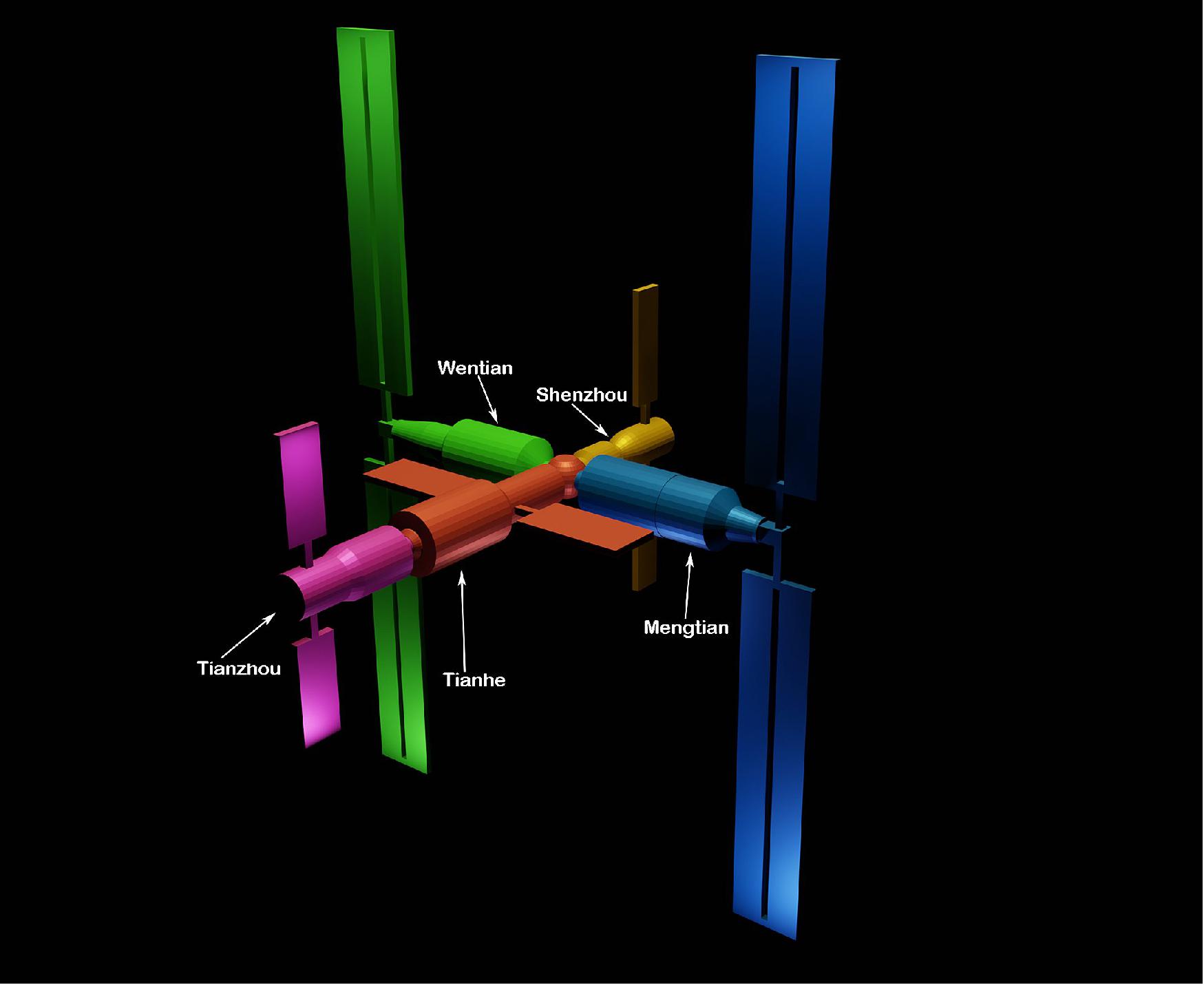
Chinese engineers plan to outfit the CSS with a number of features. The Tianhe core has five docking ports, as well as a robotic arm and internal racks for experimentation. The Wentian will also feature modular storage racks and a robotic arm, while the Mengtian will have a docking port to interface with visiting spacecraft, repair vehicles, and support modules. A space telescope, the Xuntian (“Heavenly Cruiser”), may also launch into orbit near the Chinese Space Station around 2024. It is expected to have a field of view 300 times the size of NASA’s Hubble Space Telescope.
If successfully completed, the CSS will be roughly one-sixth the mass of the International Space Station (ISS) and half the size of the decommissioned Russian Mir Space Station. The Chinese station is expected to have a total mass between 60 and 70 metric tons, while the ISS has a mass over 420 metric tons, and Mir had a mass of approximately 130 metric tons.
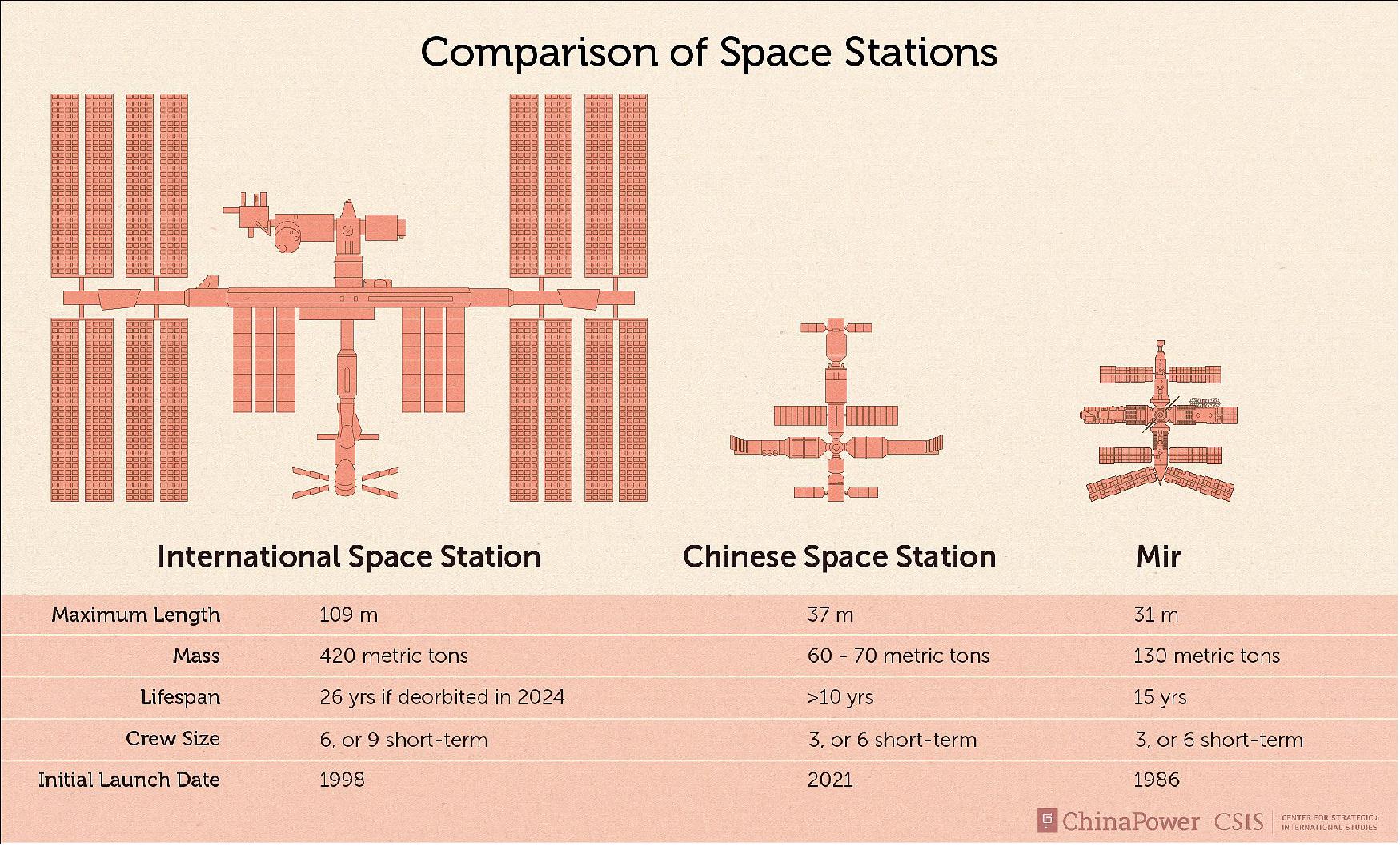
Development Status
• July 14, 2022: China is gearing up to send a second module to its under-construction space station with a launch from the coastal Wenchang spaceport later this month. 3)
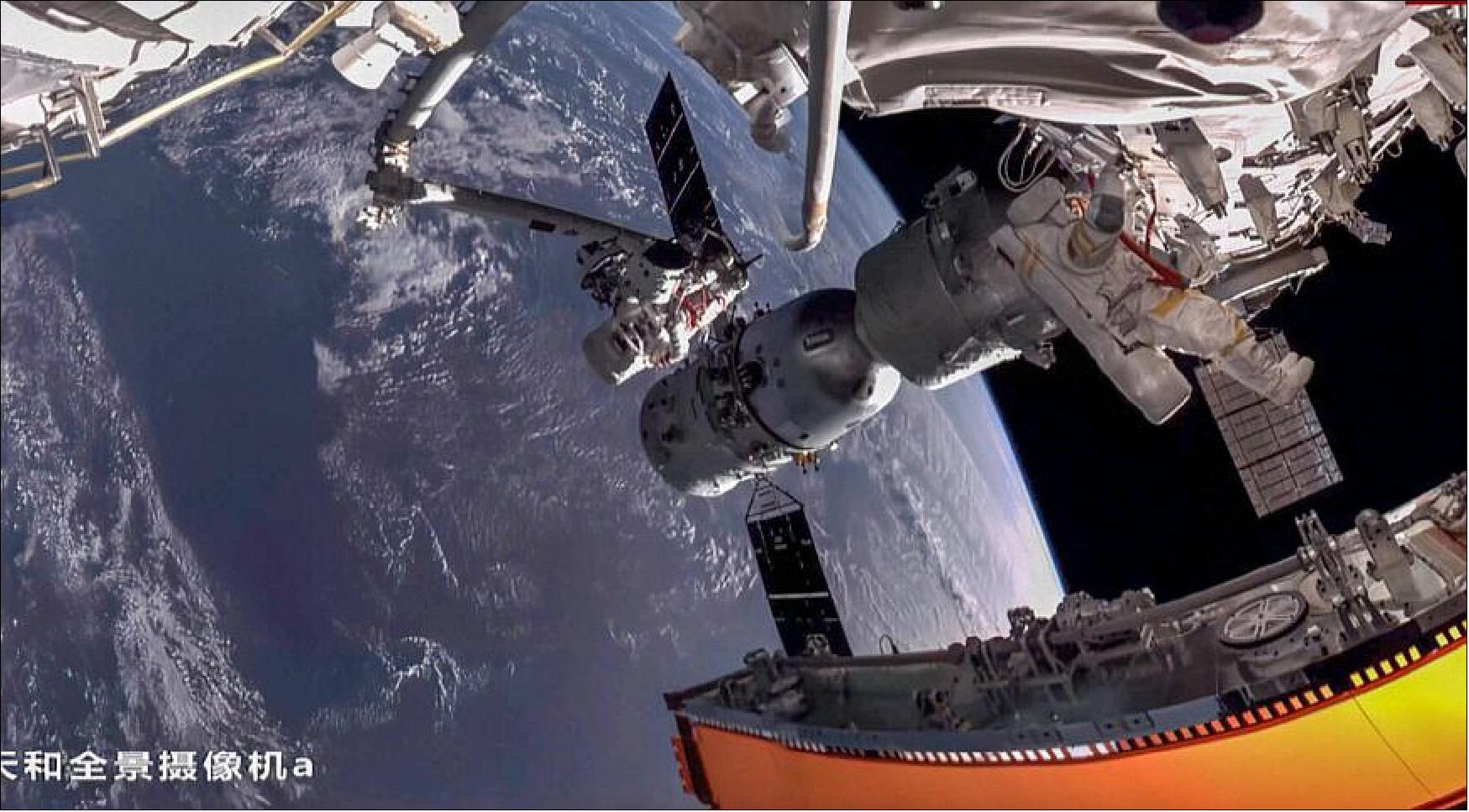
- A Long March 5B heavy-lift rocket will launch the roughly 22-ton Wentian experiment module around 02:20 a.m. EDT (06:20 UTC) July 24, according to recently announced area clearance notices consistent with such a launch.
- The 53.7-meter-long, 837.5 metric ton rocket will be rolled out to the pad at Wenchang in the coming days.
- Wentian is expected to rendezvous and join Tianhe, the similarly-sized core module for the Tiangong space station which launched in April 2021. Tianhe made orbital adjustments earlier this month to prepare for the arrival of Wentian.
- The new module has a length of 17.9 meters and a maximum diameter of 4.2 meters. It features crew quarters and an airlock cabin which will become the main exit-entry point for extravehicular activities (EVAs) once active, replacing the role now played by the Tianhe docking hub.
- The new crew facilities will allow China to perform a first crew handover. This will take place when the current Shenzhou-14 crew greet three new astronauts due to fly aboard Shenzhou-15 in December. Tiangong will then host six astronauts for a period of days.
- Its main role is hosting experiment racks for science experiments, while also providing backups to the life support and control functions of Tianhe. Wentian carries a five-meter-long robotic arm, supplemental to the 10-meter-long Tianhe arm. The two arms can also join together.
- Wentian will also come with 30-meter-long solar arrays, boosting the power available to Tiangong. Wentian will host a new round of live science lectures, following on from those presented by the Shenzhou-13 crew aboard Tianhe.
- “Wentian is a critical stage in the building of China’s space station,” says Brian Harvey, author of China in Space: The Great Leap Forward. “The Tianhe crew has overseen numerous undockings and redockings, so such maneuvers are well practiced, but nothing can be taken for granted, especially for the first time.”
- The Shenzhou-14 astronauts aboard Tianhe have been undergoing a training program including rendezvous and docking operations and using Tianhe’s mechanical arm in preparation for the arrival of Wentian.
- Tianzhou-2, a cargo craft initially charged to deliver supplies to Tianhe for the first crew, Shenzhou-12, was used early this year for a transposition test to verify procedures for moving a module from the forward docking port and towards a lateral port.
- Tianhe has so far been visited by three separate three-person crews. The most recent, Shenzhou-14, arrived on June 5 and will oversee the arrival of Wentian and Mengtian, another 22-ton experiment module scheduled for launch in October.
- The arrival of the latter will complete the planned T-shaped Tiangong space station, though China has suggested it could later expand the complex to six modules.
- “The real work of the station, which we can expect to fly into the 2040s, will begin,” Harvey says, once Mengtian is docked in position.
- The Chinese space station was first envisioned in 1992 with the approval of Project 921 which called for the development of human spaceflight capabilities. The project suffered delays due to issues with development and performance of the Long March 5B, but could also be expanded to six modules and most commercial and tourist missions.
- The country also plans to launch a co-orbiting optical telescope module, named Xuntian, in late 2023. It will be capable of docking with Tianhe for repairs, maintenance, refueling and upgrades, and aims to survey 40 percent of the sky across a decade.
- Xuntian features a two-meter-diameter aperture and a field of view more than 300 times greater than the 32-year-old Hubble Space Telescope. NASA plans a new survey mission, the Nancy Grace Roman Space Telescope, around 2027.
• May 31, 2022: A Long March 5B rocket has arrived at Wenchang spaceport as China gears up to send its second space station module into orbit. 4)
- The components of the third Long March 5B heavy-lift rocket arrived at Wenchang May 29, the China Manned Space Engineering Office (CMSEO) announced (in Chinese).
- The launcher components were manufactured and tested in Tianjin, north China, and shipped to Wenchang, on the coast of the south island province of Hainan via specially constructed cargo vessels.
- Assembly and testing of the launch vehicle is underway. The completed 849-metric-ton, 53.7-meter-long Long March 5B, which consists of a cryogenic core stage, four liquid boosters and an elongated payload fairing, is unofficially expected to launch around July 23.
- The mission aims to send the roughly 22-ton Wentian experiment module into orbit to join Tianhe, the similarly-sized core module for the Tiangong space station which launched in April 2021.
- The 17.9-meter-long Wentian (“Quest for the Heavens”) module will dock with the forward port of Tianhe, which is currently in a 387 by 386 km orbit inclined by 41.5 degrees.
- Three Shenzhou-14 astronauts—due to launch from Jiuquan around 10.40 p.m. Saturday, June 4 Eastern—will be aboard Tianhe for the arrival of Wentian and will cooperate with ground control to transpose the new module to a radial docking port using a large robotic arm.
- If successful, Wentian would be the second of three modules for the T-shaped Tiangong space station, with the final piece, Mengtian, scheduled for launch in October.
- The Chinese space station was first envisioned in 1992 when China approved its Project 921 to develop human spaceflight capabilities. The project suffered delays due to issues with development and performance of the Long March 5B, but could also be expanded to six modules and most commercial and tourist missions.
- Wentian features a new airlock for extravehicular activities, a small robotic arm which can work with the larger arm on Tianhe, and additional living quarters that will allow crew handovers.
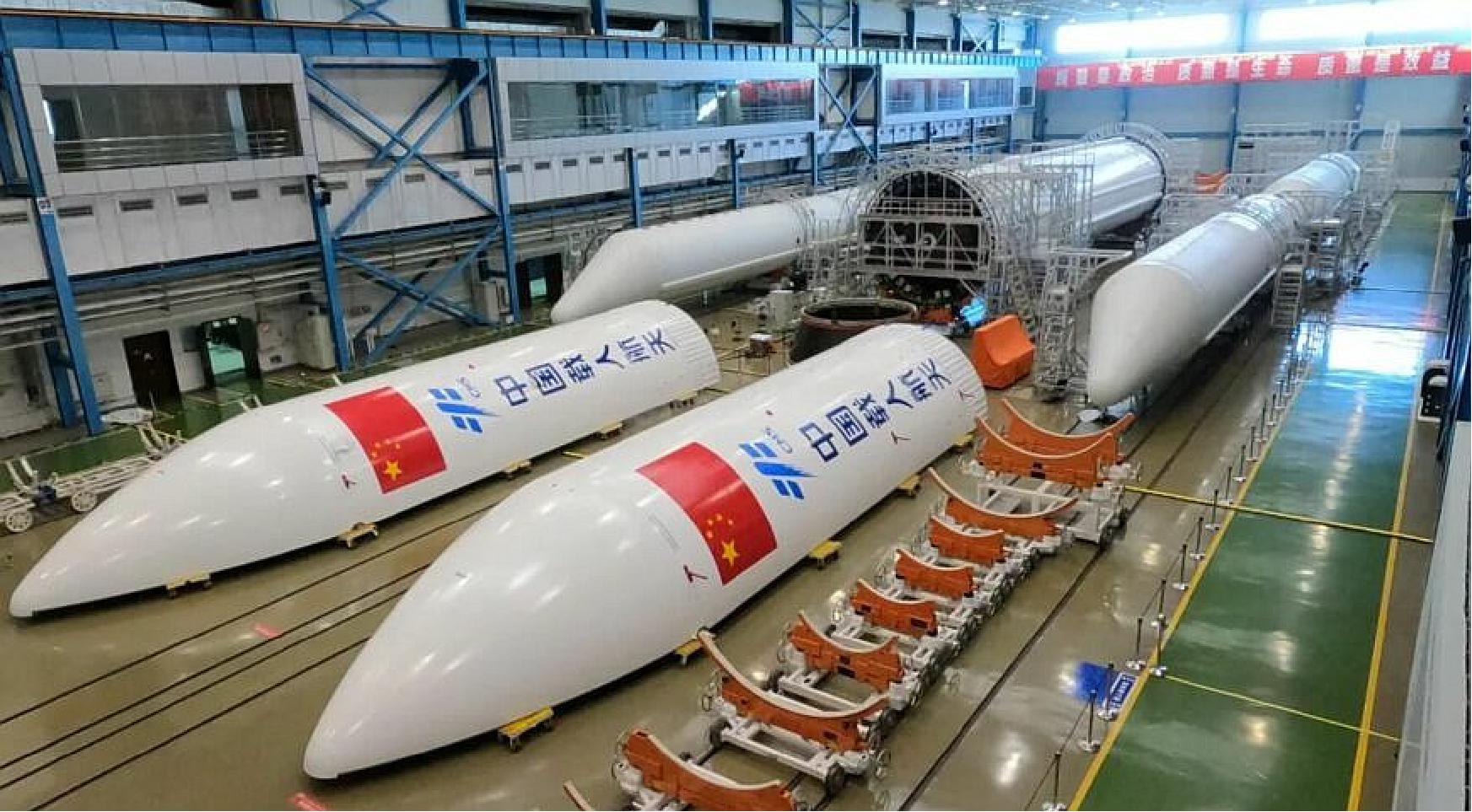
- The first crew handover will take place when the Shenzhou-14 crew greet Shenzhou-15, which is expected to launch in December. Tiangong will then host six astronauts for a period of days.
- The new airlock cabin in Wentian will become the main exit-entry point for extravehicular activities (EVAs) once active.
- Wentian will also come with 30-meter-long solar arrays, boosting the power available to Tiangong.
- Another notable aspect to the mission will be the fate of the roughly 30-meter-long, 21-metric-ton Long March 5B first stage. The core stage also acts as the upper stage, meaning it reaches orbital velocity, rather than falling into a predetermined area on a ballistic trajectory as is most often the case with first stages.
- The first two Long March 5B first stages made uncontrolled reentries, gaining widespread public attention.
- Two further Long March 5B launches are expected in 2022 and 2023, to launch the Mengtian module and the Xuntian co-orbiting space telescope, respectively.
• March 19, 2022: China plans to conduct a number of frontier scientific experiments on its Tiangong space station, with the two laboratory modules, Wentian and Mengtian, scheduled to be launched this year, according to the Technology and Engineering Center for Space Utilization (CSU) under the Chinese Academy of Sciences (CAS). 5)
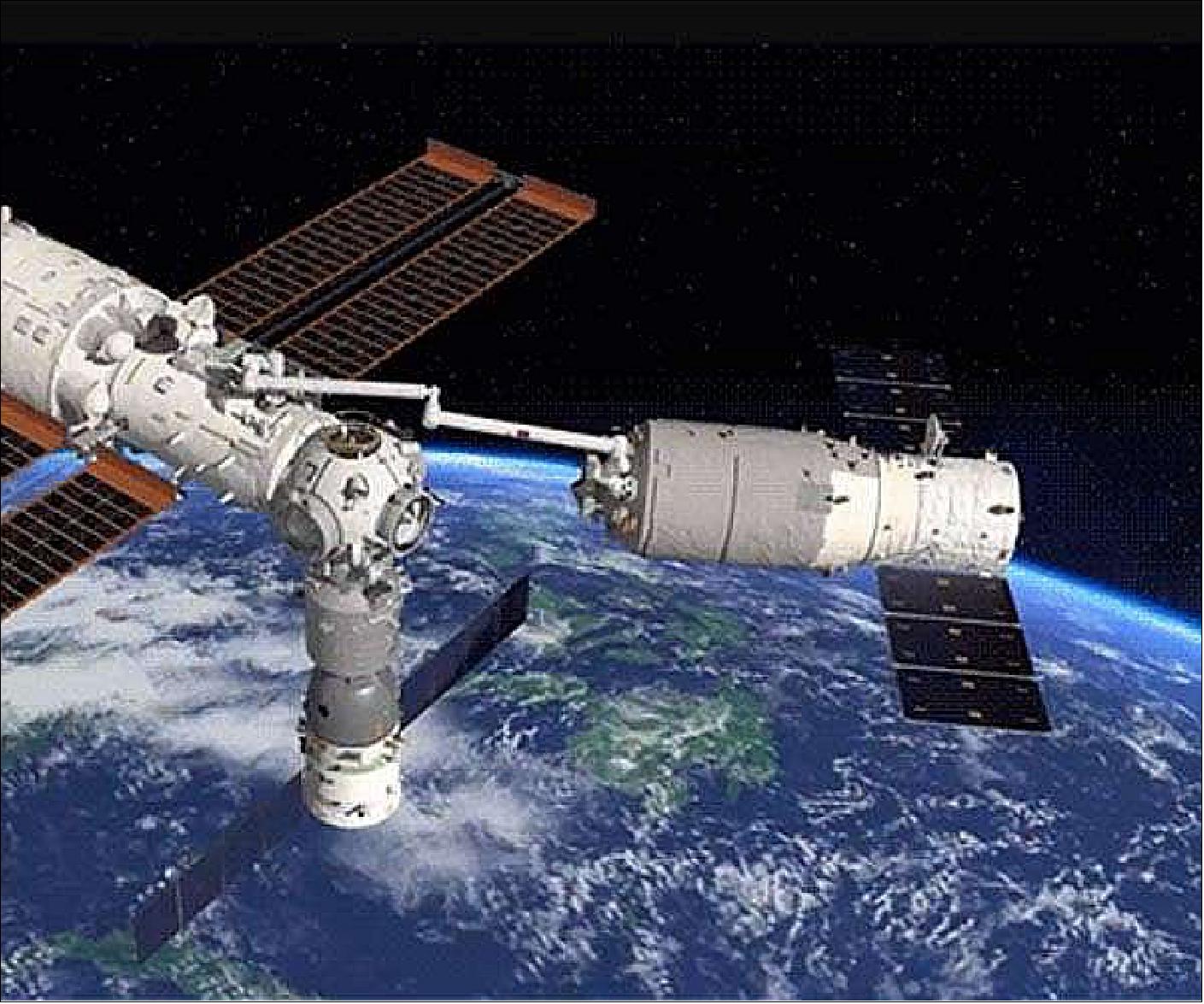
- The experiments include raising fish, growing vegetables, setting up the most precise clocks in space, developing new materials, studying physical laws and exploring how humans can survive in space for long periods.
- The scientific experiment facilities to be installed in the two lab modules are currently under development and will be launched into orbit on schedule to support large-scale and multidisciplinary scientific research, said the CSU.
- The scientific work will make use of experiment racks that can hold a variety of technical hardware and materials, allowing astronauts to upgrade and replace the facilities over time.
- Testing work has begun on the experiment racks that are already installed in the Tianhe core module, which was launched last year, and these will be used for container-free material science and high microgravity experiments, said Zhang Wei, director of the Utilization Development Center of CSU.
- Additional experiment racks will be included in the two lab modules, which will support a large number of research projects in fields such as space life, fluids, space materials, fundamental physics and combustion, together with the extravehicular experiment platform, Zhang said.
- More than 10 life-science experiments on plants, animals and microbial cells will be carried out in the Wentian lab module, including a small closed ecosystem composed of small fish, microorganisms and algae, according to Zhang.
- Scientists are also planning to establish the world's first space-based cold atomic clock system in the Mengtian lab module, consisting of a hydrogen clock, a rubidium clock and an optical clock.
- "If successful, the cold atomic clocks will form the most precise time and frequency system in space, which should not lose one second in hundreds of millions of years," said Zhang.
- The world's first ever cold atomic clock that operates in space was made by Chinese scientists. It was launched with the Tiangong-2 space lab in 2016, and has a margin of error of less than one second in 30 million years.
- Now, in ground-based experiments, Chinese scientists have developed cold atomic clocks that are far more accurate than the Tiangong 2 version, according to Zhang.
- The development of space cold atomic clock technology will contribute to higher-precision satellite positioning and navigation, and support fundamental physics research such as dark matter probes and gravitational wave detection, scientists say.
- China is conducting long-term and systematic planning for space experiments in four important areas: space life-sciences and human research, microgravity physical science, space astronomy and earth science, and new space technologies and applications, said Gao Ming, director of the CSU and general director of the space application system of China's manned space program, adding that a number of scientific research facilities have been developed to support more than 1,000 in-orbit research projects.
- China is also building a ground experiment base in Huairou Science City in the northeastern suburbs of Beijing to provide experimental conditions similar to those of the space station so as to conduct ground verification for the space station program, and to support space-earth comparison experiments, Zhang said.
- In addition, China has been active in international space-station cooperation, including working with the European Space Agency on 10 projects.
- China also cooperates with the United Nations Office for Outer Space Affairs to solicit scientific research projects on the space station from scientists around the world, and nine projects have been selected.
• June 15, 2021: The first crew for China's new space station prepared to blast off this week for the latest step in Beijing's ambitious program to establish itself as a space power. 6)
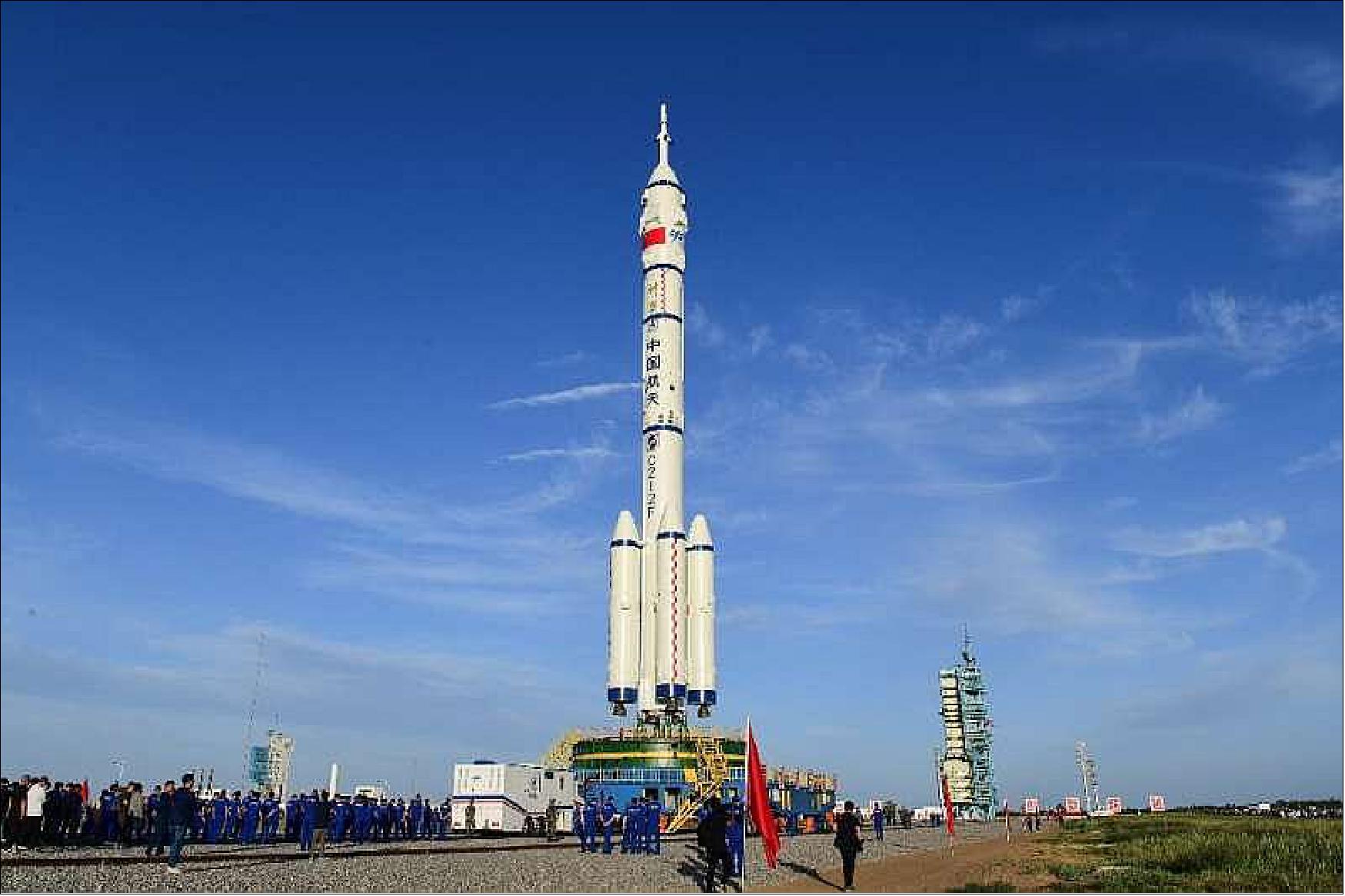
- The mission is China's first crewed spaceflight in nearly five years, and a matter of prestige for the government as it prepares to mark the 100th birthday of the ruling Communist Party on July 1 with a propaganda blitz.
- A Long March-2F rocket carrying three astronauts in the Shenzhou-12 spacecraft is slated to lift off from a base in northwest China's Gobi desert on Thursday, according to experts with knowledge of the matter.
- They plan to spend three months on the Tiangong station, China's longest crewed space mission to date, with spacewalks among their tasks.
- The astronauts will aim to "get their new home in space kitted out and ready to use," said Jonathan McDowell, an astronomer at the Harvard Smithsonian Center for Astrophysics. - "It's a practical goal rather than a groundbreaking one."
- The Long March rocket, with the Shenzhou craft attached, was moved to the launch pad at the Jiuquan Satellite Launch Center last week, according to the Chinese space agency.
- Shenzhou-12 will dock with the main section of the Tiangong station, named Tianhe, which was placed in orbit on April 29. A cargo craft last month transported fuel, food and equipment for the crewed mission.
- Another 11 missions are planned over the next year and a half to complete the construction of Tiangong in orbit, including the attachment of solar panels and two laboratory modules.
- Three of those missions will carry astronauts for crew rotation.
- "Keeping the station up and running smoothly involves much detailed and complicated work, as we saw on the International Space Station during its early days," said Chen Lan, an analyst at GoTaikonauts, which specializes in China's space program.
- Once completed, Tiangong will have a mass of around 90 tons and is expected to have at least a 10-year lifespan, according to the Chinese space agency.
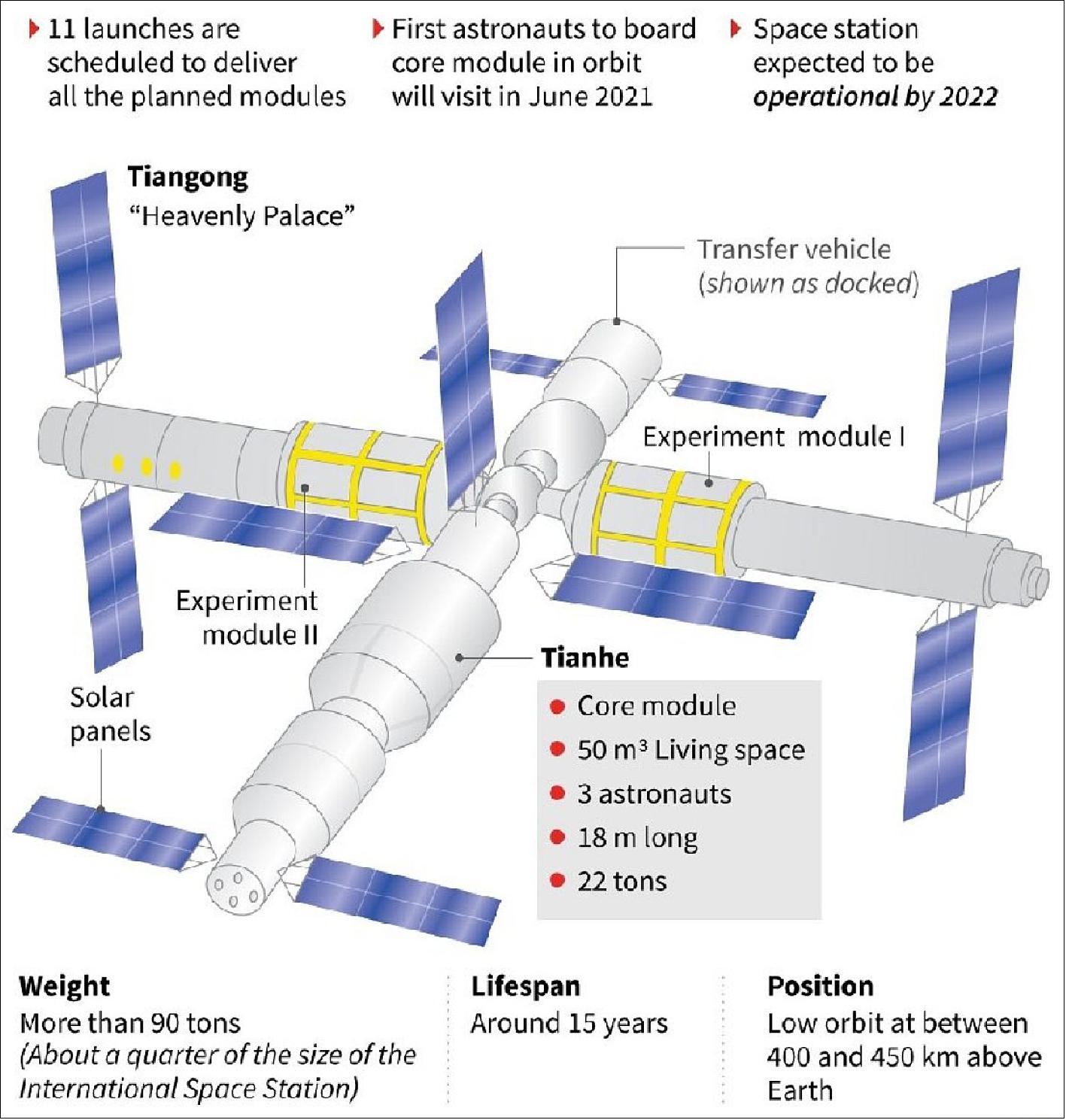
• April 30, 2021: Commercial enterprises will have opportunities to take part in the construction and operation of the nation's space station, according to a senior space official. 7)
- Hao Chun, head of the China Manned Space Agency, told China Daily in an interview earlier this month that his agency, which administers the space station program, will take advantage of private space companies' technologies and capabilities to help State-owned contractors build and maintain the station.
- "Actually, we have already started inviting private companies to offer their solutions to us. For instance, we invited bids for new concepts of cargo transportation to our space station and then received proposals from more than 10 private enterprises," Hao said. "Next, we will review those proposals and select and support the good ones."
- If the selected companies prove to be competent and qualified, the agency will consider commissioning them to fulfill cargo transportation missions for the station, according to him.
- Currently, China has only one type of cargo spaceship-the Tianzhou, which was developed by State-owned space giant China Aerospace Science and Technology Corp. Tianzhou 1 performed resupply and refueling tests with the Tiangong II space laboratory in 2017, while Tianzhou 2 is scheduled to be launched in the coming months to dock with the core capsule of the space station.
- "The participation of commercial space enterprises will give us greater flexibility and offer us more convenience in terms of the operation and maintenance of the space station, and it will also help us reduce our overall costs," Hao said, also suggesting that private companies should understand the space station program's demands and look into available opportunities to make the best use of their expertise.
- The official also said that the rapidly expanding commercial space sector will become a major driving force for China's space industry.
- In the wake of the intensifying contest in the global space arena, China has realized that it is necessary to introduce new players to stimulate innovation and competition and to fill in market gaps left by established contractors.
- As an important part of his endeavor to strengthen China's space industry, President Xi Jinping has requested that the long sheltered industry open its doors to private enterprises and capitalize on their participation to boost sustainable growth.
- Meanwhile, several government departments have published policies and guidelines that encourage private enterprises to take part in space-related businesses.
- Due to the government's support and thriving business demands, dozens of domestic private space companies have emerged and obtained some market share in the carrier rocket and satellite industries.
• April 23, 2021: China is set to launch the first module for its own space station next week after rolling out a Long March 5B rocket at Wenchang spaceport late Thursday. 8)
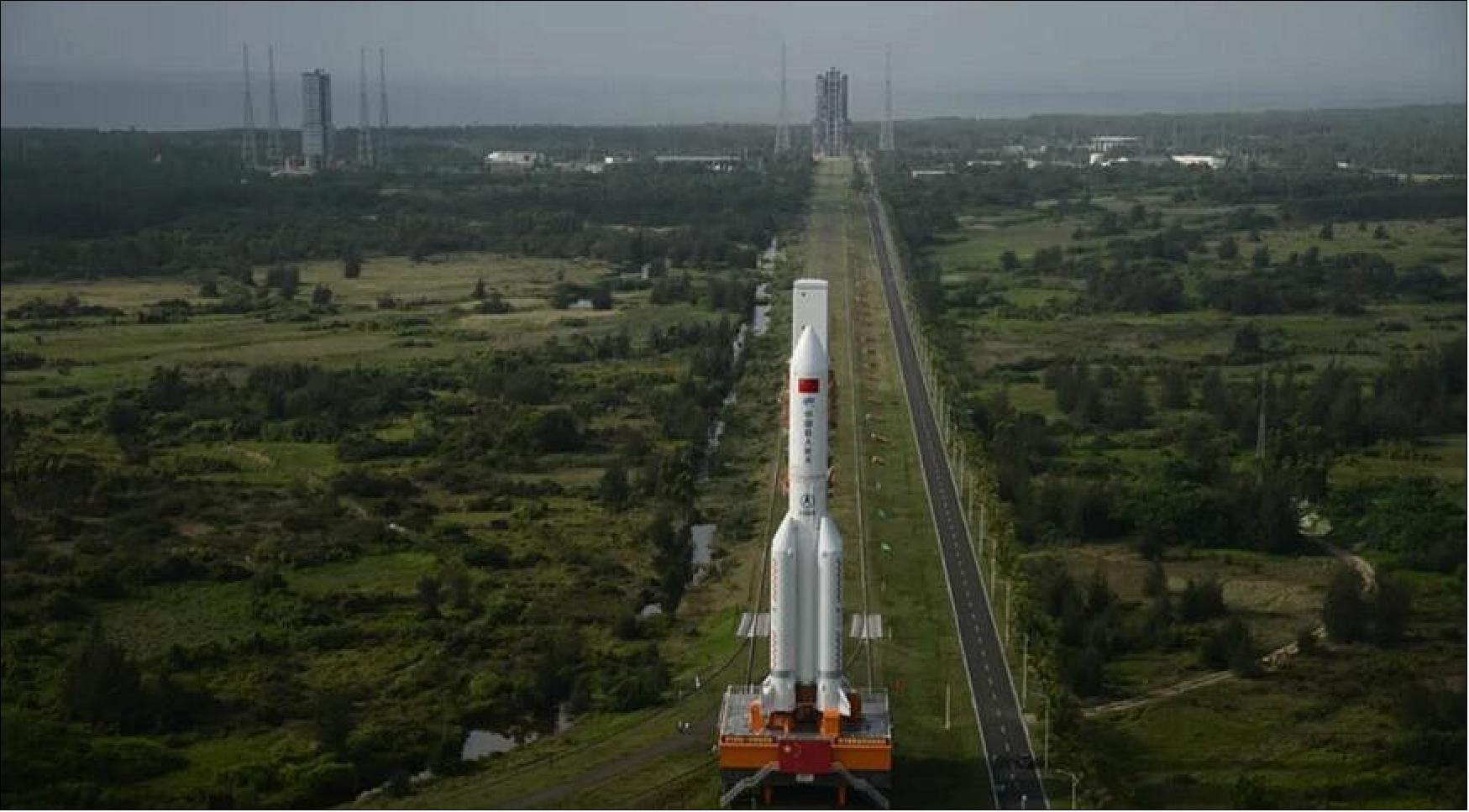
- The 53.7-meter-long Long March 5B is now expected to launch the 22-ton Tianhe space station core module around April 29, although authorities have not officially released a launch time.
- The launch will mark the beginning of an intense construction phase for the three-module space station. China plans 11 major launches of modules, cargo and crewed spacecraft across 2021-22.
- The Chinese space station was first envisioned in 1992 when China approved its Project 921 to develop human spaceflight capabilities. China sent its first astronaut, Yang Liwei, into orbit in October 2003.
- The Long March 5B was transferred to the launch area early Friday local time. The rocket was transferred from a vertical integration building via a 2.7-kilometer track, with the transfer process taking about two and a half hours.
- Encased in the payload fairing atop the rocket is the 16.6-meter-long, 4.2-meter-diameter Tianhe core module along with a docking hub. Tianhe and the Long March 5B arrived at Wenchang in February for assembly and integration.
- Tianhe, meaning “harmony of the heavens”, is planned to be inserted directly into a low Earth orbit with an apogee of around 370 kilometers and inclined by 41 degrees.
- The three-module, 66-metric-ton space station will host three astronauts for six month rotations. Planned experiments include international projects in the areas of astronomy, space medicine, space life science, biotechnology, microgravity fluid physics, microgravity combustion and space technologies.
- The Tianhe module will provide regenerative life support and living space for three astronauts as well as propulsion to maintain the orbit of the entire complex.
![Figure 9: The Tianhe core module and docking hub of the Chinese Space Station [image credit: CMSA (China Manned Space Agency)]](https://www.eoportal.org/ftp/satellite-missions/c/CSS_250722/CSS_Auto24.jpeg)
• September 11, 2019: The first module for China’s planned space station has passed a final review, but the project continues to suffer launch vehicle-related delays. 9)
- The China Manned Space Agency (CMSA) announced Sept. 6 that the 20-metric-ton ‘Tianhe’ module design and prototype had passed final reviews Sept. 2. The flight model would be manufactured in the near future.
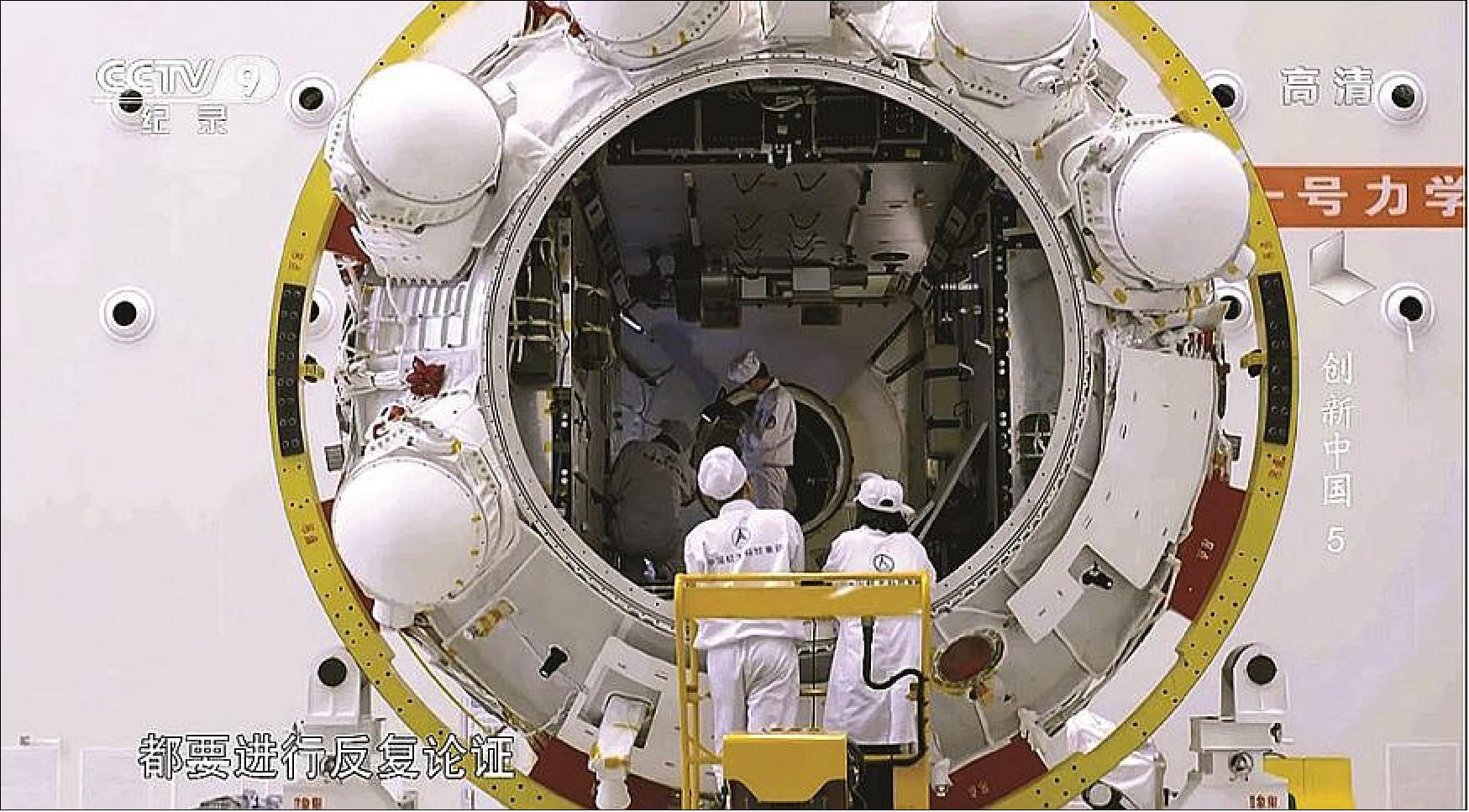
- Tianhe (‘Harmony of the Heavens’) is the core module for the Chinese Space Station (CSS) and will control the station’s orbit and attitude and function as the main astronaut quarters.
- When Tianhe will launch is still unknown. According to previous official statements the first of three modules for the space station was to be launched in 2020, with the complex to be completed by ‘around 2022’.
- The ‘around 2022’ time frame had not changed despite ongoing delays in readying the launch vehicle required for the project, suggesting a more compressed schedule.
- The timeline for completion has however now shifted to ‘2022-2024’, according to Faren Qi, chief designer of the Shenzhou spacecraft which has facilitated China’s human spaceflight missions.
- Qi provided media with the new timeline at a satellite navigation and location services conference in Zhengzhou, Henan Province, Sept. 10.
- Qi added that the first flight of the CSS project would be the test launch of the Long March 5B, now expected in the first half of 2020. If successful, that launch would clear the way for launch of the Tianhe module.
- The Long March 5B test flight will carry an uncrewed version of a next generation spacecraft for human spaceflight. The successor to the 7.8-metric-ton Shenzhou will feature partial reusability and have a maximum launch mass of around 23 tons.
- Qi stated that the new spacecraft would be modular in design and versatile in order to meet the demands of Chinese space development. The 9-meter-long, two-module spacecraft will be capable of missions beyond low Earth orbit, including lunar and deep space missions.
- This and other major missions have however been delayed due to problems with China’s Long March 5 heavy-lift rocket.
Launch of the Tiangong Modules
• Launch: China’s heavy-lift Long March 5B rocket launched Sunday, 24 July 2022, with the second major element of the Chinese Tiangong space station, sending the 25-ton Wentian science module on course for docking at the orbiting outpost. 10)
- The Wentian lab module was buttoned up in the nose cone of the Long March 5B rocket when it lifted off at 2:22:32 a.m. EDT (06:22:32 GMT) Sunday from the Wenchang space center on Hainan Island, China’s southernmost province.
- The launch marked the eighth flight of a Long March 5 rocket, the most powerful launcher in China’s inventory. It was the third flight of the Long March 5B configuration, which flies without an upper stage and is tailored to haul heavy payloads into low Earth orbit. The Long March 5B launcher’s lift capability to low Earth orbit is around 55,000 pounds, or 25 metric tons.
- The 53.7-meter tall Long March 5B rocket was loaded with kerosene fuel for its strap-on boosters and cryogenic liquid hydrogen fuel for its core stage in the final hours before liftoff Sunday. The boosters and core stage also consumed super-cold liquid oxygen in combination with the liquid fuel to power the Long March 5B off its seaside launch pad at Wenchang.
- Gantry arms on the Long March 5B’s 92-meter launch pad tower opened in the final phase of the countdown, clearing the way for the heavy-lifter to take off from Wenchang and head east over the South China Sea.
- The ten engines pushed the Long March 5B rocket into the sky with 2.4 million pounds of thrust.
- The four boosters cut off and jettisoned about three minutes into the mission, and the core stage burned all its propellant about eight minutes after liftoff, before releasing the Wentian lab module for the rest of the journey to the Tiangong space station.
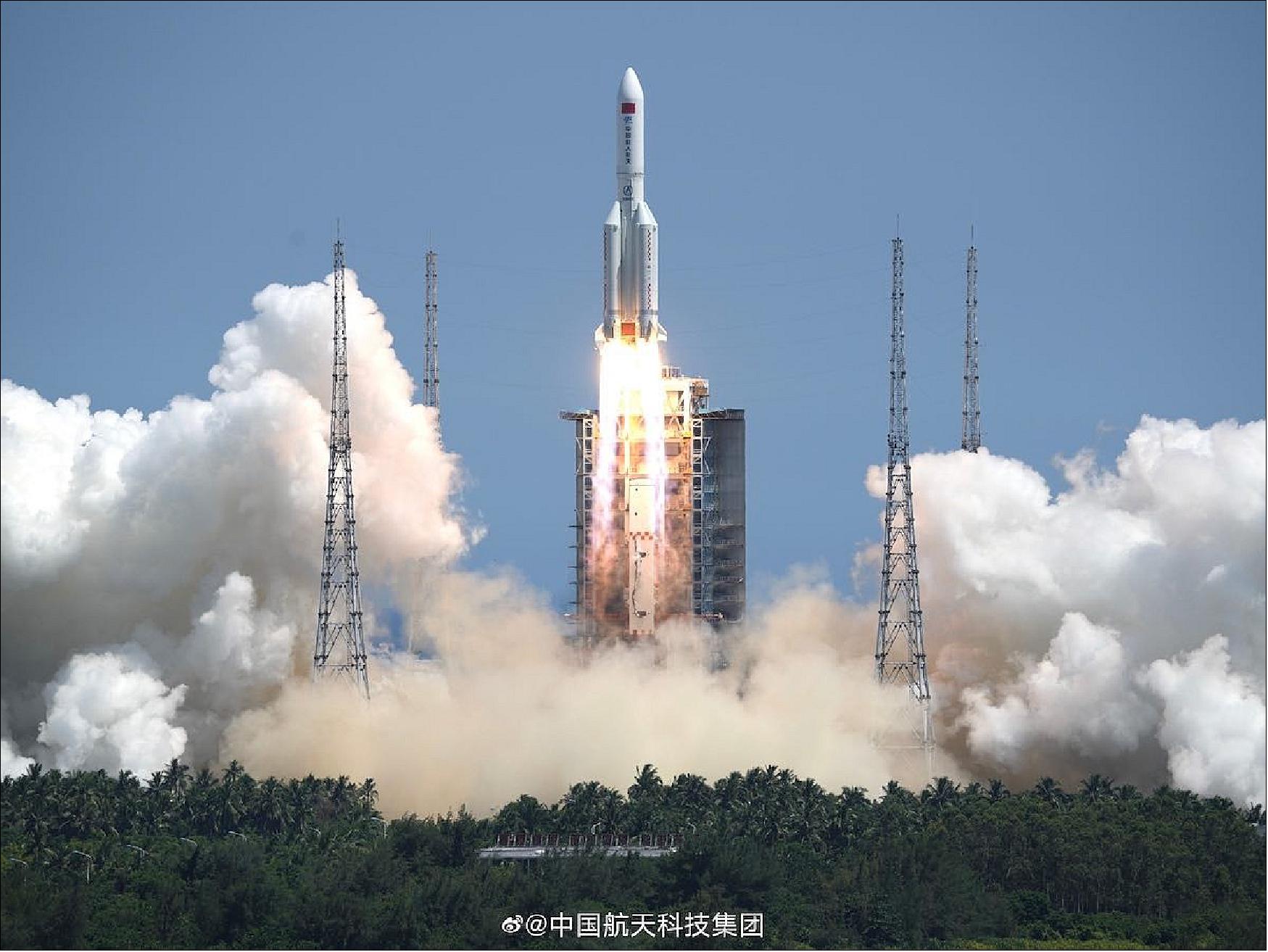
- The Wentian module, measuring about 17.9 meters long, is fitted with mounting platforms to host science instruments and unpressurized experiments in the vacuum of space.
- There are accommodations for life science and biological research racks inside the module’s pressurized volume, and the new module will add an airlock to support spacewalks outside the Tiangong space station.
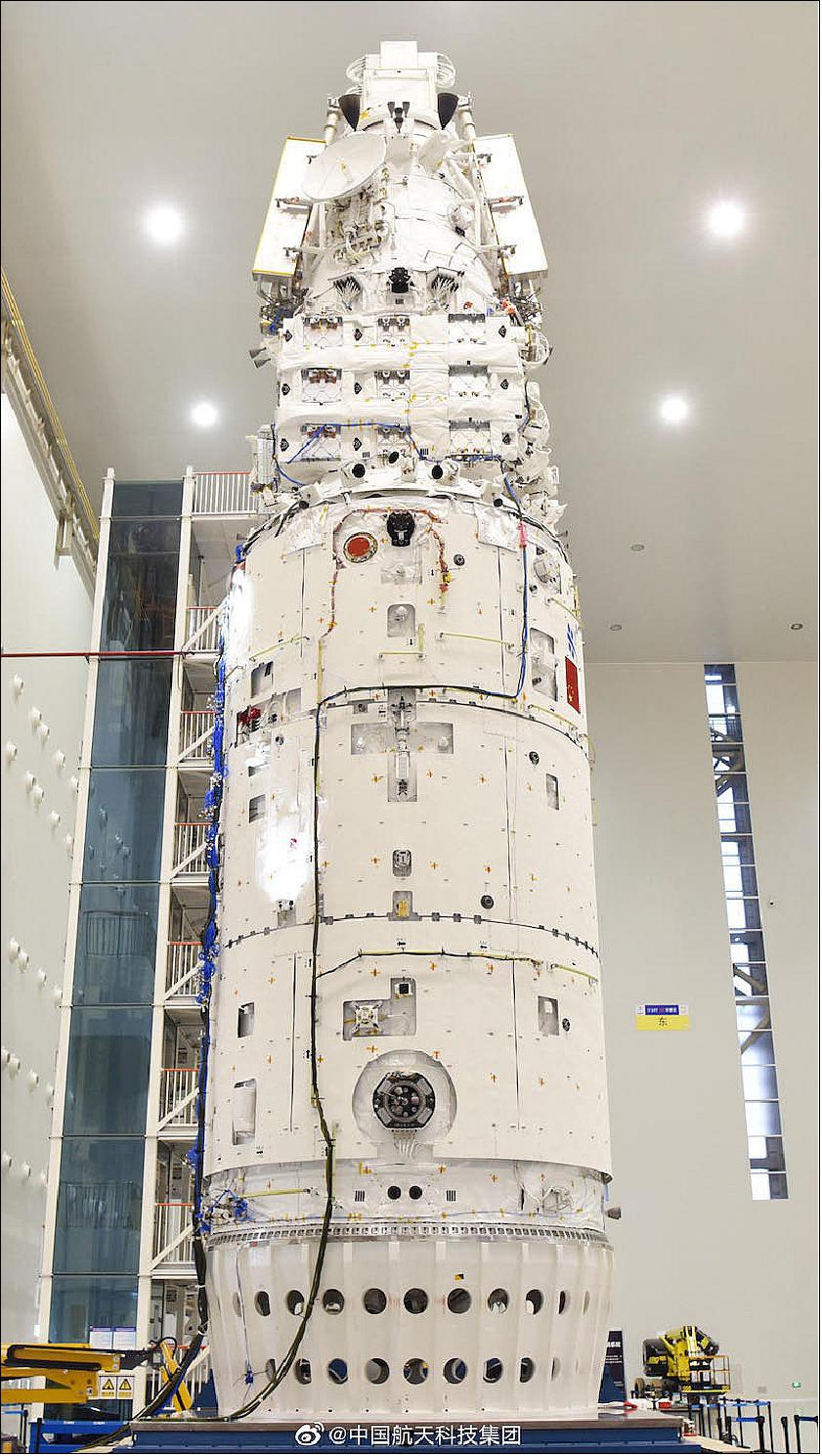
- The Wentian module, with a launch mass near 50,000 pounds (23 metric tons), will dock with the Tianhe core module on China’s Tiangong station in low Earth orbit later Sunday. Chinese astronauts Chen Dong, Liu Yang, and Cai Xuzhe living on the Tiangong complex will monitor Wentian’s arrival, then become the first crew members to float into the station’s new module.
- The massive Wentian module will unfurl solar panels to a span of about 180 feet (55 meters) tip-to-tip to produce its own electricity.
- The arrival of the Wentian science lab will add the second of three large pressurized modules needed to complete the initial construction of the Tiangong station. The Tianhe core module launched on a Long March 5B rocket in April 2021, and Chinese ground teams are preparing the Mengtian module for launch on a Long March 5B rocket in October.
- The Wentian module carries a small robotic arm designed for more precise movements than the larger arm positioned outside the Tianhe core module. Wentian’s arm will primarily be used to transfer experiments and other hardware outside the station.
- Wentian, which means “quest for the heavens,” will initially dock with an axial port on the Tianhe module, a docking mechanism that was recently cleared by the departure of a no-longer-needed Tianzhou cargo ship. Tianhe’s mechanical arm will move the module to its final position on the side of the space station’s core section.
- The Mengtian module scheduled for launch later this year will arrive at the Tiangong space station in a similar way. Once Wentian and Mengtian are in their final positions, the Chinese station will have a distinctive “T” shape with its three main pressurized elements.
- The crew on the complex will stage two or three spacewalks from the Wentian module in the next few months.
- “The Wentian experimental cabin is mainly for space life science research, equipped with experimental cabinets such as life ecology, biotechnology, and variable gravity science,” said Lin Xiqiang, deputy director of the China Manned Space Agency, in a press briefing last month.
- Wentian’s experiments will support research into genetics, aging, organs, tissues, and cells. The variable gravity experiment rack can generate accelerations between a hundredth the pull of Earth’s gravity up to 2g, supporting comparative studies under different gravity conditions, according to the China Manned Space Agency.
The Chinese space station orbits about 236 miles (380 km) above Earth, at an inclination of 41.5 degrees to the equator. The orbit means the spent Long March 5B core stage could come down anywhere between 41.5 degrees north and south latitude.
Launch: China successfully launched a 22-metric-ton module Tianhe on 29 April 2021 at 03:23 UTC (11:23 p.m. EDT on 28 April (Wednesday), beginning an intense period of missions for constructing the nation’s own space station. 11)
Orbit: The CSS will be operated in LEO at an altitude between 340 and 450 km with an inclination of ~42º.
A Long March 5B heavy-lift rocket lifted off from the coastal Wenchang spaceport. The Tianhe space station core module separated from the first stage after 490 seconds of flight.
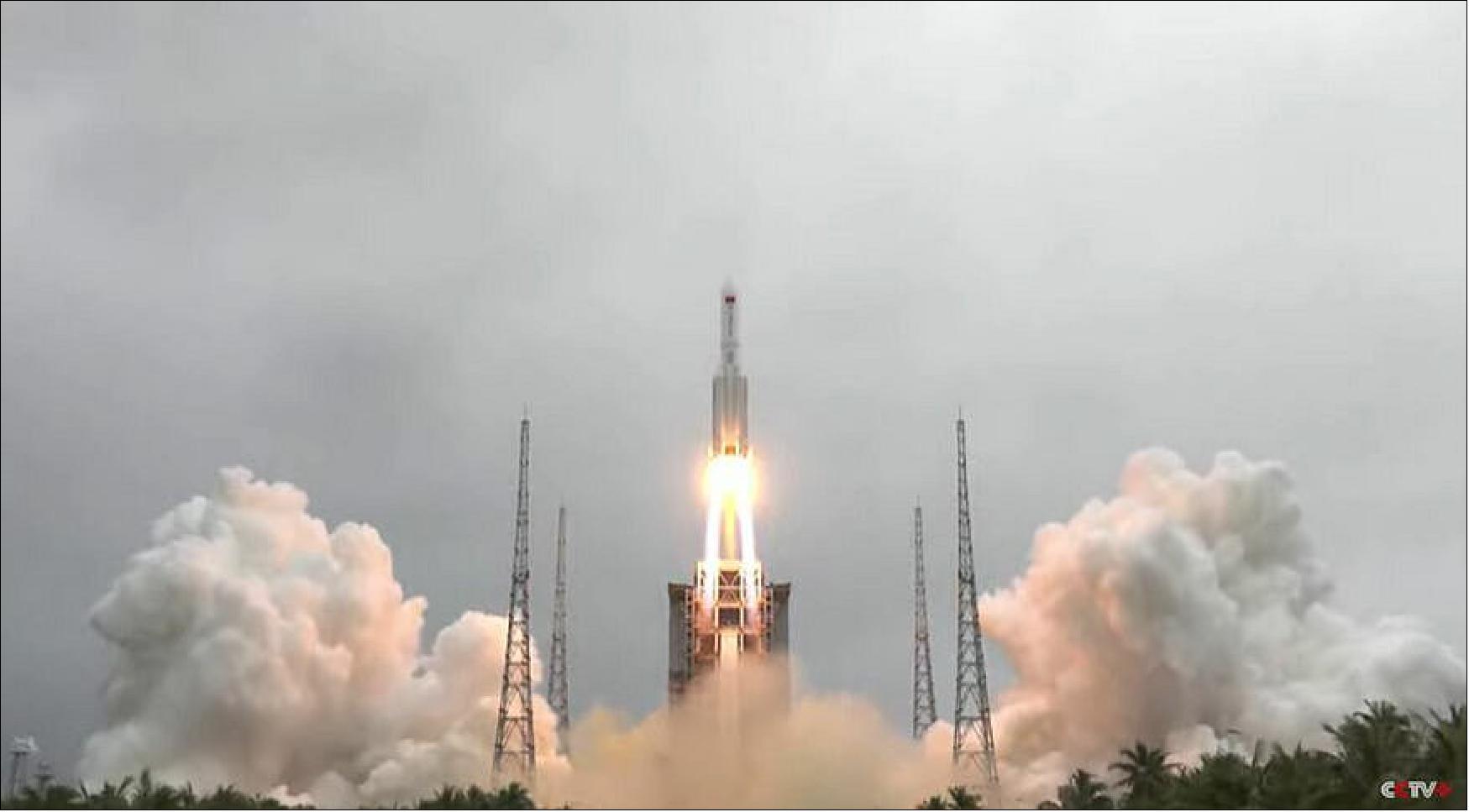
Solar array deployment occurred just over an hour after launch. Shangfu Li, chief commander of the China Manned Spaceflight Program, announced launch success shortly after.
Tianhe, or “harmony of the heavens”, is now expected to raise its orbit to around 370 kilometers above the Earth. The uncrewed Tianzhou-2 cargo spacecraft is now expected to rendezvous and dock with Tianhe in mid-late May, ahead of the visit of three astronauts aboard Shenzhou-12 in June.
Tianhe, a much larger upgrade on China’s smaller, 8-ton Tiangong testbed space labs, is equipped with a multi-docking hub to facilitate construction of the space station and allow crew to embark on extravehicular activities.
The 16.6-meter-long, 4.2-meter-diameter Tianhe will provide regenerative life support and the main living quarters for astronauts as well as propulsion to maintain orbital altitude.
The construction phase of China’s space station begins nearly 30 years after the project was first approved, back in 1992.
Across this period China has developed and tested the Shenzhou spacecraft and Long March 2F for human spaceflight, Tianlian relay satellites, rendezvous and docking technologies, refueling in microgravity, new launch vehicles and the coastal Wenchang Satellite Launch Center in order to proceed with the project.
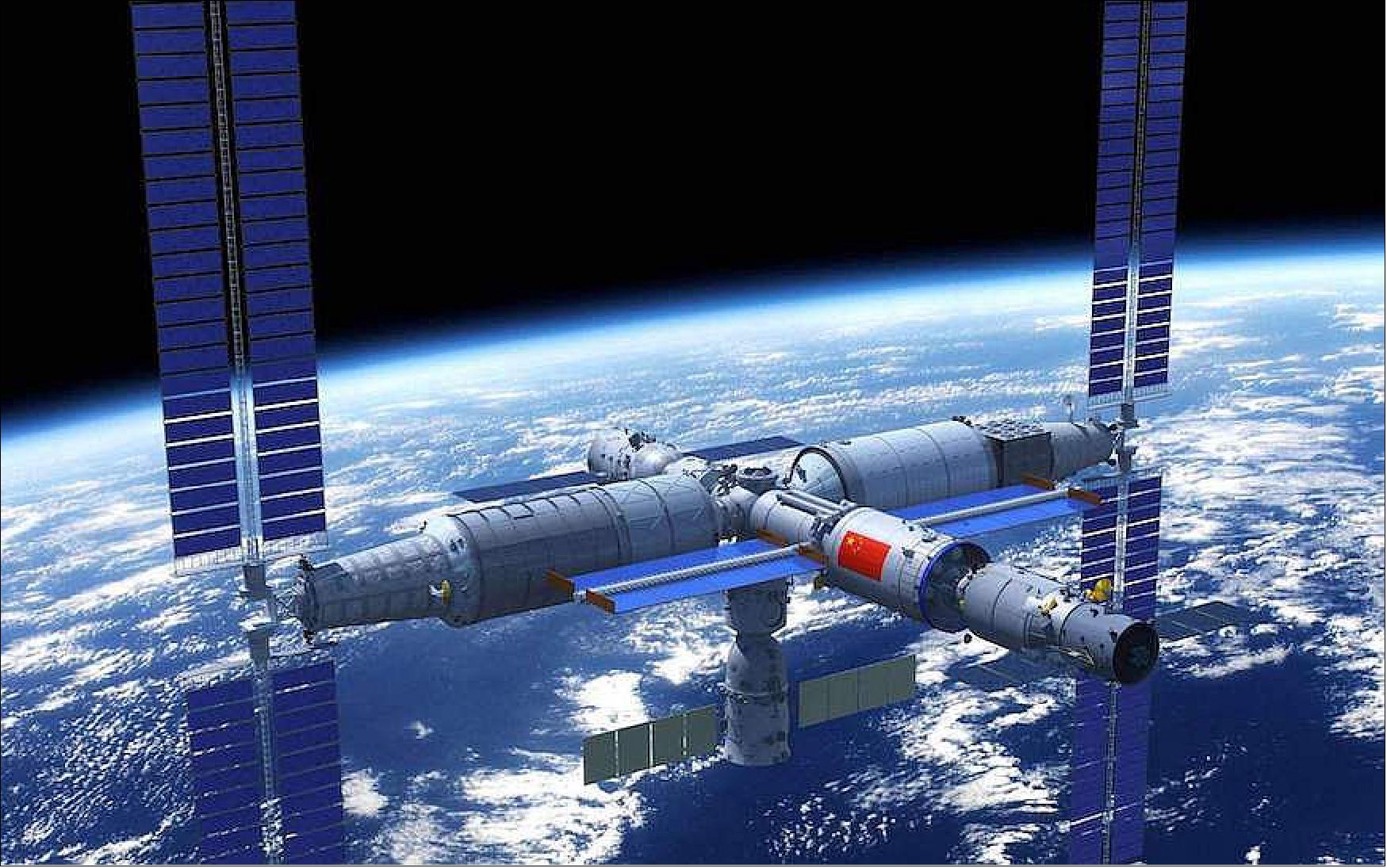
The CSS (Chinese Space Station) is expected to operate in orbit for at least ten years. Experiment modules named Wentian and Mengtian, expected to launch in 2022, will host a plethora of experiments in areas including astronomy, space medicine, space life science, biotechnology, microgravity fluid physics, microgravity combustion and space technologies.
International science payloads and experiments have also been selected for a journey to the CSS through cooperation between the United Nations Office for Outer Space Affairs (UNOOSA) and the China Manned Space Agency (CMSA).
China had expressed interest in joining the International Space Station project but membership was effectively denied by U.S. policy towards China’s space programs.
The launch of the Tianhe core module was delayed by the 2017 launch failure of the second Long March 5. The saw the postponement of the test launch of the Long March 5B variant for low Earth orbit launches while issues with the YF-77 liquid hydrogen-liquid oxygen engine for the core stage were isolated and remedied.
The CSS will also be joined in orbit by the Xuntian optical module, a co-orbiting, Hubble-class space telescope. The space telescope will have a 2-meter-aperture comparable to Hubble but feature a field of view 300 times greater, allowing 40 percent of the sky to be surveyed across a decade.
Xuntian will be capable of docking with the CSS for maintenance and repairs. The space station itself could also be expanded from three to six modules, using modules developed as backups.
Mission Status
• June 6, 2022: The crew of the Shenzhou XIV mission, China's ninth manned spaceflight, arrived at the Tiangong space station on Sunday evening, several hours after their spacecraft was launched from the Jiuquan Satellite Launch Center in the northwestern Gobi Desert. 12)
- The three astronauts-mission commander Senior Colonel Chen Dong, Senior Colonel Liu Yang and Senior Colonel Cai Xuzhe-had entered the space station's core module, Tianhe, by 8:50 pm.
- They are scheduled to stay in the outpost, orbiting 400 kilometers above the Earth, for six months to complete the assembly in space of the colossal station.
- Their Shenzhou XIV spacecraft was launched by a Long March 2F rocket that blasted off at 10:44 am from a service tower at the oasis-like Jiuquan center.
- It is the second time that Chen and Liu have gone into space, and Cai's first, making him the 14th Chinese astronaut in outer space.
- When their mission is completed, around the end of this year, the Tiangong space station will have become fully operational.
- The three astronauts' mission has inaugurated a 10-year period in which, barring unforeseen circumstances, Chinese astronauts will be in space every day.
- Shenzhou XIV is the sixth spacecraft to visit Tiangong and the third crewed ship to transport astronauts to the orbiting outpost.
- Tiangong currently consists of four sections-Tianhe, the core module; the Shenzhou XIV craft; and the Tianzhou 3 and Tianzhou 4 cargo ships.
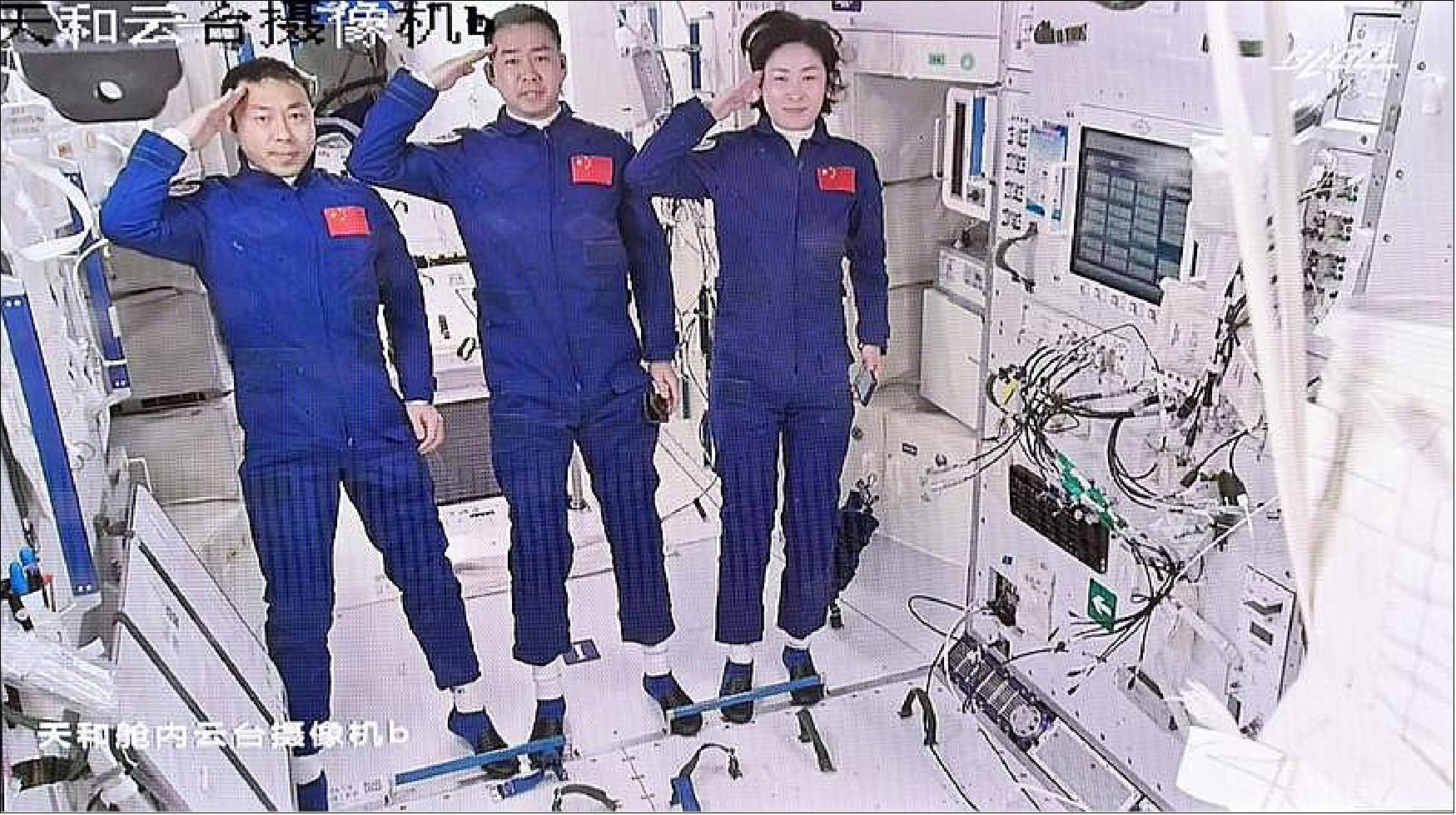
- The Shenzhou XIV crew, all from the second generation of Chinese astronauts, will work with ground controllers to connect the Wentian and Mengtian space labs with the Tianhe module and then use the robotic arm to move the labs into their permanent position, said Lin Xiqiang, deputy head of China Manned Space Agency.
- Wentian, the station's first lab component, will be launched in July by a Long March 5B rocket from the Wenchang Space Launch Center in Hainan province. Mengtian, the second lab component, will be launched by a Long March 5B from Wenchang in October.
- After they are connected with Tiangong, the station will form a T-shaped structure.
- The astronauts will also be tasked with installing and configuring equipment, conducting scientific experiments and technological demonstrations, and maintaining routine operations on Tiangong, Lin said.
- They will engage in two to three spacewalks and give science lectures to students, he said.
- In the second half of the mission, the Tianzhou 5 cargo craft and Shenzhou XV crew are scheduled to arrive at the massive space station.
- The Shenzhou XIV and XV crews will meet inside Tiangong and work together for a short period before Chen's crew returns to Earth in December, the official said.
- Previously, the Shenzhou XII and XIII three-member crews lived inside Tiangong. The Shenzhou XIII crew returned to Earth in mid-April.
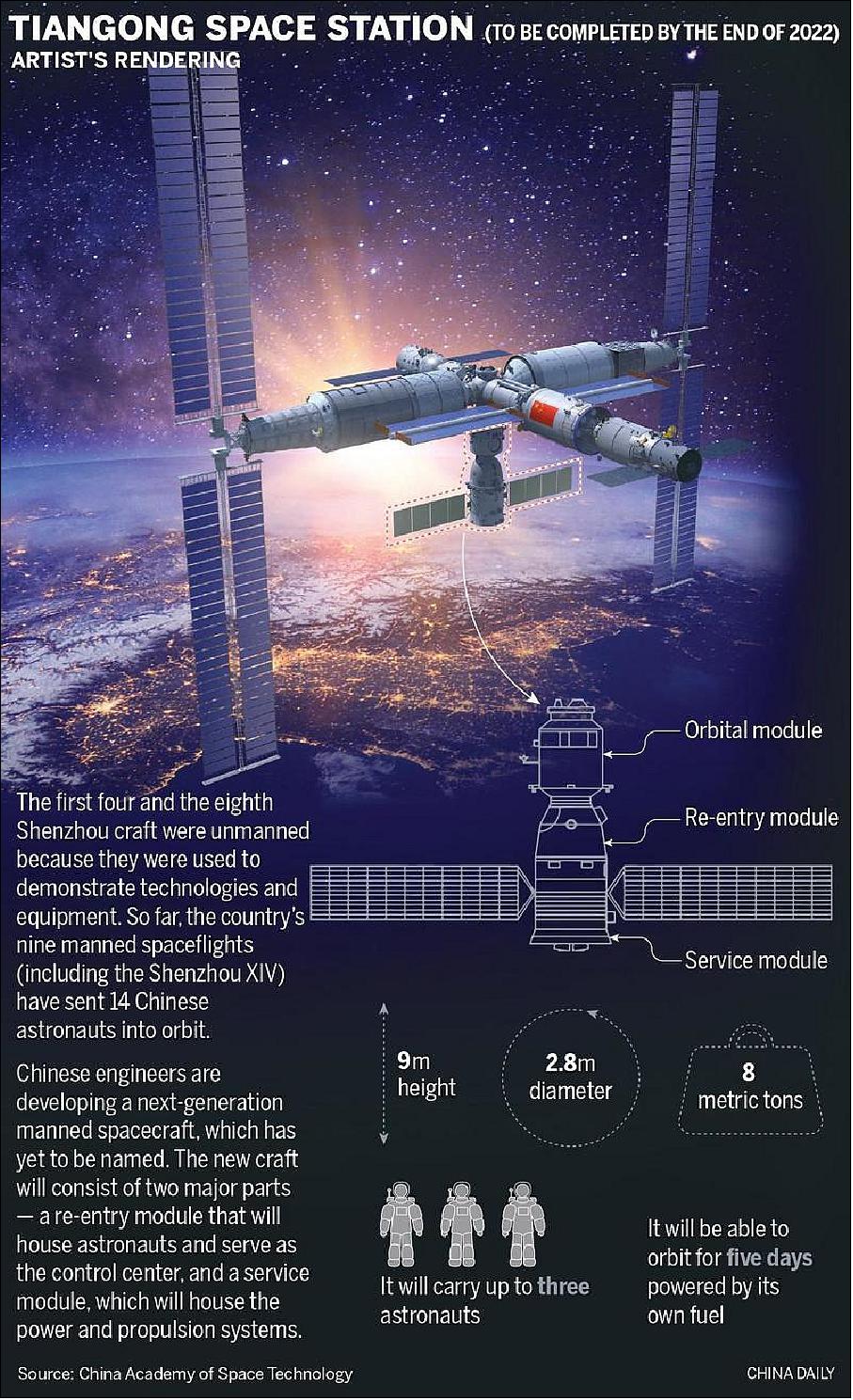
- In early May, the Tianzhou 4 cargo spacecraft was launched by a Long March 7 rocket from the Wenchang Space Launch Center, transporting nearly 6 metric tons of propellants and materials to the Tiangong station.
- Pang Zhihao, a retired analyst from the China Academy of Space Technology and an independent spaceflight researcher, said on Sunday that the Shenzhou XIV crew's tasks are more demanding and challenging than those handled by the Shenzhou XII and XIII crews.
- "They will not only need to monitor the docking of the Tianhe module and the two space labs, but also are responsible for assembling and configuring many instruments inside the labs," he said.
- "What's more, it will be the first time that large components, namely the two space labs, will be linked with the core module. There will likely be technical uncertainties that the astronauts may have to deal with."
- At the end of their journey, the crew will share their experience of operating and maintaining the station with the Shenzhou XV crew, he said.
- Wang Ya'nan, editor-in-chief of Aerospace Knowledge magazine, said building and running a space station is a major symbol of a great space power.
- This feat-along with other recent accomplishments, such as landing a rover on Mars-marks China's leading status in the international space arena, Wang added.
- The Tiangong spacecraft is expected to operate for up to 15 years and scheduled to serve as a national scientific platform, space officials have said, noting that it will also be open to foreign astronauts.
• June 5, 2022: China’s Shenzhou-14 crewed spacecraft docked with the Tianhe space station module early Sunday, marking the start of a crucial six-month-long mission. 13)
- Shenzhou-14 completed a fast automated rendezvous and docking with the Tianhe module at 5:42 a.m. EDT, June 5, marking the safe arrival of astronauts Chen Dong (commander), Liu Yang and Cai Xuzhe.
- The Long March 2F rocket carrying Shenzhou-14 and the three astronauts lifted off from the Jiuquan Satellite Launch Center at 10:44 p.m. EST Saturday (02:44 UTC). The spacecraft completed docking with the nadir, or Earth-facing, port of the Tianhe docking hub just under seven hours after launch from the Gobi Desert.
- Also docked with the 16.6-meter-long, 4.2-meter-diameter Tianhe is the Tianzhou-4 cargo spacecraft, launched in May, containing supplies for the crew, along with propellant, science experiments and a number of CubeSats.
- The Shenzhou-14 mission will, crucially, manage the arrival of two new 20-metric-ton-plus modules to the space station, namely Wentian and Mengtian, in July and October respectively.
- “During the six months, we will be very busy,” Liu, who in 2012 became China’s first woman in space, said at a pre-launch press conference on Saturday. The astronauts were separated from the media by a screen, due to quarantine procedures.
- “We will modify our space station from a single module into a three-module, three-spacecraft complex, during which three will be nine combination formations, five dockings, three departures and evacuations and two position changes.”
- The missions will see the completion of the T-shaped, three-module Tiangong space station, a project initiated back in 1992.
- Tianhe was launched in April 2021 and has so far hosted two crewed missions, Shenzhou-12 and Shenzhou-13, supported by the Tianzhou-2 and Tianzhou-3 logistics missions respectively.
- “We will enter Wentian and Mentian lab modules for the first time,” Liu said. “We will conduct extravehicular activities with the aid of an airlock and robotic forearm, and carry out the combined operation of the [Tianhe] large arm and [Wentian] small arm.”
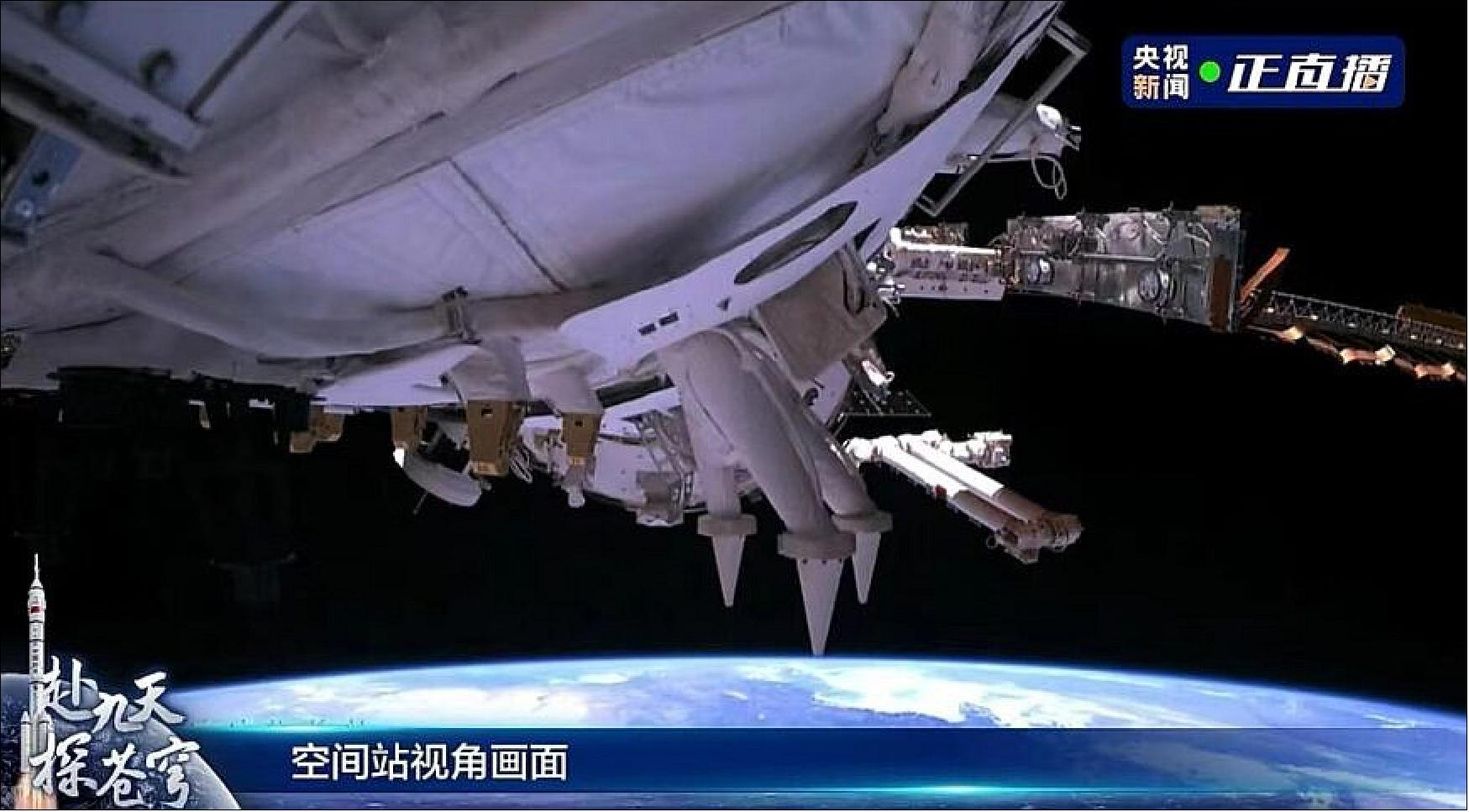
- The crew will also complete a high number of scientific experiments and hold science outreach events, Liu added.
- Chen, 43, first went to space on the month-long Shenzhou-11 mission to the Tiangong-2 test lab in 2016. Liu, 43, flew on Shenzhou-9 to visit Tiangong-1, while Cai, 46, is embarking on his first mission.
- The new airlock cabin in Wentian will become the main exit-entry point for extravehicular activities (EVAs) once active. The Shenzhou-12 and Shenzhou-13 crews have so far used Tianhe’s docking hub for EVA entry and exit.
- China’s first human spaceflight mission, Shenzhou-5, reached orbit in October 2003. Shenzhou-14 is only the ninth crewed mission launched by China in almost two decades, but the country is now committing to rolling six-month-long missions to the Tiangong space station for at least a decade.
- Shenzhou-14 will handover to the Shenzhou-15 mission, expected to launch in December, when Tiangong will briefly host six astronauts for the first time.
- Tiangong is designed to operate in orbit for at least ten years. It could be extended to six modules and host international astronauts.
- China is also considering making the station available for tourist visits and will open Tiangong to commercial missions.
- The country also plans to launch a co-orbiting optical telescope module, named Xuntian, in late 2023. It will be capable of docking with Tianhe for repairs, maintenance, refueling and upgrades, and aims to survey 40 percent of the sky across a decade.
- Xuntian features a two-meter-diameter aperture and a field of view more than 300 times greater than the 32-year-old Hubble Space Telescope.
• May 10, 2022: The Tianzhou-4 cargo spacecraft completed an automated docking in orbit with the Tianhe space station module late Monday following launch from Wenchang. 14)
- The Chinese cargo vessel completed docking with the aft port of the Tianhe module at 8:54 p.m. EST May 9, seven hours after launch on a Long March 7 rocket from the coastal Wenchang launch center in southern Hainan Province.
- Launch took place earlier on Monday at 1:56 p.m. EST, marking the fifth flight of the Long March 7, designed specifically for space station cargo missions.
- The 13,500 kg Tianzhou-4 spacecraft is the sixth of 11 missions for the construction of the T-shaped, three-module Chinese Space Station and delivers around 6.9 tons of supplies for June’s Shenzhou-14 mission.
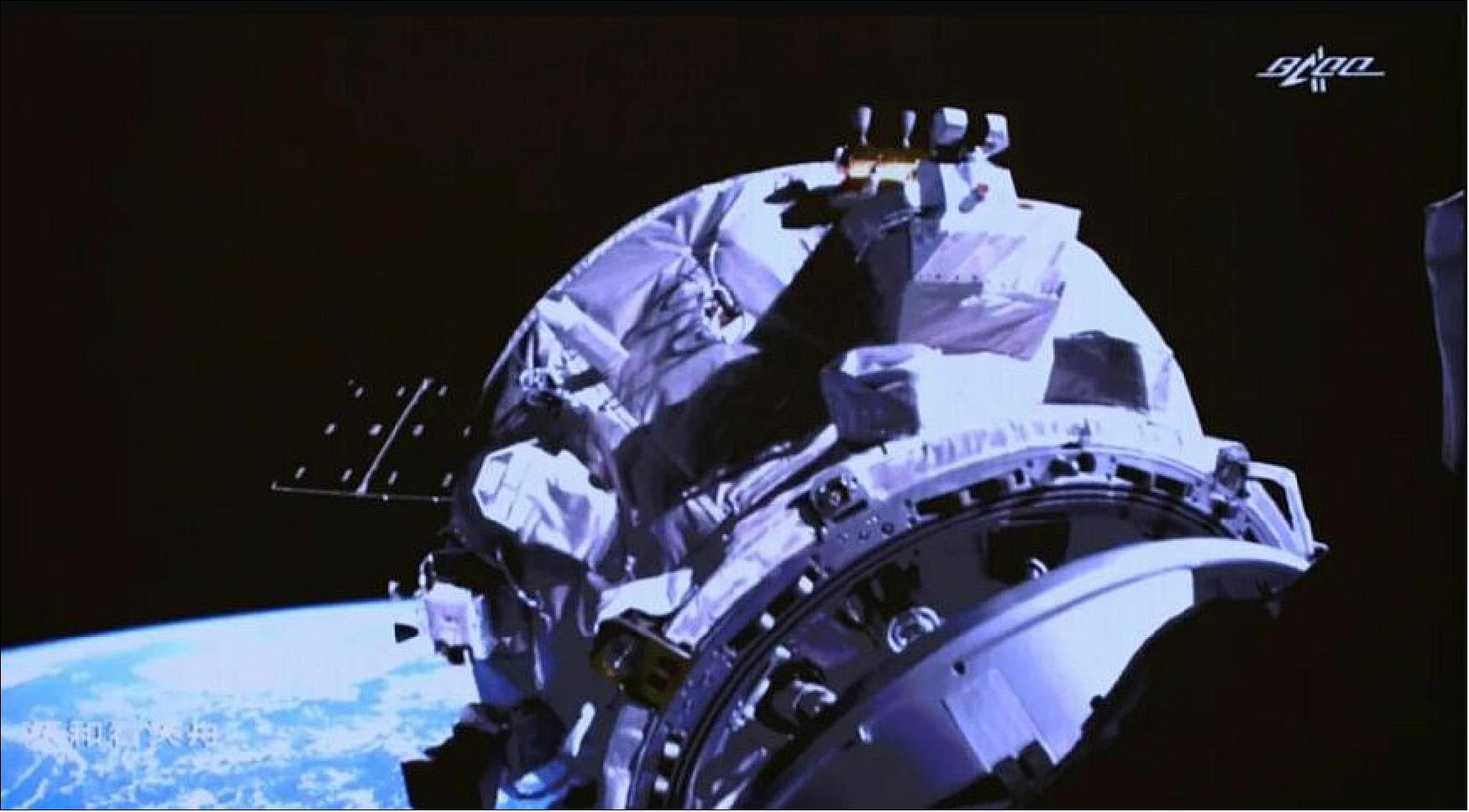
- Shenzhou-14 will see three astronauts enter the Tianhe core module for the start of a six-month-long mission which will oversee the arrival of the second and third space station modules.
- Wentian (“Quest for the Heavens”), featuring a new airlock for extravehicular activities, living quarters that will allow crew handovers, and a small robotic arm, is scheduled to launch on a Long March 5B in July.
- Mengtian (“Dreaming of the Heavens”) will launch in October. After docking, the modules will be transpositioned to radial docking ports on a docking hub launched with Tianhe.
- Tianzhou-4’s cargo mostly consists of supplies for the astronauts but also includes space station maintenance equipment, space science experiment apparatus, and a refrigerator for space science and medical experiments. It also includes a range of seeds to be exposed to radiation in low Earth orbit and later analyzed and used back on Earth.
- The daily supplies now include more vegetables than the earlier Shenzhou-12 and 13 missions to Tianhe, following feedback from the astronauts. “So now, we have 32 types of vegetables aboard,” Wang Chunhui, manager of the test team affiliated to China Astronaut Research and Training Center’s Tianzhou-4 mission, told CCTV.
- “The changes were made because the astronauts said when they were in orbit they hoped that there would be more vegetables. So this is an optimization we’ve made in terms of food supply,” Wang said.
- The first space station cargo mission, Tianzhou-2, was deorbited March 31, having supplied the Shenzhou-12 mission and been used in transposition tests. Tianzhou-3 was subsequently undocked from Tianhe’s aft port and docked with the forward port to make way for the arrival of Tianzhou-4.
- Next, Shenzhou-14 will launch on a Long March 2F rocket from Jiuquan in the Gobi Desert. The China Manned Space Agency has not revealed a precise time and date for the launch, but the mission is expected in early June.
• April 16, 2022: Three astronauts safely returned to Earth April 15 after spending a national record 182 days in orbit, completing China’s second crewed space station mission. 15)
- Commander Zhai Zhigang and colleagues Wang Yaping and Ye Guangfu touched down in the Dongfeng landing zone at 9:56 p.m Eastern (9:56 a.m. local, April 16), x hours after departing the Tianhe space station module.
- The landing occurred roughly 80 km away from the Jiuquan Satellite Launch Center, from which the trio lifted off atop a Long March 2F rocket back in October.
- The astronauts spent six months aboard Tianhe, the core module for China’s under construction space station. They conducted a pair of extravehicular activities totaling 12 hours and 36 minutes, carried out a range of science experiments and technology tests and hosted live science lectures for students back on Earth.
- Shenzhou-13 undocked from Tianhe at 12:44 p.m. Beijing Aerospace Flight Control Center issued a command at 9:06 p.m. for the Shenzhou-13 return module to separate from the orbital module.
- It was the first time that China had employed a “rapid return,” cutting the number of orbits after leaving Tianhe from 11 down to five. Landing nine hours after undocking.
- Search and rescue teams reached the landing site soon after the capsule touched down, slowed by a main parachute and retrorockets shortly before impact.
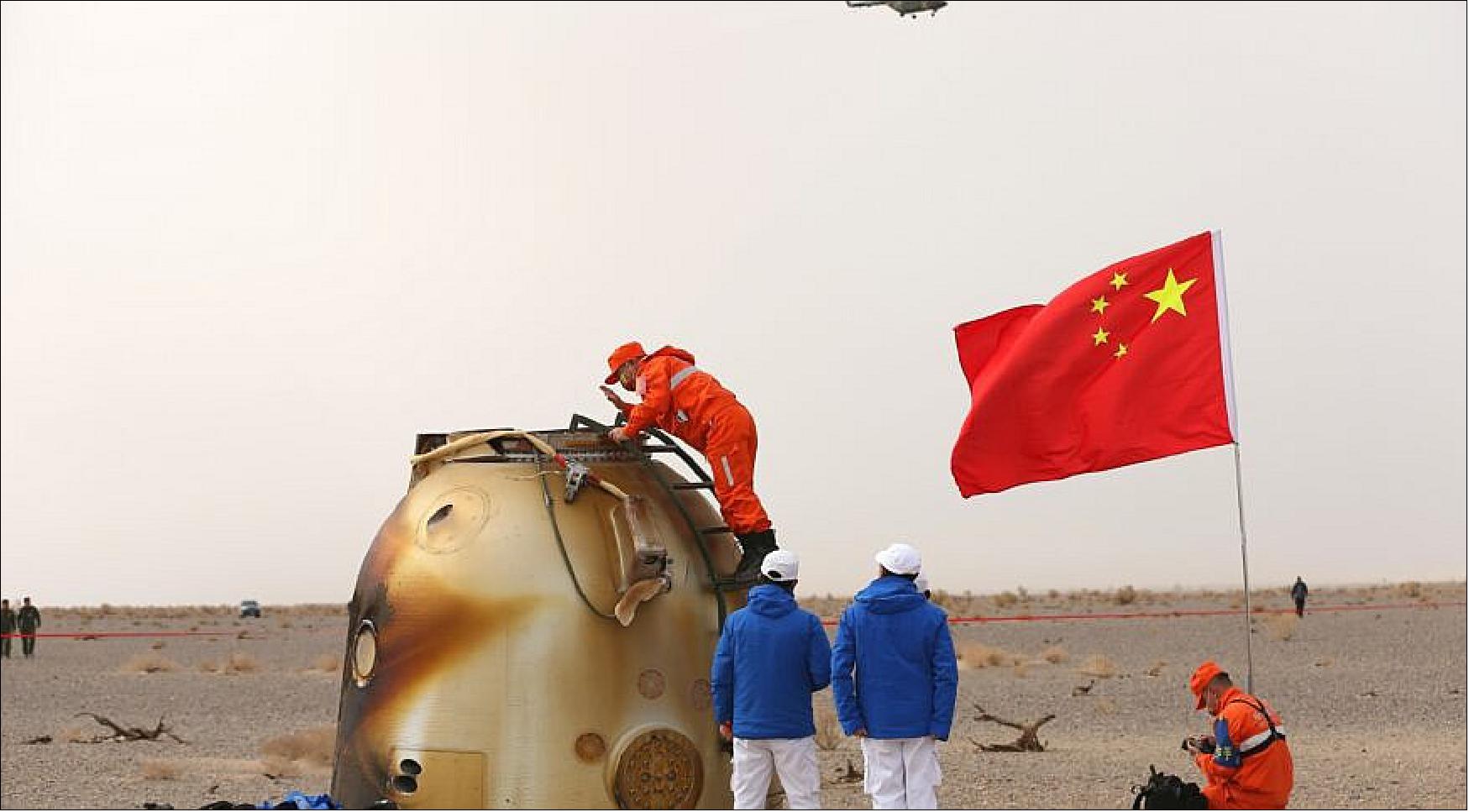
• March 31, 2022: China deorbited the Tianzhou-2 cargo spacecraft Thursday after testing on-orbit docking, refueling and module transposition for the Chinese space station. 16)
- Tianzhou-2 reentered the atmosphere over the South Pacific at 6:40 a.m. EST March 31, China’s human spaceflight agency, CMSA, announced minutes after the event. The area of the ocean is frequently used as a “spacecraft cemetery.”
- The spacecraft separated from the forward docking port of Tianhe, the core module of China’s space station, at 3:59 a.m. EST March 27.
- Tianzhou-2 makes way for the arrival of the Tianzhou-4 cargo spacecraft which will provide fresh supplies and fuel ahead of the arrival of the Shenzhou-14 crew, with the latter expected to launch around mid-to-late May.
- The 10-month-long mission verified a number of technologies and procedures needed to proceed with future construction of the Chinese space station.
- Tianzhou-2 launched May 29, 2021, on a Long March 7 rocket from Wenchang. It completed automated rendezvous and docking maneuvers with Tianhe just over eight hours later.
- The 13.5-ton spacecraft was the first to join the Tianhe module in orbit, verifying on-orbit docking and refueling required for further missions to begin. It delivered 4.69 tons of cargo in a pressurized segment, including three months’ worth of food for three Shenzhou-12 crew members and two EVA suits.
- It also carried 1.95 tons of propellant to the 22.5-ton Tianhe module, which had launched in late April.
- The spacecraft performed four rendezvous and docking maneuvers, including a manual remote operation rendezvous and docking, to test out procedures.
- Tianzhou-2 was also involved in a transposition test ahead of the arrival of two future modules, Wentian and Mengtian, due to launch later in the year.
- On Jan. 5 Tianhe’s 10-meter-long robotic arm grasped Tianzhou-2, moving it roughly 20 degrees before returning it to the forward port on the Tianhe docking hub.
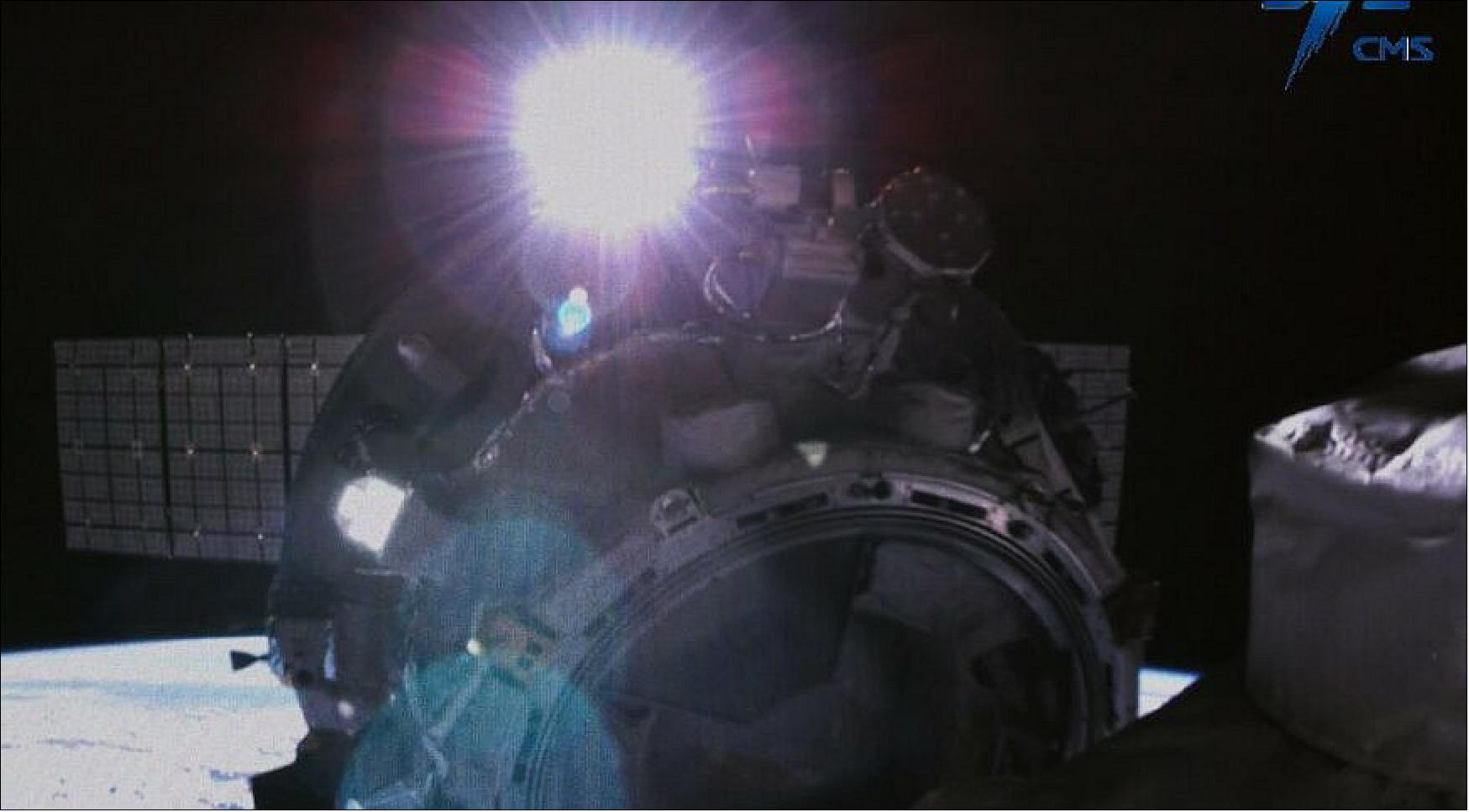
- Both new modules will dock with the forward port before being transposed to respective lateral docking ports, creating the finished “T-shaped” orbital outpost.
- China plans six missions in 2022 to complete its space station, including two cargo and two crewed missions along with the two module launches.
- The China Academy of Launch Vehicle Technology (CALT) held a ceremony March 29 for launch teams that will be involved in the required Long March 2F, Long March 5B and Long March 7 rocket launches.
- The spacecraft for the ongoing Shenzhou-13 crewed mission is currently docked at the nadir port at Tianhe and is expected to depart in mid-April. Tianzhou-4 will launch for Tianhe following this, ahead of a new crew aboard Shenzhou-14.
- The 20-ton-plus Wentian and Mengtian modules will launch during the six-month-long Shenzhou-14 mission. Tianzhou-5 will launch ahead of Shenzhou-15, both scheduled for late in the year, with the latter expected to see the first Chinese crew handover aboard the completed space station.
- Tianzhou-5 will also carry five small satellite payloads among a range of experiments, CMSA announced March 30.
- The module launches will be followed closely, partly due to the significance of the missions, but also because of the use of the Long March 5B, the two previous launches of which saw the large first stages make high-profile uncontrolled reentries.
- The Tiangong space station is planned to operate in orbit for at least 10 years. It will host a range of international experiments through collaboration with the United Nations Office of Outer Space Affairs, and potentially foreign astronauts and further modules in the coming years.
• January 7, 2022: China's Tiangong space station conducted a test using its robotic arm to reposition the Tianzhou 2 cargo spaceship on Thursday morning, according to the China Manned Space Agency (CMSA). 17)
- In a statement, the agency said that the arm secured the robotic cargo craft early on Thursday morning (Jan. 6) and began to move it to a new position at 6:12 a.m. Tianzhou 2 had been connected to the station's Tianhe core module and was undocked before the test started.
- After moving the ship to a predetermined position, the arm reversed the maneuvers to bring it back to its original position. Tianzhou 2 re-docked with Tianhe, finishing the 47-minute test at 6:59 a.m.
- According to the agency, the test achieved its goal of verifying the repositioning procedure and the devices designed for arm-enabled operations, and provided additional experience that will be used in the next steps of Tiangong's construction in orbit.
- Upon its completion at the end of this year, Tiangong will consist of three main components-a core module attached to two space labs-and will have a combined weight of nearly 70 metric tons. The station is scheduled to operate for 15 years in a low-Earth orbit about 400 kilometers above the planet.
- Six launches will be made this year to deploy the Shenzhou XIV and XV mission crews to the Tiangong station, to transport Tianzhou 4 and 5 robotic cargo spaceships to the station for refueling and resupply operations, and to send two large space labs to dock with the station.
- The first of the six to be launched will be Tianzhou 4, which will be followed by the Shenzhou XIV manned spacecraft. Then the two space labs-Wentian (Quest for the Heavens), and Mengtian (Dreaming of the Heavens) — will be launched into space to complete the station. The fifth to be launched will be Tianzhou 5, and the final one will be Shenzhou XV.
- Pang Zhihao, a spaceflight researcher in Beijing who worked at the China Academy of Space Technology for decades, said the test was mainly intended to make technical preparations for the in-orbital docking between the Tianhe module and the two space labs.
- "The test has been the first time for China to use a mechanical arm to reposition a spacecraft. It would serve as a trial run of related technologies, equipment and processes that will be involved in the space labs' docking operations, which will be sophisticated and demanding," he said.
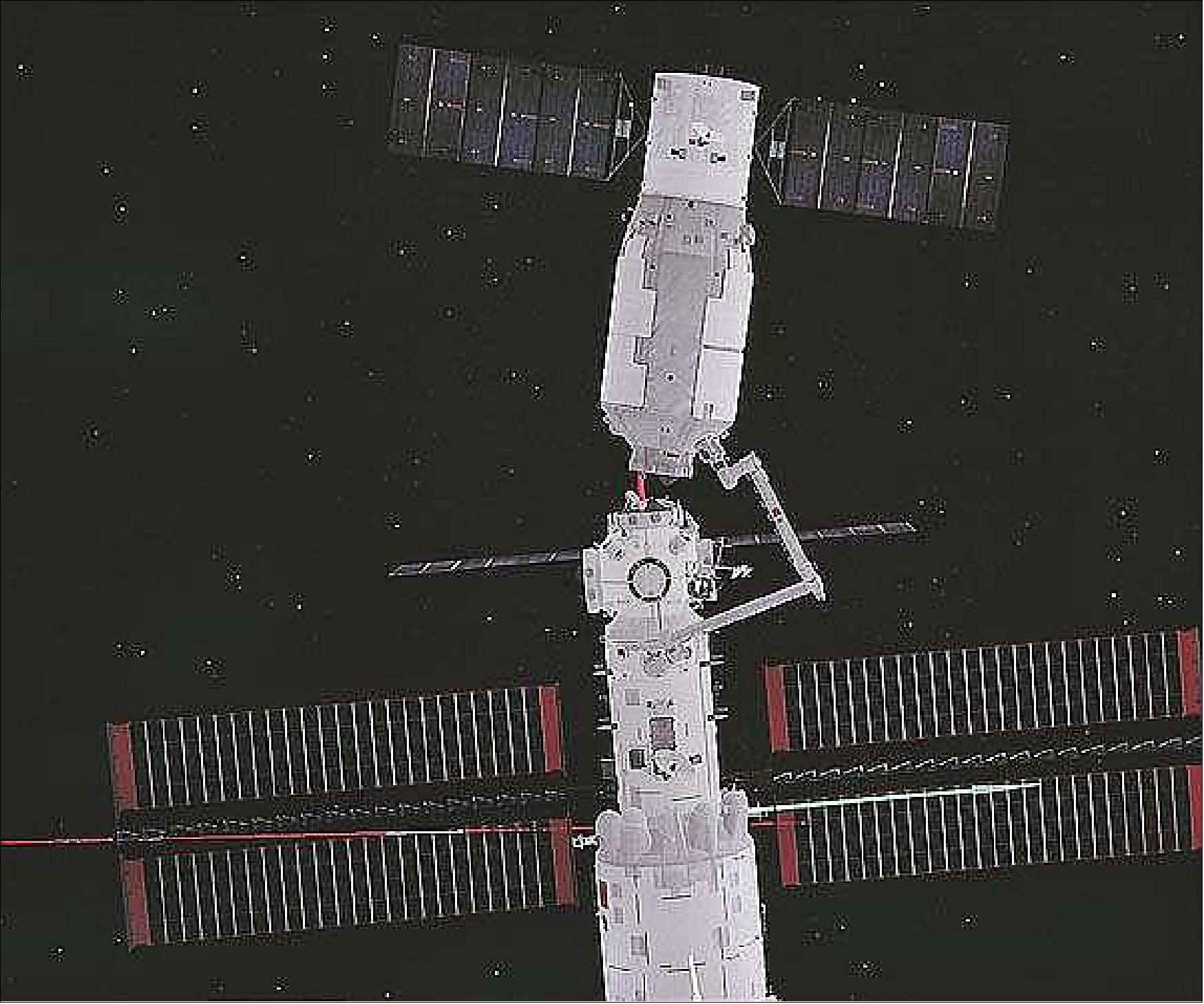
- According to the researcher, who has abundant knowledge of the Chinese space station program, the robotic arm on Tianhe is 10 meters when fully extended. It has several motorized joints, which allows it to act like a human arm to the maximum possible extent.
- He said the apparatus can reach many parts of the Tianhe module, and it is able to handle payloads with a combined mass of 25 tons.
• January 3, 2022: China’s main space contractor will target more than 40 orbital launches this year, including completion of the Tiangong space station, following 48 successful launches in 2021. 18)
- The China Aerospace Science and Technology Corp. (CASC) stated on social media that it is targeting more than 40 launches, including six missions to complete the construction of the country’s space station.
- The Tianzhou-4 cargo spacecraft will launch on a Long March 7 from Wenchang to dock with the orbiting Tianhe core module around March or April, following the end of the ongoing, six-month Shenzhou-13 crewed mission.
- The station’s third crewed mission, Shenzhou-14, will follow Tianzhou-4. The mission’s three astronauts will be aboard Tianhe for the arrival of the 20-metric-ton-plus Wentian and Mengtian modules, expected to launch around June and August respectively.
- The module launches will complete the T-shaped orbital outpost. Tianzhou-5 will launch ahead of Shenzhou-15, both scheduled for late in the year.
- The module launches will be followed closely, partly due to the significance of the missions, but also because of the use of the Long March 5B, the two previous launches of which saw the large first stages make high-profile uncontrolled reentries which sparked acrimony.
- The Tiangong space station is planned to operate in orbit for at least ten years. It will host a range of international experiments through collaboration with the United Nations Office of Outer Space Affairs, and potentially foreign astronauts and further modules in the coming years.
- CASC will also launch the first Long March 6A, featuring a liquid core with solid boosters, from a new complex constructed at the Taiyuan spaceport. The Long March 8 will launch for the second time in February, but it is unknown if the mission will include tests related to plans for the eventual recovery and reuse of its first stage.
- The group does not release a detailed manifest, meaning mission timing and payloads are often unknown until after launch. Airspace closure notices remain a main indicator of upcoming missions.
- The workhorse Long March 3B will likely launch a number of communications and possibly replacement BeiDou satellites in geosynchronous and medium Earth orbits. Weather, remote sensing, technology test and classified Shiyan and Shijian satellites can also be expected to be sent into orbit.
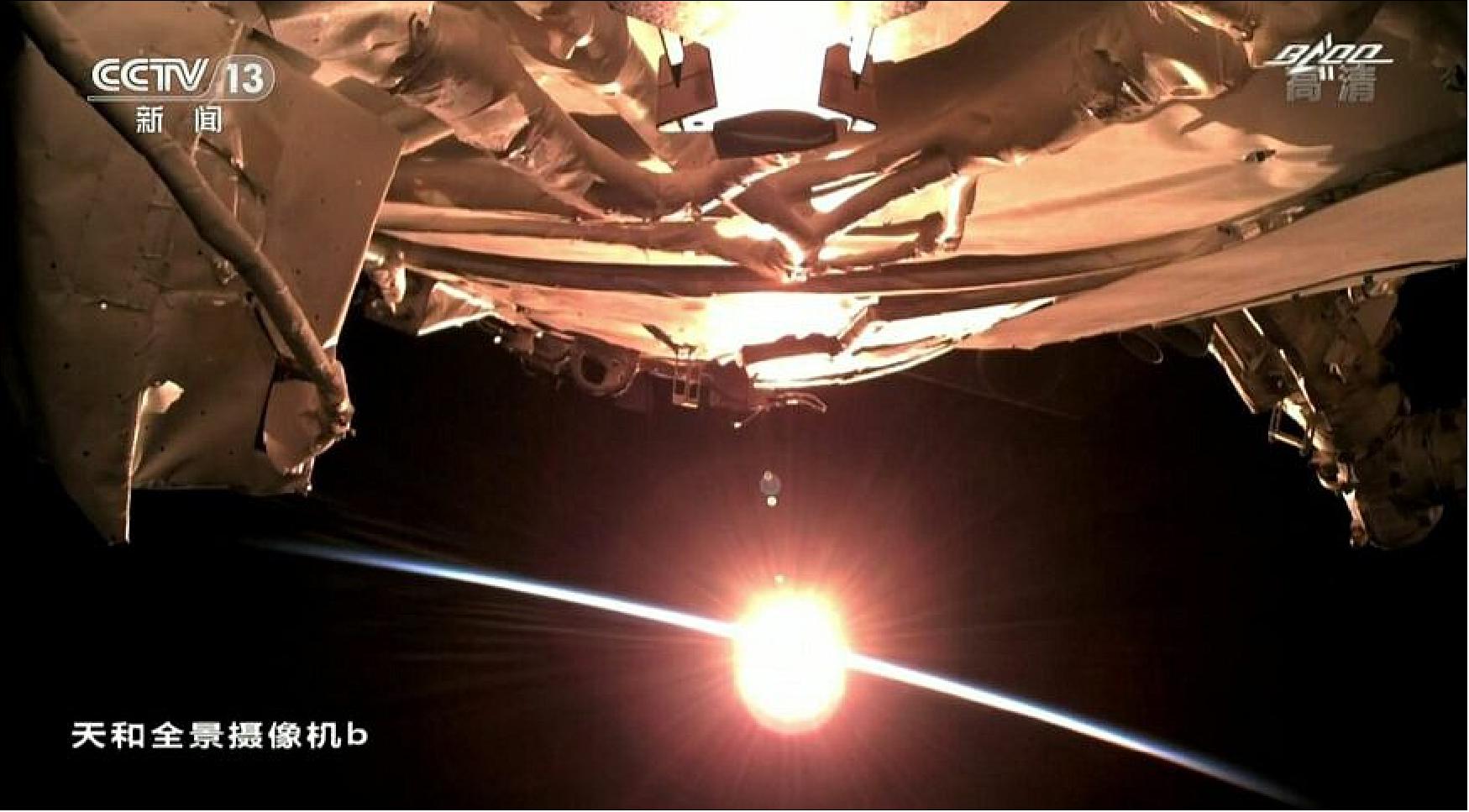
- A number of sea launches of the Long March 11 are also expected from a new Eastern spaceport in Shandong province, established to facilitate maritime missions. A new vessel is being prepared to host the launches, which have previously been conducted in the Yellow Sea.
- Possible space science launches include the Advanced Space-based Solar Observatory (ASO-S), which follows the October launch of the Chinese H-alpha Solar Explorer (CHASE), or Xihe.
- The Einstein Probe, an X-ray survey satellite featuring lobster-eye optics and dedicated to time-domain high-energy astrophysics, could also launch before the end of the year.
- CASC will be continuing development of two new super heavy-lift launch vehicles, the Long March 9 and a new rocket for lunar crewed missions.
- Overall China launched 55 times in 2021, with 48 Long March launches. 2022 could involve even more activity outside of CASC.
Commercial Launch Activity
- In Addition to CASC activity a number of launches will be conducted by companies which are spinoffs from CASC and two other giant state-owned entities, the China Aerospace Science and Industry Corp. (CASIC), and the Chinese Academy of Sciences (CAS).
- CASIC spinoff Expace had planned to launch at least 12 Xingyun satellites for CASIC’s narrowband Internet of Things constellation, as well as missions for commercial customers. However the Dec. 15 failure of its Kuaizhou-1A solid rocket could bring lengthy delays, just months after the rocket returned to action following being grounded for one year due to a 2020 failure. The larger Kuaizhou-11 has yet to fly following the loss of its first flight in 2020.
- CAS spinoff Zhongke Aerospace, also known as CAS Space, is preparing to conduct its first launch in the first quarter of the year. The Lijian-1 (Zhongke-1A) solid rocket. Capable of lifting 1.5 tons to LEO, the ZK-1A could be China’s largest solid orbital rocket in terms of payload capacity at time of flight.
- China Rocket, spun off from CASC, states it will launch the first Jielong-3 solid during 2022, providing yet more competition among three major groups. The firm says the rocket will be capable of lifting 1.5 tons into a 500-kilometer-altitude m Sun-synchronous orbit, and carry up to 20 satellites.
- Private firm Galactic Energy will soon follow up its second successful launch of the Ceres-1 solid rocket with up to five further launches from Jiuquan, northwest China, during 2022. It could also debut the liquid Pallas-1 before the end of the year.
- Landspace is preparing to launch its methane-liquid oxygens Zhuque-2 rocket in the first quarter of the year, which could be the world’s first methalox orbital launch.
- Private firms iSpace and Deep Blue Aerospace are planning hop tests as part of the development of reusable first stages for their respective methalox Hyperbola-2 and kerosene-liquid oxygen Nebula-1 rockets.
- Space Pioneer is meanwhile working on its Tianlong-1 commercial reusable launch vehicle. Linkspace could also be active following self-development of a new engine for its reusable rocket plans.
• December 28, 2021: China has informed the United Nations that its crewed space station twice maneuvered to avoid potential collisions with SpaceX Starlink satellites earlier this year. 19)
- A notification dated Dec. 6 by China under Article V of the Outer Space Treaty stated that the Tianhe space station module conducted preventive collision avoidance due to close approaches by the Starlink-1095 (2020-001BK) and Starlink-2305 (2021-024N) satellites on July 1 and Oct. 21 respectively.
- Starlink satellites typically orbit at around 550 km above the surface of the Earth, but the pair had lowered their altitudes, apparently as part of active deorbiting maneuvers at the end of the satellites’ life.
- This saw the pair drift into the path of China’s Tianhe, the first module for the country’s space station. Both times Tianhe was inhabited, by the three-person crew of the Shenzhou-12 mission in July, and the ongoing Shenzhou-13 mission during the October close approach.
- Satellite tracker Jonathan McDowell, of the Harvard-Smithsonian Center for Astrophysics, confirmed the two close approaches and avoidance burns using data published by U.S. space tracking. The October pass appears to have been within three kilometers.

• December 26, 2021: Two Shenzhou-13 astronauts embarked on a six-hour extravehicular activity Sunday to install equipment outside China’s Tianhe space station module. 20)
- Astronaut Ye Guangfu, wearing a Feitian EVA suit with yellow markings, opened the Tianhe airlock hatch at 5:44 a.m. EST Dec. 26 before exiting the space station module, according to the China Manned Space Agency (CMSA).
- Mission commander Zhai Zhigang, with red markings on his Feitian suit, followed his colleague outside at 6:37 a.m., embarking on his third spacewalk. Wang Yaping, the third Shenzhou-13 crew member, assisted from inside Tianhe, operating the module’s large robotic arm.
- The pair raised a third panoramic camera outside Tianhe, performed further tests of equipment and made preparations for future missions. Operations were completed by 11:55 a.m. CMSA stated.
- The EVA is the fourth conducted since the launch of the Tianhe core module in April this year. China will next year conduct tests involving Tianzhou cargo spacecraft currently docked with Tianhe and launch two new modules designed to host science research.
- The EVA was Ye’s first spacewalk, having assisted Zhai and Wang Yaping from inside Tianhe during the first Shenzhou-13 EVA Nov. 7 Zhai became the first Chinese citizen to carry out a spacewalk during the 2008 Shenzhou-7 mission and participated in the November EVA with Wang.
- Chinese state media broadcast a portion of the EVA, including English language coverage from CGTN.
- Shenzhou-13 launched Oct. 15 and the three crew are expected to remain onboard until March 2022. The mission is the second to the Tianhe module, following the June-September Shenzhou-12 mission.
- China’s human spaceflight agency and state media have begun providing more regular updates from the Shenzhou-13 mission, indicating greater confidence to realize outreach, political and soft power potential from the space station project. A number of official outlets also highlighted that the Shenzhou-13 spacewalk occurred on the anniversary of the birth of People’s Republic of China founder Mao Zedong.
- Authorities previously limited the publishing of video and imagery from the Shenzhou-12 mission and first weeks of Shenzhou-13.
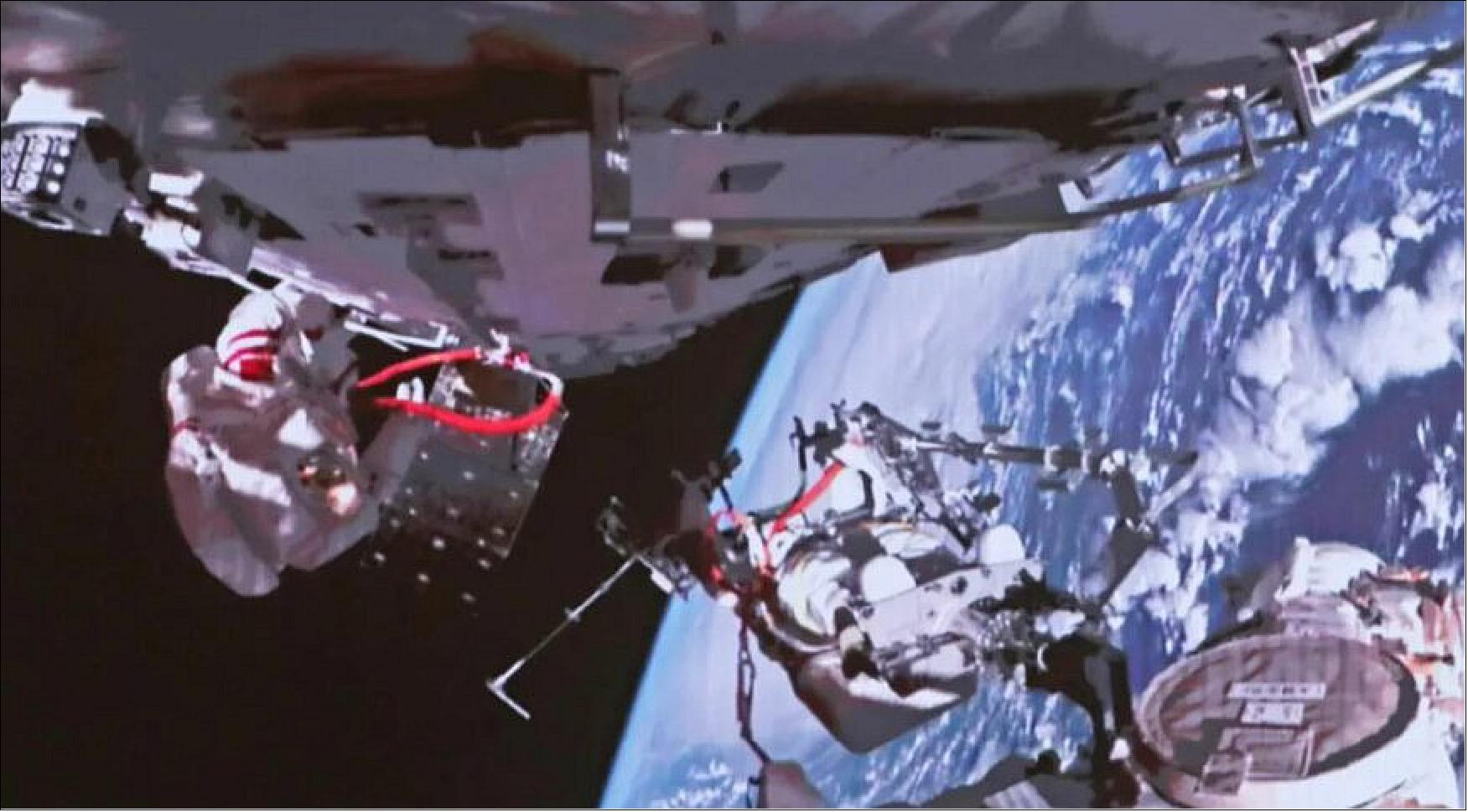
- The Shenzhou-13 astronauts delivered a live science lecture from Tianhe Dec. 9, providing a tour of Tianhe and demonstrating a number of unique phenomena in microgravity.
- The “Tiangong classroom” was targeted at school children, particularly to boost interest in STEM education. A question and answer session included questions from children at schools in Beijing, Guangxi Zhuang Autonomous Region and Sichuan Province in the southwest and Hong Kong and Macao from outside the mainland.
- Live English language coverage of the event meanwhile presents a friendly, benevolent face to China’s space efforts, in contrast to recently reporting on hypersonic vehicle testing. More Tiangong classes are planned for the future.
• October 15, 2021: A second crew of three astronauts are heading for China’s Tianhe space station module after the successful launch of the Shenzhou-13 mission Friday. 21)
- A Long March 2F lifted off from the Jiuquan Satellite Launch Center in the Gobi Desert at 12:23 Eastern Oct. 15. The rocket, with four side boosters, two stages and a launch escape system, rose from the LC43/91 launch complex into the black skies above Jiuquan after midnight local time.
- Applause followed in mission control after each major launch event, culminating in Shenzhou-13 separating from the second stage, entering orbit and deploying its solar arrays.
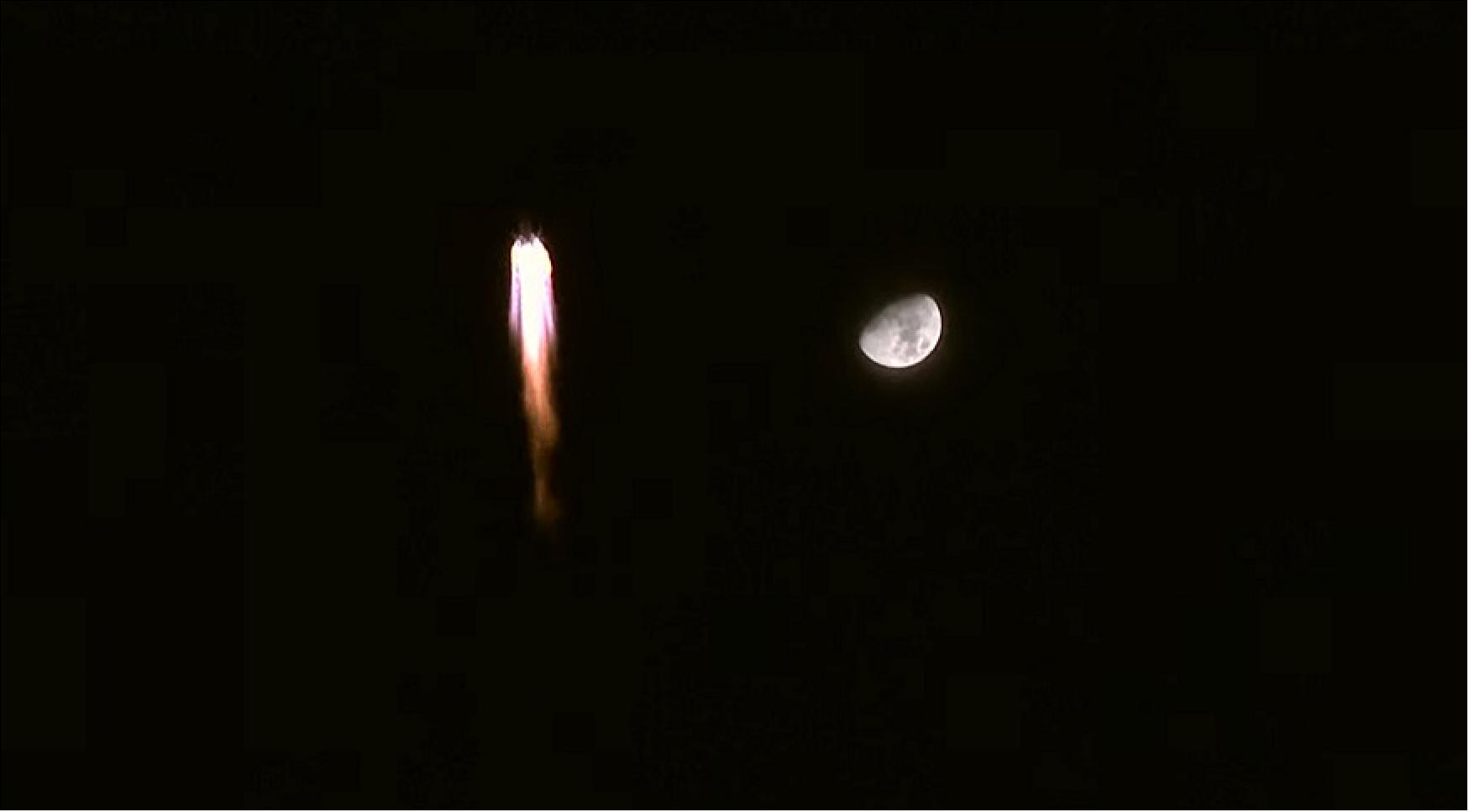
- Commander Zhai Zhigang and colleagues Wang Yaping and Ye Guangfu make up the crew of the three-module Shenzhou-13. The spacecraft is now due to attempt a radial rendezvous with Tianhe within the next eight hours and dock at the Tianhe module’s nadir port.
- The trio are expected to stay aboard the 16.6-meter-long, 4.2-meter-diameter Tianhe for six months, which would be China’s longest by three months.
- Major mission objectives include conducting two or three extravehicular activities, installing an adaptor to combine large and small robotic arms and carrying out a range of medicine and physics-related experiments.
- Wang Yaping, 41, is also expected to deliver a live educational lecture from orbit, following on from her first such session during 2013’s Shenzhou-10 mission.
- Zhai, 55, took part in China’s first spacewalk during Shenzhou-7 in 2008. In an Oct. 14 press conference he expressed confidence but also a sense of pressure.
- “Now 13 years later, I will conduct another space mission. Apart from excitement, I am feeling pressure. But our Shenzhou-13 crew will remain true to our original aspiration and keep our mission firmly in mind, and do all we can to live up to our country’s and people’s expectations. We have the confidence and ability to accomplish this mission successfully,” Zhai said.
- Ye Guangfu, 41, is making his first trip to space. Ye participated in ESA’s 2016 CAVES analogue exploration training with European, Russian, Japanese and American astronaut colleagues. ESA’s Loredana Bessone told SpaceNews that Ye integrated well and took responsibility to lead the cave survey segment, and as such got to name a newly discovered branch “Guang Ming”.
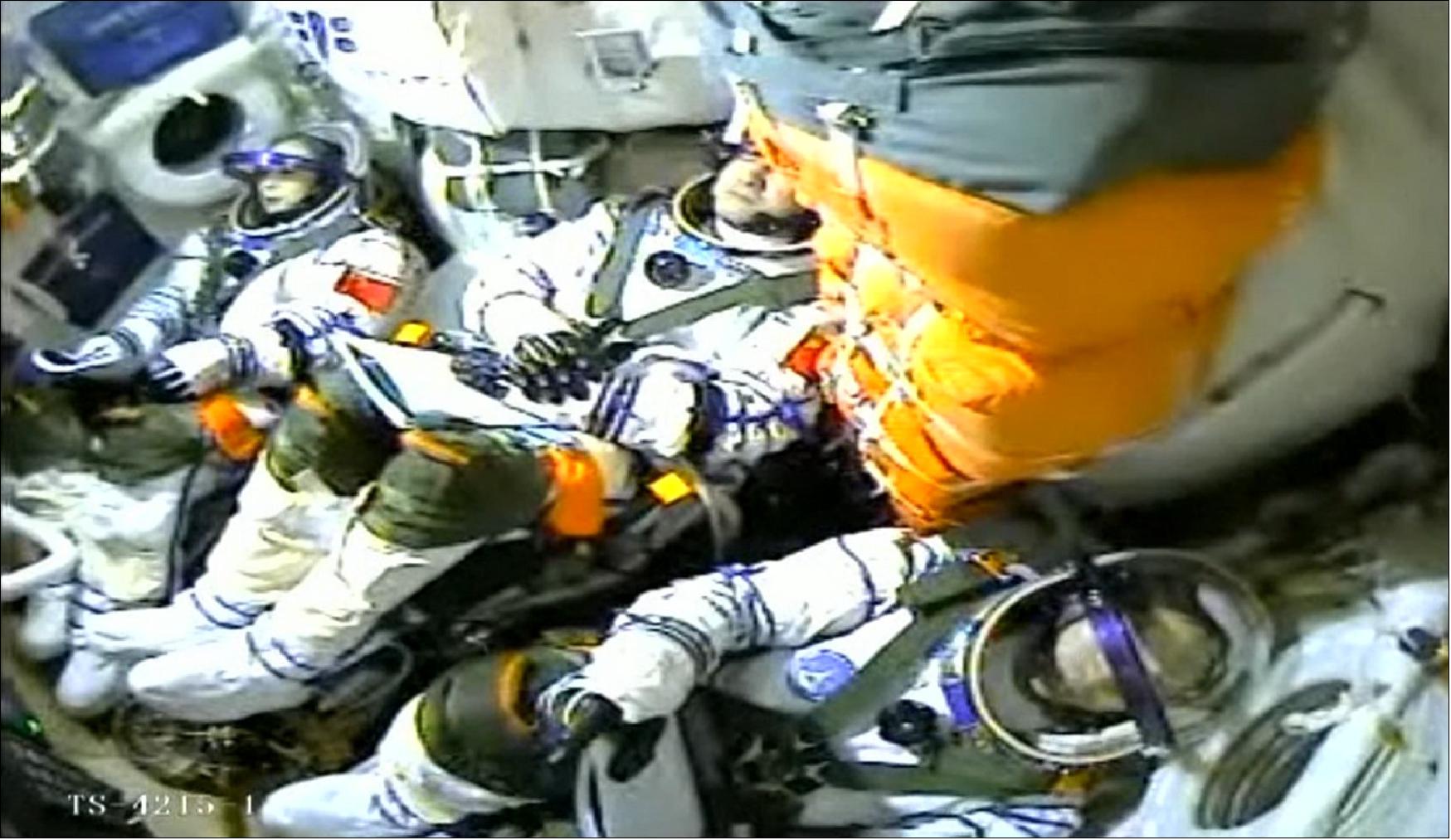
- The mission is yet another major milestone as China expands the scope, duration and complexity of its crewed and robotic space endeavors.
- So far in 2021 China’s first interplanetary mission entered Mars orbit and landed a rover on the Red Planet, as well as launching five space station missions. A recent analysis of Chang’e-5 lunar sample-return mission material confirms the spacecraft collected the youngest lunar samples so far, announced plans for a joint International Lunar Research Station, while a second, highly-secretive spaceplane launch has also been conducted.
Preparing for New Space Station Modules
- Two cargo spacecraft, Tianzhou-2 and Tianzhou-3, are currently docked at Tianhe’s forward and aft docking ports. Tianzhou-2 will be used for a test of the ability of Tianhe’s robotic arm to manipulate future modules and transfer these from the forward to lateral docking ports.
- Tianzhou-3 launched Sept. 20 to deliver nearly 6,000 kg of provisions, equipment and experiments for the Shenzhou-13 mission.
- The 22.5-ton Tianhe launched late April and is the first module of an initial three planned modules to make up the Chinese space station. The first crewed mission, Shenzhou-12, visited from June to September.
- Experiment modules Wentian and Mengtian are planned to launch in 2022 following the Shenzhou-14 mission, which will follow completion of Shenzhou-13 and launch of Tianzhou-4.
- China approved “Project 921” in September 1992, setting out the goals of developing human spaceflight capabilities and eventually constructing a low Earth orbit space station.
- Yang Liwei launched on Shenzhou-5 in October 2003 to make China only the third country to achieve independent human spaceflight. Two 8.2-ton Tiangong space labs were used for on-orbit rendezvous and docking tests and life support during short crewed visits.
- Today’s mission is only China’s eighth crewed launch, but regular six-month missions will become the norm as China first tests, constructs and operates the Tiangong space station complex.
- The launch is the second crewed Long March 2F mission of 2021 and 35th Long March launch of the year. China’s main space contractor has planned more than 40 launches in 2021.
• August 20, 2021: Chinese astronauts Nie Haisheng and Liu Boming embarked on a second Shenzhou-12 spacewalk to carry out work on a space station robotic arm. 22)
- Shenzhou-12 mission commander Nie opened the hatch of the Tianhe module at 8:38 p.m. EDT Aug. 19 (00:38 UTC on 20 August) to begin a planned near seven-hour extravehicular activity, according to CMSA (China Manned Space Agency).
- The pair, wearing second generation Feitian (“flying to space”) extravehicular mobility suits, completed installing foot restraints and an extravehicular working platform to the large robotic arm. Chinese media outlets streamed footage of the EVA.
- The excursion was supported by astronaut Tang Hongbo inside Tianhe, the 16.6-meter-long, 4.2-meter-diameter space station core module which launched April 28.
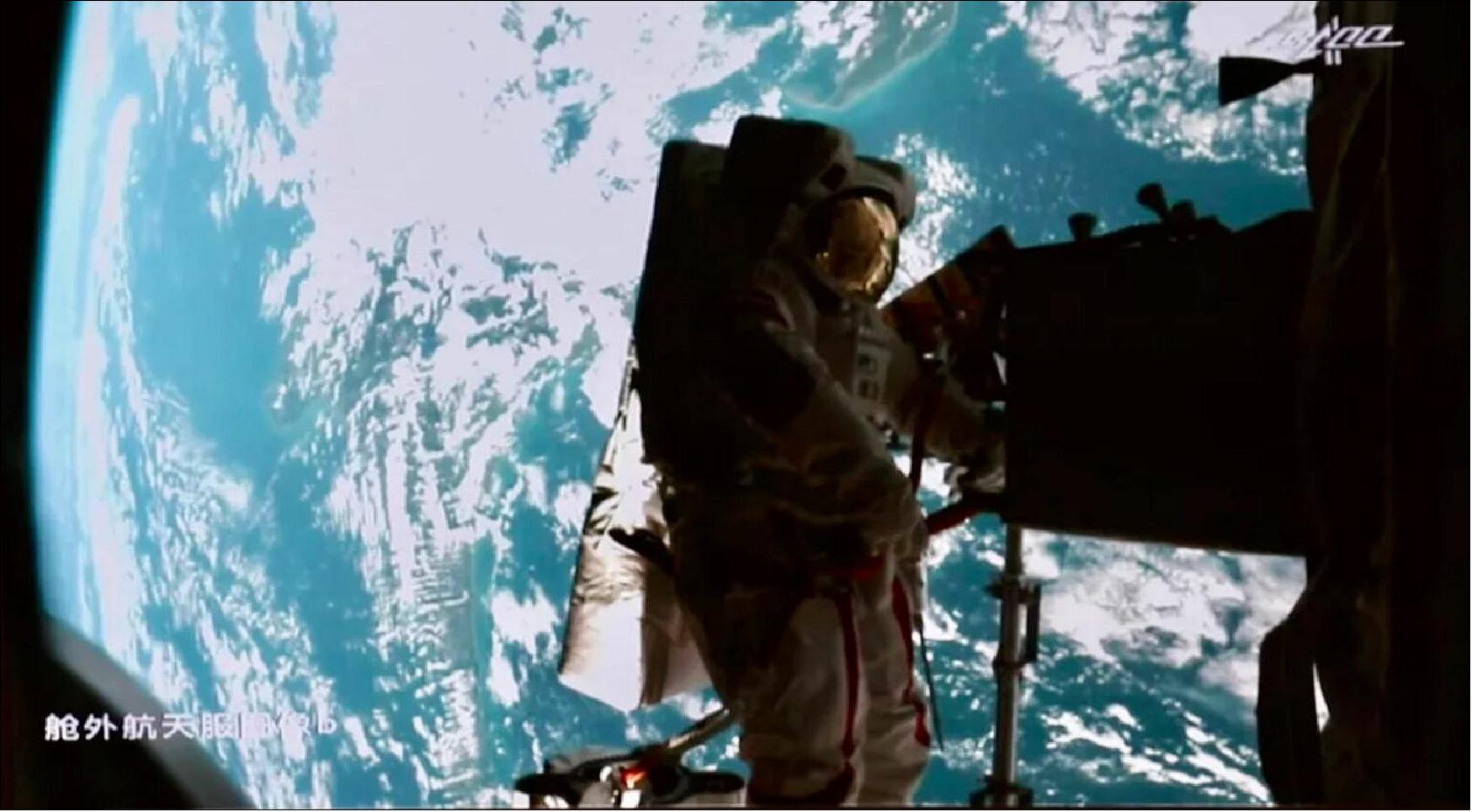
- The EVA also included work on a panoramic camera, installing a toolkit, adding a pump set for the Tianhe thermal control system and other apparatus in preparation for the arrival of two further modules in 2022. The EVA was completed at 2:33 a.m. EDT Friday (06:33 UTC), around an hour ahead of schedule.
- The Shenzhou-12 crew have been aboard Tianhe since June 17. They are expected to return to Earth within a month, ahead of arrival of the Tianzhou-3 cargo supply mission. A first Shenzhou-12 spacewalk was conducted July 3 by Liu Boming and Tang Hongbo.
- The astronauts have carried out a range of activities and experiments in preparation for future missions. Recent work includes installing a refrigeration unit for medical samples, assembly of a space centrifuge, activating a magnetic levitation experiment, blood sampling and testing a hazardous trace gas removal subsystem.
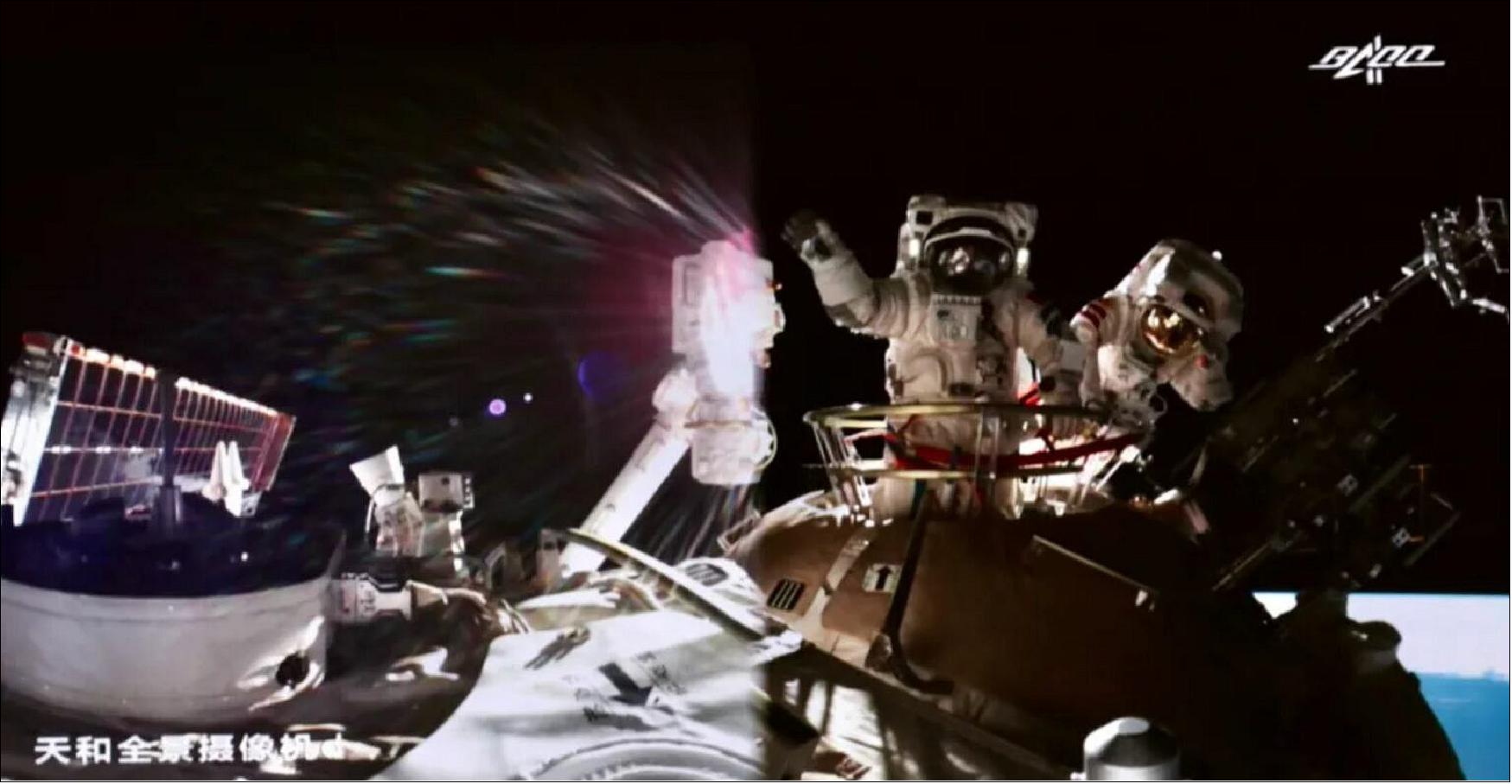
Space Station Construction Plans
- The Long March 7 rocket to launch Tianzhou-3 arrived at Wenchang spaceport earlier this week and is expected to launch around September 20. Tianzhou-3 will deliver supplies for the October Shenzhou-13 crewed mission.
- Preparations for Shenzhou-13 are underway at Jiuquan, northeast China, where a Long March 2F rocket has been readied in advance in case of need for an emergency launch to Tianhe.
- Tianzhou-2, which delivered supplies to Tianhe for Shenzhou-12, is expected to remain docked to the core module beyond the deorbiting of Shenzhou-12. It will then undock from Tianhe’s aft port and dock with the forward docking port and conduct transfer propellant testing with Tianhe.
- The 13,000 kg liftoff mass Tianzhou-2 will then be used as a test unit for the robotic arm to manipulate modules as part of space station construction. Tianhe will be joined in orbit by two experiment-hosting modules, named Mengtian and Wentian, in 2022.
- A day ahead of the spacewalk CMSA released orbital parameters for Tianhe of 379.7 by 396.85 km with an inclination of 41.35º and a speed of 7.68 km/s.
- Yang Yanbo, deputy commander of the Shenzhou-12 mission at the Beijing Aerospace Control Center, told Chinese media that teams on the ground are monitoring the space environment and are ready to conduct collision avoidance maneuvers.
- Shenzhou-12 is the third of an intensive series of 11 missions for construction of the three-module Chinese space station. Named Tiangong, the overall complex is planned to be completed by the end of 2022.
- Tiangong will be joined in orbit by Xuntian, an optical Hubble-class space telescope, around 2024. The Chinese space station could also be expanded from three to six modules if main phase construction proceeds as planned.
• August 5, 2021: Companies involved with commercial activities on the International Space Station or planning their own space stations may face a new competitor in China’s new space station. 23)
- During a presentation at the ISS Research and Development Conference Aug. 4, Jeff Manber, chief executive of Nanoracks, said his company has already lost business to China and its space station.
- “I lost a customer, my first customer that I lost going to the Chinese space station,” he said. “We’re in a competition now.”
- He did not identify the customer or what they had planned to do. Nanoracks has several lines of business on the ISS today, from hosting experiments and external payloads to using the station as a platform for launching small satellites.
- Chinese officials have said they are open to cooperating with other countries regarding use of the station. Ji Qiming, assistant director of the China Manned Space Agency, told China Daily in June that it had selected nine scientific projects from 17 countries to fly on the station, and was working with the United Nations Office for Outer Space Affairs to identify others. That could also include flying astronauts from other countries to the station.
- Manber said that was a reminder for the need of U.S. leadership to attract international users of the ISS. “There should be no question that these are important ways that we keep not only that soft leadership, American leadership, but how we learn and how capital flows,” he said. “If we don’t, we open the door to other to come in and take leadership.”
- Nanoracks is a major commercial user of the ISS but is also looking ahead to the eventual transition to commercial platforms. The company announced Aug. 2 that it hired a former NASA official, Marshall Smith, as its new senior vice president for commercial space stations, leading projects such as efforts to convert launch vehicle upper stages into commercial platforms.
- “We’re doubling down on the International Space Station, and yet at the same time we’re beginning to look at a new era of commercial space stations,” he said. “We have to start planning as to what happens as the ISS begins to retire at the end of this decade.”
- That “doubling down” on the ISS includes Bishop, a commercial airlock module that Nanoracks developed and installed on the station last December, allowing the company to launch more satellites and install external payloads. He cautioned, though, that NASA might be focusing too much on new hardware as it seeks to support commercialization efforts.
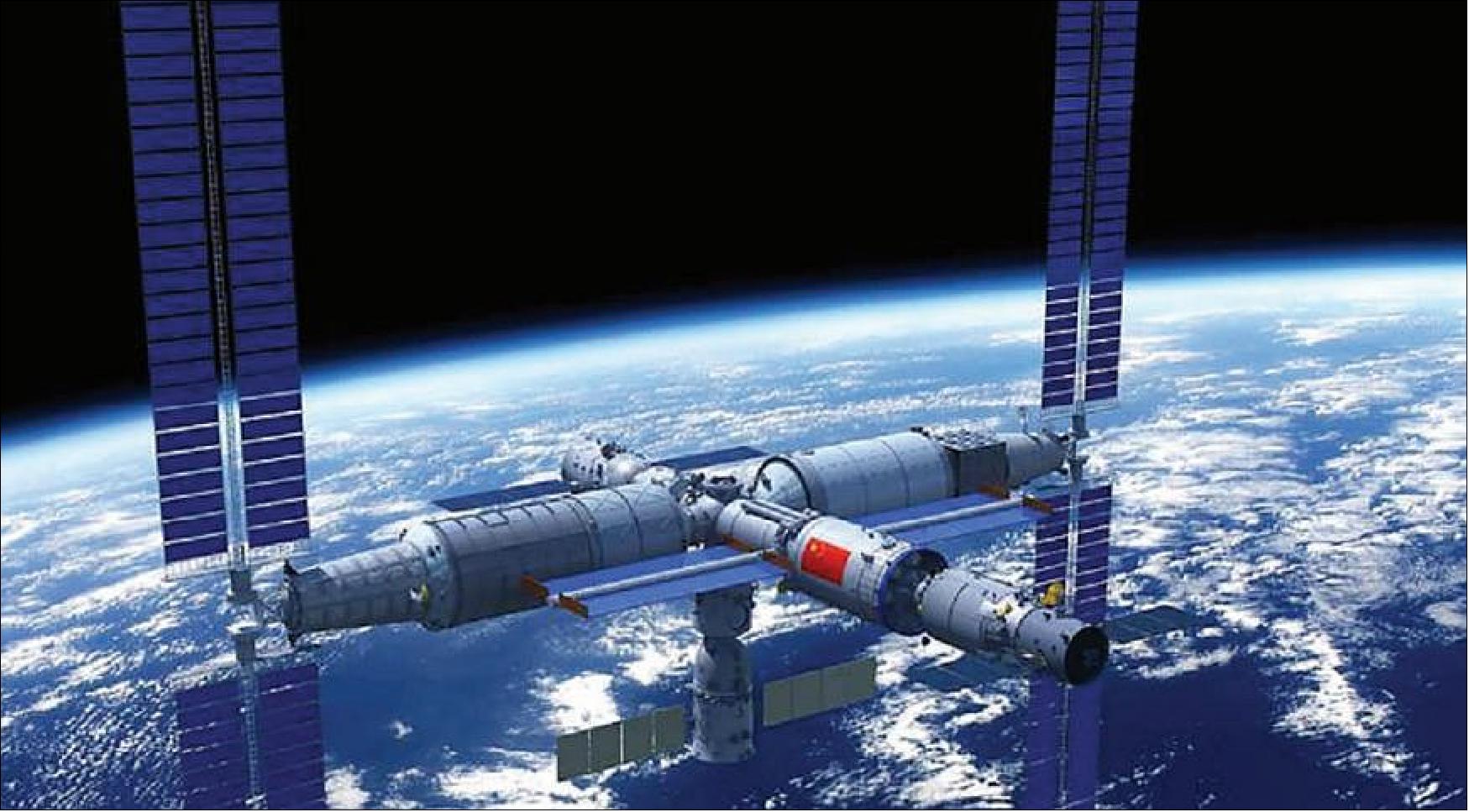
- “NASA has not met new hardware that it doesn’t like,” he said. “Everybody’s fascinated with the hardware and they’re not focused on the demand side.” That approach, he said, can reduce use of existing hardware and thus their economic returns for the companies and their investors. “If the investors don’t see good returns, they’re not as interested in promoting other ideas on the demand side.”
- Eventually, Manber said he expects the ISS to be replaced by several commercial platforms, optimized for specific applications ranging from tourism to research. Those facilities will be designed from the beginning for commercial use, something that is not the case of the ISS today.
- “The ISS was a political station as well as a technical marvel, but the rules and regulations that have to be in place do limit the market of what you can do,” he said. “I believe there will be market niches that allows you to specialize and encourage in-space transportation and development.”
• July 23, 2021: Researchers around the world are eagerly awaiting the completion of Tiangong, to study topics from dark matter and gravitational waves to the growth of cancer and pathogenic bacteria. 24)
- China launched the core of its space station in April, and sent three astronauts up in June. But although the space station probably won’t be complete until late 2022, there is already a long queue of experiments from across the world waiting to go up. Scientists in China told Nature that the China Manned Space Agency (CMSA) has tentatively approved more than 1,000 experiments, several of which have already been launched.
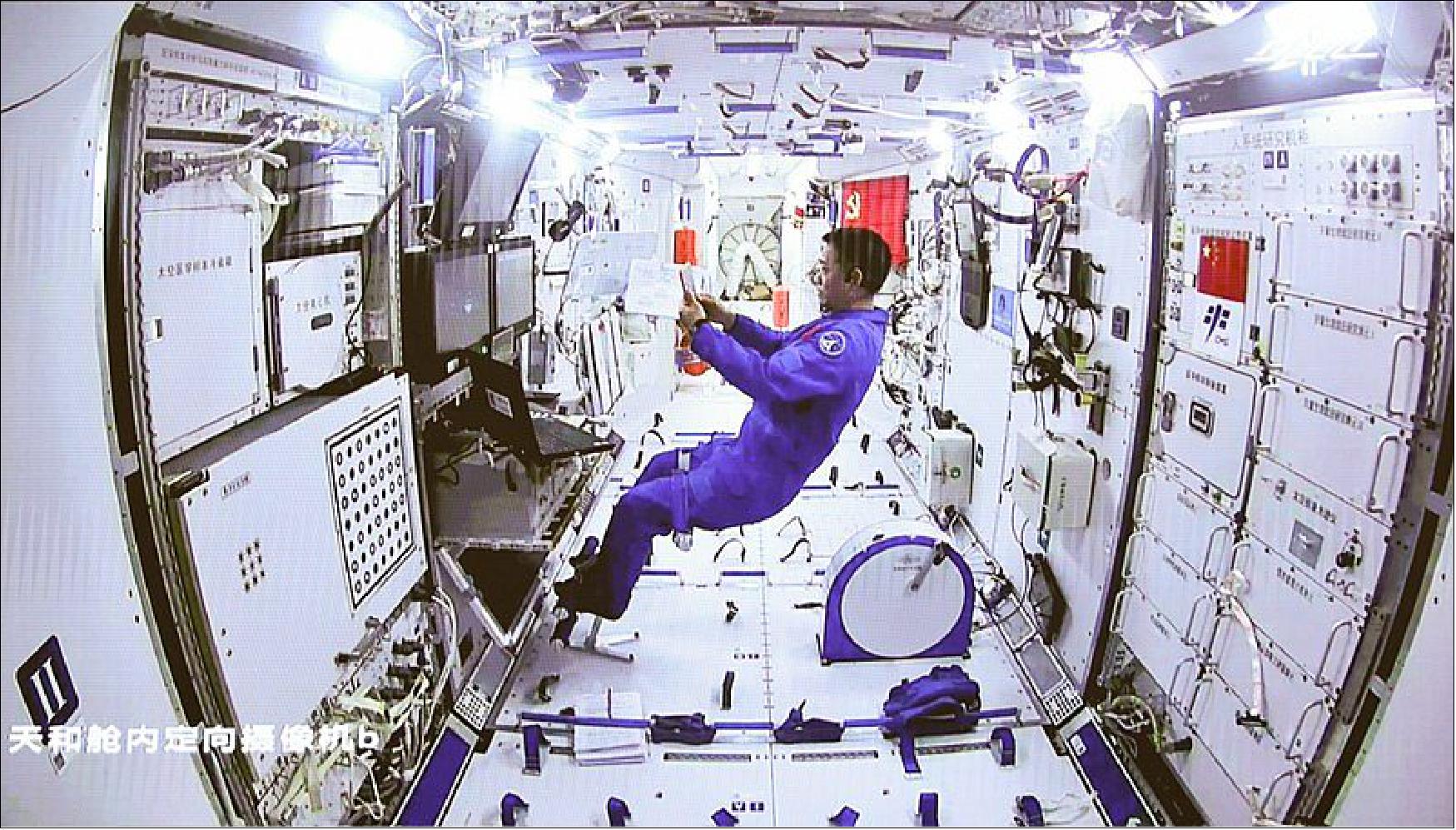
- Before April, the International Space Station (ISS) was the only space laboratory in orbit, and many researchers say Tiangong (or ‘heavenly palace’) is a welcome addition for astronomical and Earth observation, and for studying how microgravity and cosmic radiation affect phenomena such as bacterial growth and fluid mixing.
- However, others argue that crewed space stations are costly, and serve more of a political than a scientific purpose.
- “Increased scientific access to space is of scientific benefit globally, no matter who builds and operates platforms,” says Julie Robinson, chief scientist for human exploration and operations at NASA Headquarters in Washington DC.
- “We need more space stations, because one space station is definitely not enough,” adds Agnieszka Pollo, an astrophysicist at the National Centre for Nuclear Research in Warsaw who is part of a team sending an experiment to study λ-ray bursts.
Open to the World
- The ISS was launched in 1998, as a partnership between space agencies from the United States, Russia, Europe, Japan and Canada (see ‘Variations on a theme’). It has housed more than 3,000 experiments since then, but China is barred from it because of US rules that prohibit NASA from using funds for collaboration with China.
- Although most experiments slated for Tiangong will involve Chinese researchers, China says that its space station will be open to collaboration from all countries, including the United States.
- In June 2019, the CMSA and the United Nations Office for Outer Space Affairs (UNOOSA), which promotes collaboration in space, selected nine experiments — in addition to the 1,000 that China has tentatively approved — to go up once the space station is complete. Simonetta Di Pippo, director of UNOOSA in Vienna, says these involve 23 institutions in 17 nations.
• July 7, 2021: The mechanical arm, installed on China's space station core module Tianhe, has played an important role in assisting the astronauts with their extravehicular activities (EVAs) on Sunday, July 4, 2021. 25)
- The mechanical arm is designed to ensure the safe and reliable operation of the space station in orbit, to help the astronauts in EVAs, such as the assembly, construction, maintenance, and repair of the space station, and support space applications.
- The 10.2-meter-long robotic arm installed on the Tianhe module can carry up to 25 tons of weight. It consists of seven joints, two limbs, two sets of extension gears, two sets of end cameras and end effectors (also known as end-of-arm tooling), one set of central controllers, and an elbow camera.
- With limbs and joints, the mechanical arm can work as a human arm with a shoulder, an elbow, and a wrist. By rotating each joint, it can grasp the equipment and operate at any angle and position.
- "The end effector of the arm can dock with a target adapter installed on the outer surface of the spacecraft. By docking and separation of the end effector and target adapter, the arm can crawl and move on the surface of the space station," said Wang Youyu, a mechanical arm designer at the China Academy of Space Technology (CAST).
- In addition to working independently, the core module arm can also combine with the mechanical arms installed on the lab modules, which will likely be launched next year. The combined arm can reach a working diameter of 15 meters.
Space Construction
- With a design life of 15 years, load capacity of 25 tons, and tip positioning accuracy of 45 mm, the mechanical arm installed on the Tianhe module can realize long-range, large-load operations and small-range, detailed operations.
- The arm is designed for module transposition, astronauts' EVAs, extravehicular cargo handling, space station status inspection, and maintenance of large equipment, the CAST said.
- For example, two lab modules will dock with the core module and form a T-shape complex. Restricted by the attitude control of the lab modules, they can't directly dock with the side docking ports of the core module.
- Instead, each lab module has to dock with the front docking port of the core module, and then a smaller mechanical arm moves it to dock with the side port. The arm installed on the core module can also do the job as a backup.
- Yang Hong, the chief designer of the space station at the CAST, said when a spacecraft is approaching to dock or in need of repair, maintenance, and supplies, the large-scale arm in the core module can help to secure the spacecraft and facilitate the procedure. The space station can be viewed as a homeport in space.
Astronaut Helper
- The mechanical arm would reduce the burden of astronauts in extravehicular missions as much as possible, said Yang.
- The end effector can dock with a foot restraint platform, where astronauts can stand. They can use the arm to send themselves to required locations.
- "It can transfer the astronauts in a wide range so that they can easily reach the operation position during EVAs," he added.
- The arm integrates mechanical engineering, mechanics, material, control, electronics, information, vision, and computer sciences technologies. With the ability of precise operation and visual recognition, it is capable of autonomous analysis and remotely controlled by astronauts.
- Besides EVAs, the arm can also help astronauts transfer the solar wings of the core module and install the payloads on the outer surface of the station.
- Equipped with cameras on the two ends and the elbow, it can also carry out extravehicular examinations for the astronauts.
- "There are several areas on the station that need to be regularly checked by the robotic arm," said Hu Chengwei, another mechanical arm designer at the CAST.
- For instance, before the launch of the Tianzhou-2 cargo craft, we used it to monitor and evaluate the condition of the rear docking port of the core module in preparation for docking with Tianzhou-2," he added.
• July 4, 2021: Two Shenzhou-12 astronauts conducted a spacewalk late Saturday (July 3) to carry to install equipment required for the long-term operation of China’s space station. 26)
- Liu Boming opened the hatch of the Tianhe module at 8:11 p.m. Eastern July 3 and was later joined outside by Tang Hongbo. Activities were completed at 2:57 a.m. July 4, according to the China Manned Space Agency (CMSA).
- Wearing new-generation Feitian extravehicular activity suits the pair worked outside Tianhe while orbiting around 380 kilometers above the surface of the Earth.
- Liu worked attached to a robotic arm while Tang worked along handrails on Tianhe.
- The astronauts installed foot restraints and an extravehicular working platform on Tianhe’s mechanical arm. They later raised a panoramic camera.
- Shenzhou-12 mission commander Nie Haisheng remained inside Tianhe and operated a small robotic arm to assist his colleagues.
- The spacewalk is China’s second, following nearly 13 years after Zhai Zhigang’s 22-minute EVA during the September 2008 Shenzhou-7 mission.
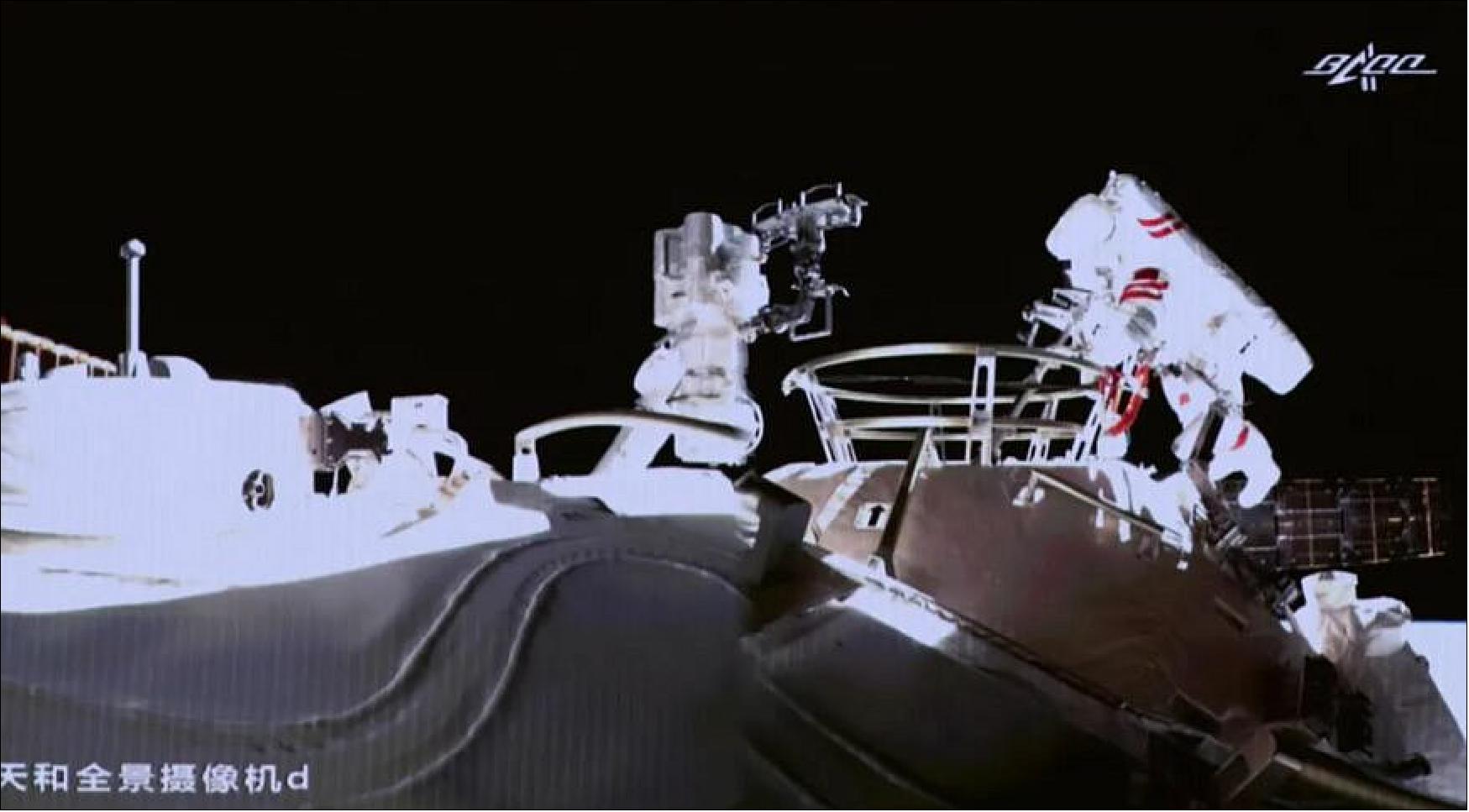
- Footage from the Beijing Aerospace Flight Control Center (BACC) broadcast by CCTV showed multiple angles of Tianhe and the astronauts’ point of view. Communications between Tianhe and the ground are facilitated by Tianlian relay satellites in geostationary orbit.
- Nie assisted Liu and Tang in testing the Feitian suits July 1 in preparation for the spacewalk. They also checked the Tianhe docking hub which contains an EVA hatch.
- A second spacewalk is planned to be conducted during the three-month-long Shenzhou-12 expedition to Tianhe.
- Tianhe is the first of three modules which will form a T-shaped space station. The 16.6 m long, 4.2 meter diameter module will provide regenerative life support and the main living quarters for astronauts as well as propulsion to maintain orbital altitude.
- Shenzhou-12 docked with Tianhe on June 17, six hours 32 minutes after launch from Jiuquan.
- Shenzhou-13 is being readied for an emergency rapid response launch but is otherwise expected to launch on schedule in October. The Tianzhou-3 cargo spacecraft will deliver supplies for the mission to Tianhe a month earlier.
- Experiment modules named Wentian and Mengtian are expected to launch in 2022. Each will be manipulated into position by Tianhe’s 10.2-meter-long robotic arm.
- Xuntian, a co-orbiting optical, Hubble-class space telescope will launch around 2024. The Chinese space station could also be expanded from three to six modules if main phase construction proceeds as planned.
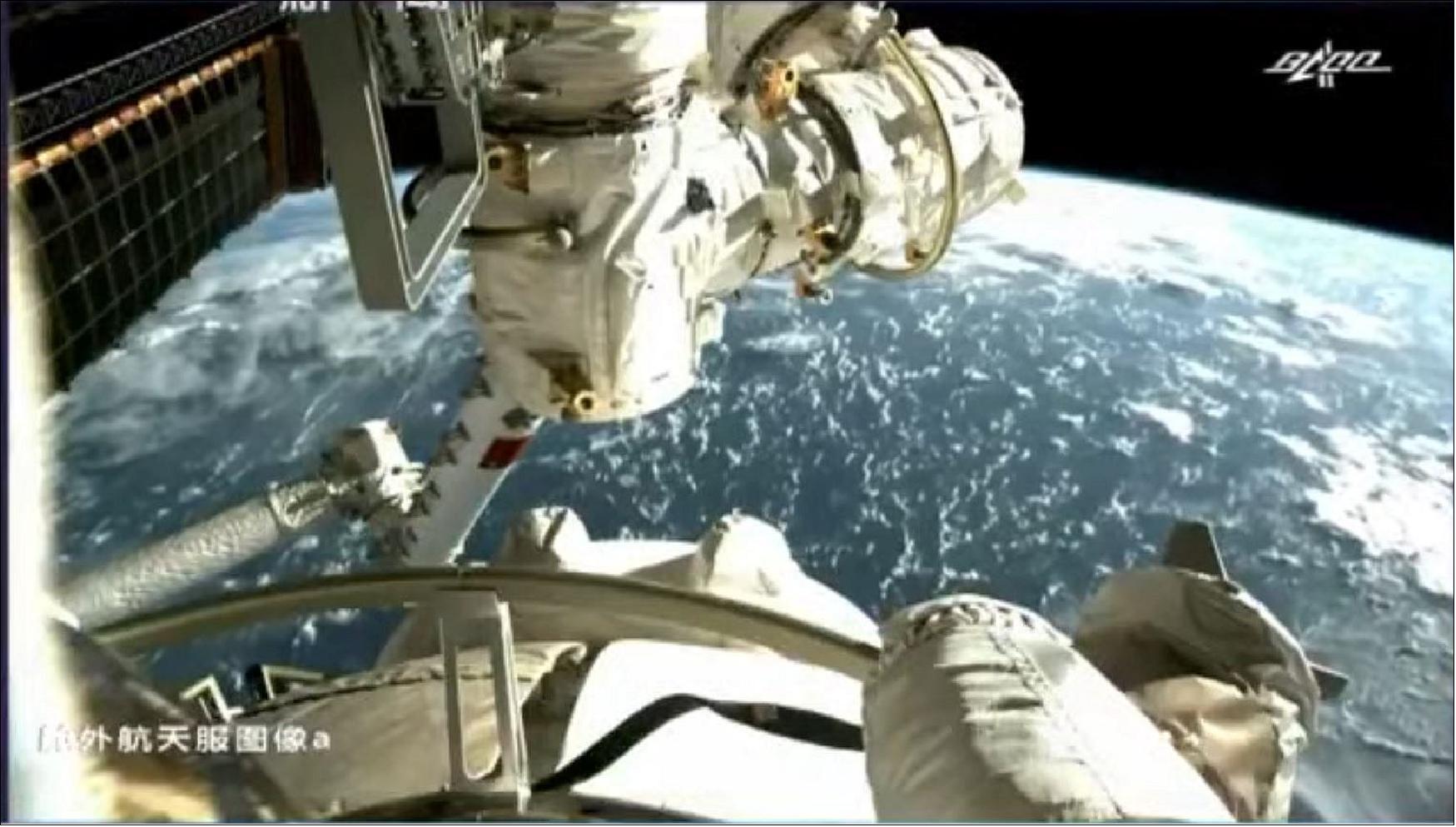
• June 18, 2021: Astronauts on board the core module of China's space station have started to prepare their orbiting residence for operations over the next three months. 27)
- As soon as the three crew members-Major General Nie Haisheng, Major General Liu Boming and Senior Colonel Tang Hongbo-floated into the core module, named Tianhe, or Harmony of Heavens, on Thursday afternoon, they started to configure the electrolytic oxygen generators, install water tanks and arrange their sleeping quarters, according to the China Manned Space Agency.
- After finishing these tasks, they enjoyed their first sleep on board the module, the biggest spacecraft China has built and the first and central section of the permanent space station, called Tiangong, or Heavenly Palace.
- After they woke up on Friday morning, Nie and his crew members started to unpack the Wi-Fi signal equipment and install and set the devices, the agency said in a news release.
- Sun Jun, chief controller of the Tiangong program at the Beijing Aerospace Control Center, said that the Wi-Fi equipment inside the core module is connected through relay satellites with the ground control's communication network. "It enables our astronauts to talk with their family members or colleagues or even make video calls," he said.
- They also entered the Tianzhou-2 cargo spaceship on Friday to begin moving their living materials and mission payloads to the core module.
- Tianzhou- 2, the country's second cargo spaceship, carried 6.8 tons of supplies for Tianhe when it docked with it on May 29, including 2 tons of propellants, more than 160 packages of living and experimental materials as well as two extravehicular suits, each weighing around 100 kg, for astronauts to perform activities outside the core module.
- In the next few days, the crew will continue unpacking gear inside Tianhe and Tianzhou 2 and arranging their living and work quarters. At the same time, the astronauts will conduct internal apparatus tests.
- The crew was transported to Tianhe on Thursday morning (June 17) in the Shenzhou -12 spacecraft by a Long March 2F carrier rocket that blasted off from the Jiuquan Satellite Launch Center in northwestern China, embarking on the nation's seventh manned spaceflight, which will last three months.
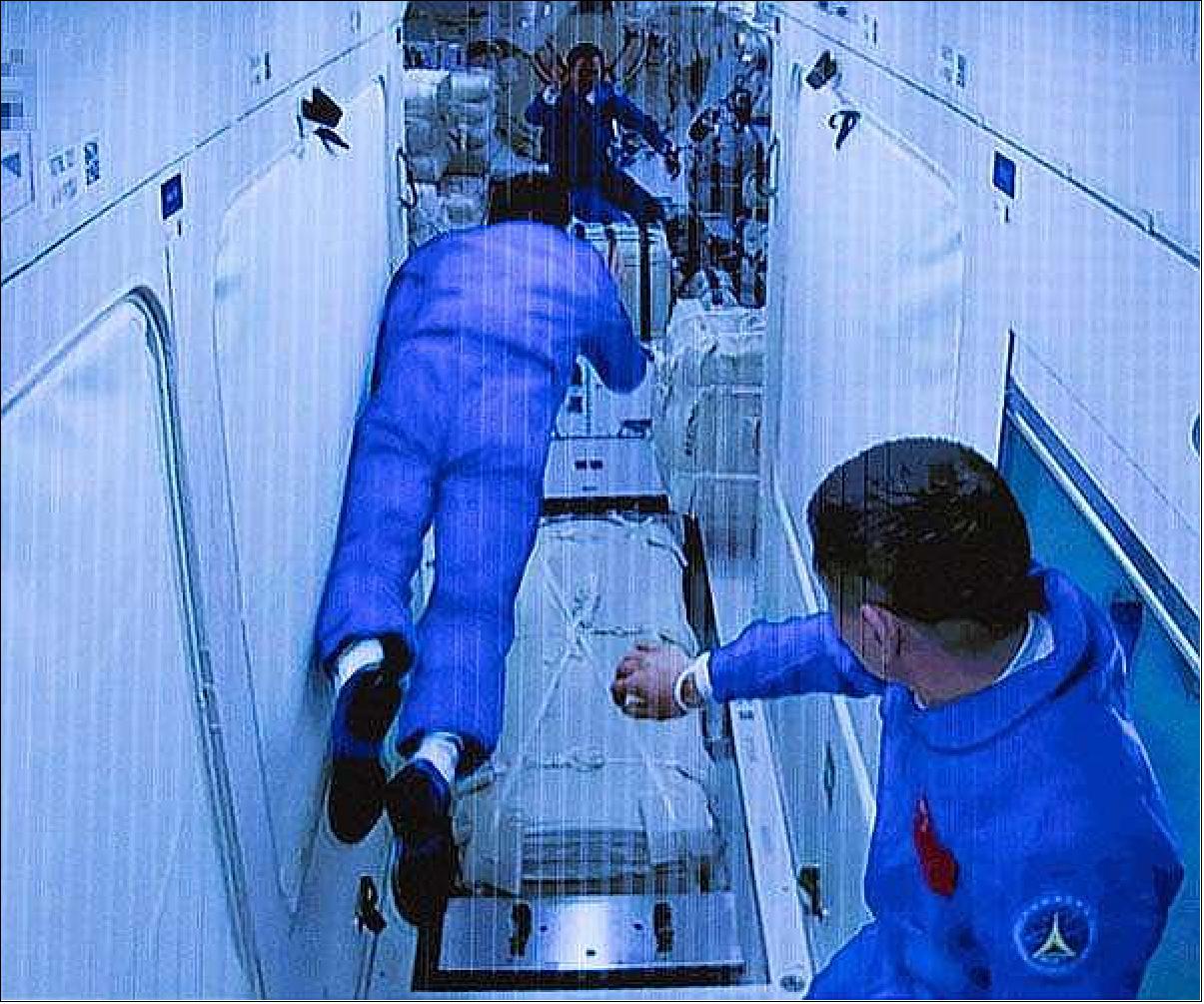
- The Shenzhou-12 mission is part of China's ambitious space station program that aims at completing a three-component station in a low-Earth orbit about 400 km above the ground before the end of 2022.
- In the near future, three manned missions and three robotic cargo flights will be conducted for the station's construction. Two large labs will also be taken into space to link up with the station.
• June 17, 2021: Three Chinese astronauts floated into the country’s new Tiangong space station Thursday, becoming the first people to board China’s outpost in orbit after a successful launch from a military base in the Gobi Desert to start a three-month mission. 28)
- Commander Nie Haisheng led the three-man crew into the space station’s Tianhe core module at 6:48 a.m. EDT (10:48 GMT). Astronauts Liu Boming and Tang Hongbo followed Nie into Tianhe module through hatches leading from their Shenzhou 12 spaceship as the complex soared some 235 miles (380 km) above Earth.
- After taking a few minutes to get situated, the astronauts announced they had safely arrived at the partially-assembled Tiangong station and gave a military salute to officials watching from the ground. Chinese state television broadcast the event on a tape delay.
- The choreographed arrival ceremony capped a long day for the three astronauts, who launched inside their Shenzhou 12 spacecraft on top of a Long March 2F rocket at 9:22:27 p.m. EDT Wednesday (01:22:27 GMT Thursday).
- China’s human spaceflight agency said the Shenzhou-12 capsule completed an automated docking at the forward port of the Tianhe core module at 3:54 a.m. EDT (07:54 GMT), about six-and-a-half hours after launch.
- The rapid rendezvous profile was a first for China’s space program.
- While Chinese state television provided live coverage of the Shenzhou-12 mission’s launch, the docking occurred without any public broadcast. CCTV, China’s state-run TV network, replayed the docking about a half-hour after it happened.
- After equalizing pressure on each side of the passageway between Shenzhou-12 and the Tianhe core module, the astronauts opened hatches and entered the Tiangong station.
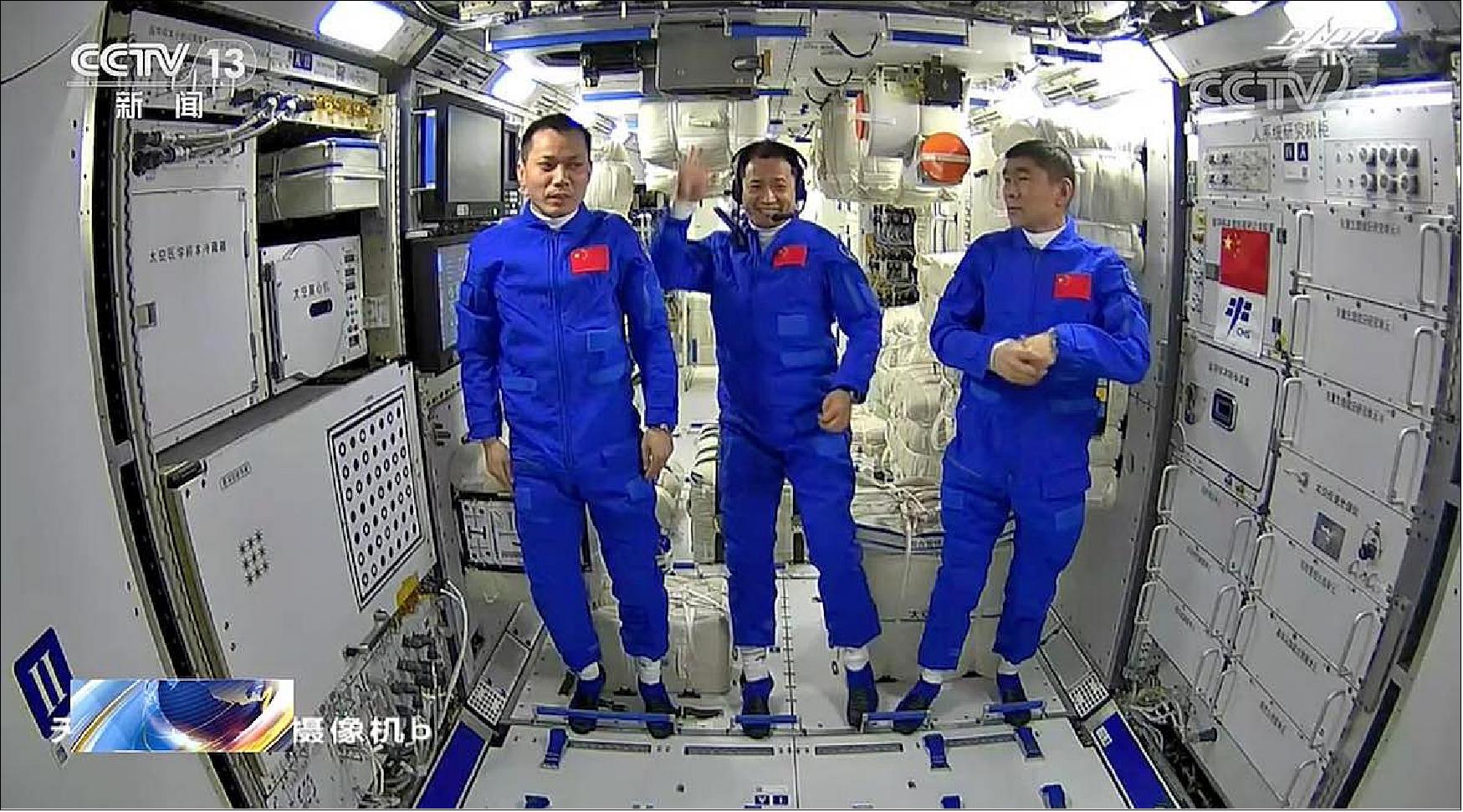
- Nie floated inside the complex first, followed by Liu and Tang.
- The three astronauts will spend the next three months testing systems on-board the station, three times longer than any previous Chinese human spaceflight mission.
- In total, China has now launched 12 astronauts into orbit on seven crewed Shenzhou missions since 2003.
- One major task for the Shenzhou-12 astronauts will be to check the performance of Tiangong’s regenerative life support system, which produces breathing oxygen through electrolysis and recycles urine to make drinking water.
- “This way, we have closed-loop resource to draw upon which can greatly reduce dependence on ground supplies, and of course increase the economic efficiency of the space station,” said Zhou Jianping, chief designed for China’s human spaceflight program.
- Nie, a 56-year-old veteran of two previous Shenzhou missions in 2005 and 2013, leads the three-man crew. Nie logged more than 19 days in orbit on his first two spaceflights.
- Speaking to Chinese media before the launch, Nie said the Shenzhou-12 mission’s objectives of activating and outfitting the Tiangong station will make for challenging work.
- “We will work together to conquer all of those difficulties, and I am convinced that with the best wishes of my counterparts in China, and the solid preparation, and (our) training, we are capable of accomplishing this task,” Nie said.
- “This space station is quite big in size, so this flight mission lasts longer,” he said. “We are taking a lot of things for entertainment ... We will certainly show you all of those items we bring.”
• June 17, 2021: NASA Administrator Bill Nelson released the following statement Thursday regarding the China National Space Agency’s launch of the first crew to its Tiangong space station: “Congratulations to China on the successful launch of crew to their space station! I look forward to the scientific discoveries to come.” 29)
• June 17, 2021: The Shenzhou-12 spacecraft docked with China’s space station module hours after launch from Jiuquan late Wednesday, marking the first crewed visit to the facility. 30)
- Shenzhou-12 and its crew of three launched on a Long March 2F from the Jiuquan Satellite Launch Center (JSLC) on June 17 at 01:22 UTC (9:22 p.m. EDT on June 16).
- The spacecraft docked with the Tianhe space station core module at 3:54 a.m. EDT (11:54 UTC) on June 17, six hours 32 minutes after launch, the China Manned Space Engineering Office confirmed.
- Astronauts Nie Haisheng, Liu Boming and Tang Hongbo will spend three months aboard the 16.6-meter-long, 4.2-meter-diameter Tianhe (“harmony of the heavens”) module.
- The Shenzhou-12 mission objectives include extravehicular activities using EVA suits delivered by Tianzhou-2, testing performance of a large robotic arm and verification of a regenerative life support system.
- The crewed mission is the third of 11 launches planned for the construction of the three-module Chinese Space Station. The Shenzhou-12 docking was also China’s first autonomous rapid rendezvous and docking while carrying crew.
- The outpost is currently in a 375 x 385 km altitude orbit inclined by 41.5º in order to be suitable for visits from Jiuquan.
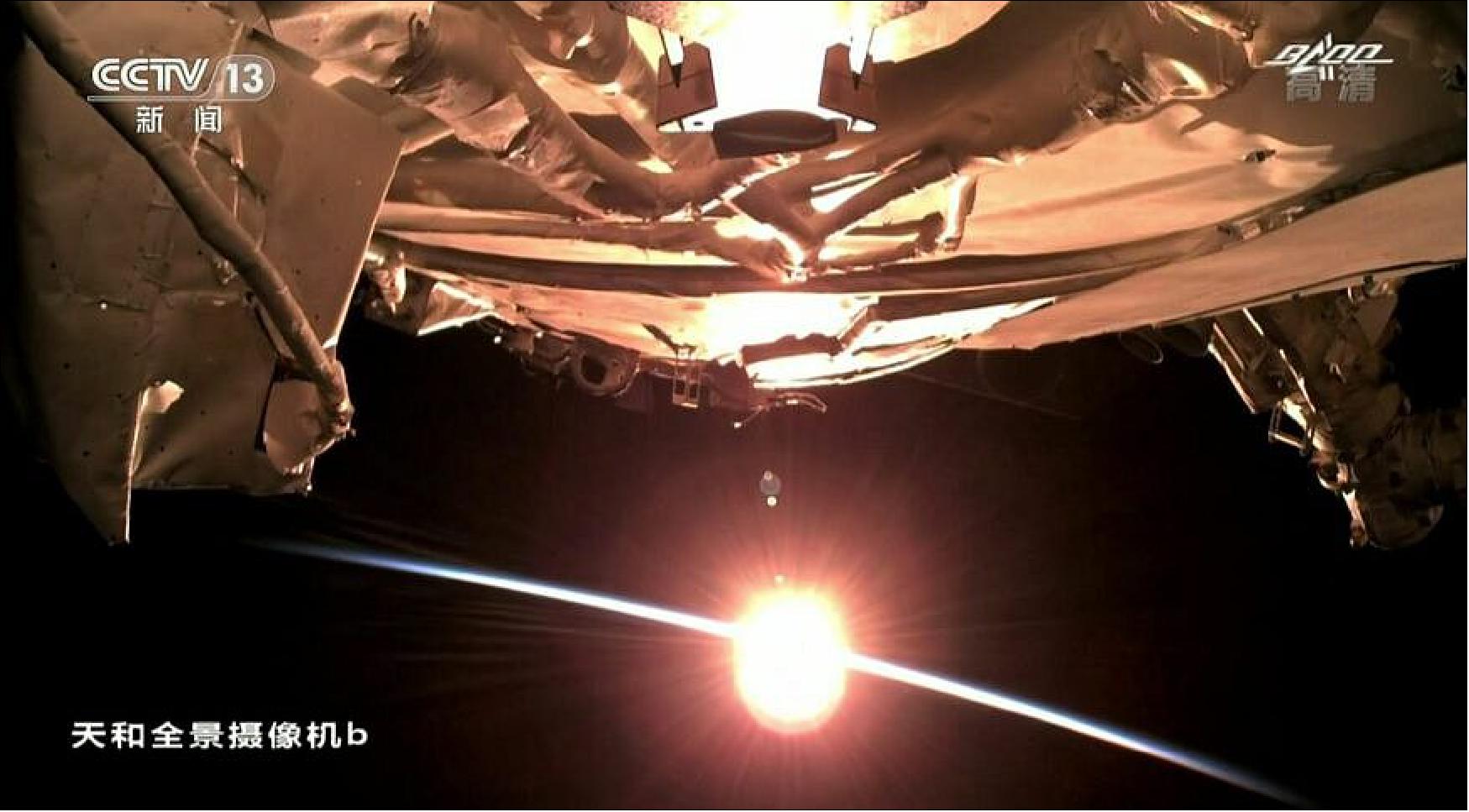
- Tianhe was launched into orbit late April, marking the start of the construction phase of a Chinese space station project first approved in 1992. The Tianzhou-2 cargo spacecraft launched to Tianhe in late May, carrying 4.69 tons of cargo in a pressurized segment to supply the Shenzhou-12 mission. The Shenzhou spacecraft itself carries five days of supplies for the crew.
- Shenzhou-12 is commanded by Nie Haisheng, 56, a veteran of the Shenzhou-6 and Shenzhou-10 missions. Also on the mission are Liu Boming, 54, who participated in Shenzhou-7, and Tang Hongbo, 45, making his first flight to space.
- The mission is China’s seventh crewed flight. It is planned to far surpass the Chinese human spaceflight duration record of 33 days set by Shenzhou-11 in 2016.
- “The training is hard and demanding, as the neutral-buoyancy training is carried out 10 meters under the water at 0.4 atmospheric pressure. The suit is heavy, so that it takes a lot of physical strength even to move hands, bend our arms, loosen a screw, or install something,” Nie said ahead of launch.
- “We’ve been preparing for the Shenzhou-12 mission for more than a year, and I think we are capable of the mission and I’m fully confident about fulfilling the mission.”
- When the astronauts pass through into Tianhe it will mark the first time since May 2000 that two orbiting space stations will be simultaneously inhabited, when STS-101 and Soyuz TM-30 visited the ISS and Mir respectively. Three Shenzhou flights to small Tiangong space labs took place in 2012, 2013 and 2016—concurrent with permanent ISS habitation—as stepping stone missions towards the larger space station modules.
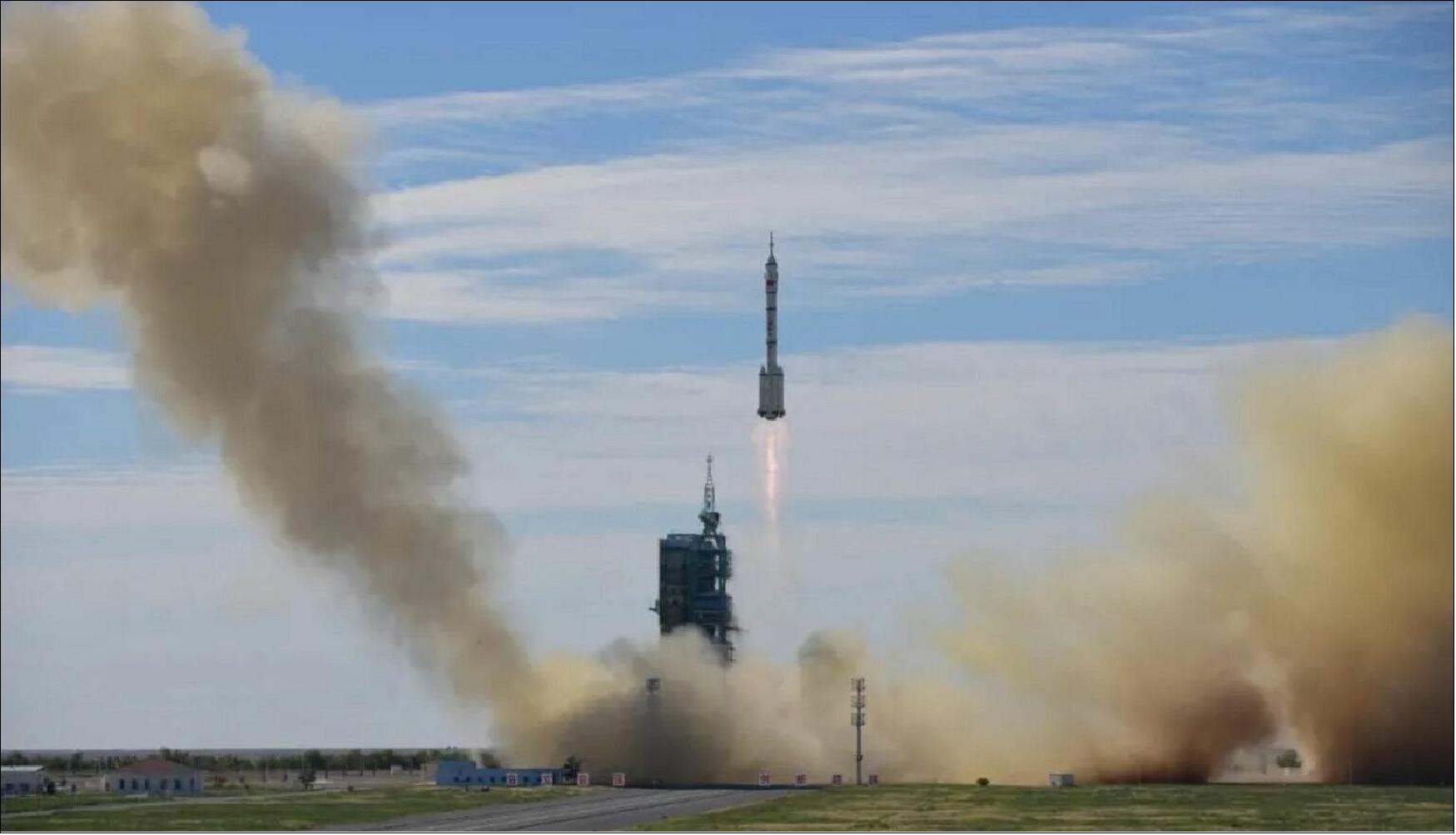
- The China Academy of Space Technology (CAST) has a ground version of Tianhe to be able to test and generate flight programs to solve potential malfunctions experienced by the orbiting core module.
- The Tianzhou-3 cargo spacecraft and Shenzhou-13 crewed missions will follow in September and October, respectively.
- Experiment modules named Wentian and Mengtian are expected to launch in 2022. The pair of 22-ton modules will host a plethora of experiments in areas including astronomy, space medicine, space life science, biotechnology, microgravity fluid physics, microgravity combustion and space technologies.
- International science payloads will also fly to the space station, through cooperation between the United Nations Office for Outer Space Affairs (UNOOSA) and the CMSEO (China Manned Space Engineering Office). Foreign astronauts are also expected to visit the CSS.
• June 15, 2021: Highly efficient power supply has kept the combination of the Tianzhou-2 cargo craft and China's space station core module Tianhe operating stably. 31)
- China sent into space the Tianhe module on April 29, kicking off a series of key launch missions that aim to complete the construction of the space station by the end of 2022.
- The country launched Tianzhou-2 on May 29, which successfully docked with Tianhe in about eight hours to deliver supplies, equipment and propellant.
- Both the core module and cargo craft are equipped with independent power supply systems. After docking, the two systems can form a connected grid and achieve mutual transmission of electric power.
- "The two independent systems work like two smartphones," said Yu Lei, an engineer in charge of power supply to the Tianzhou-2 project. "They can undergo both separate and mutual charging."
- When docking with the space station, Tianzhou-2 is in sleep mode and has relatively lower power demand. Its solar panels can provide abundant power most of the time, and the surplus is stored to be used for astronaut activities and scientific research that requires higher energy consumption.
- "Its solar panels not only fulfill the power demand of Tianzhou-2 directly, but also charge its batteries," said Wang Zhenxu, a designer of the power supply system of the Tianzhou-2 project.
- Researchers estimate that it takes 91 minutes for the space station to go around Earth in the low-Earth orbit, during which it can receive sunlight for about 54 minutes. The solar panels thus experience the light-shade cycle about 16 times every day.
- The three sets of lithium ion batteries power the entire cargo craft when the combination enters the shadow areas. The solar panels work again after it moves into the sunlight, and continue supplying power and charging.
- The core module Tianhe is powered by third-generation flexible GaAs (gallium arsenide) solar panels, which provide high power output, are light, small when folded, have long in-orbit life, and can be repeatedly folded and unfolded.
- The thickness of a solar panel is less than one millimeter, only half of the weight per unit area of the traditional solar arrays.
- The power area of Tianhe's solar panels covers 80 square meters, which can provide 20 KW power to the core module, said Yu Hui, designer of the solar panels.
- The researchers carried out a large number of ground simulation tests to verify the environmental protection technology used in the solar panels to help them endure almost 90,000 high and low temperature alternating cycles ranging from 100 to minus 100 degrees Celsius in orbit as well as the complex space environment.
- The design life of the solar panels is up to 15 years, and they can work effectively for the space station project, Yu Hui said.
• May 19, 2021: NASA Administrator Bill Nelson issued the following statement Wednesday after the China National Space Administration’s release of the first photos from the Zhurong Mars rover: 32)
- “Congratulations to the China National Space Administration on receiving the first images from the Zhurong Mars rover!” Nelson said. “As the international scientific community of robotic explorers on Mars grows, the United States and the world look forward to the discoveries Zhurong will make to advance humanity’s knowledge of the Red Planet. I look forward to future international discoveries, which will help inform and develop the capabilities needed to land human boots on Mars.”
- CNSA’s successful landing of the Zhurong rover last week makes it only the second nation to ever land successfully on Mars. Zhurong joins active NASA missions – the Curiosity and Perseverance rovers and Insight Lander – in exploring the surface of the Red Planet.
• May 19, 2021: China's core space station module Tianhe has recently completed its platform function tests and entered the orbit to rendezvous and dock with the Tianzhou-2 cargo spacecraft, according to the China Manned Space Agency (CMSA) on Tuesday. 33)
- The core module, which was sent into orbit on April 29, has recently completed platform function tests for rendezvous and docking, astronaut stay and the mechanical arms, as well as in-orbit performance checks for space application project equipment.
- The CMSA said the core module's various functions are normal. It is operating in good condition and has entered the orbit for rendezvous and docking. It will continue its preparations for rendezvous and docking with the Tianzhou-2 cargo spacecraft.
• May 9, 2021: Debris from a large Chinese rocket stage fell into the Indian Ocean late 8 May EDT as people around the world watched for signs of the fiery reentry event in the skies. 34)
- Remnants from the roughly 30-meter-long, five-meter-wide empty core stage of the Long March 5B fell into the Indian Ocean at 10:24 p.m. EDT (10:24 a.m. Beijing Time) close to longitude 72.47º east and latitude 2.65º north, China’s human spaceflight agency, CMSEO (China Manned Space Engineering Office), announced.
- Data from the U.S. Space Force’s 18th Space Control Squadron space tracking later confirmed reentry occurred at approximately 10:15 p.m. EDT over the Arabian Peninsula, adding that “It is unknown if the debris impacted land or water.”
- Sightings and videos were posted on social media platforms May 8 as the rocket began its last orbits around the Earth.
- The Long March 5B successfully launched China’s first space station module directly into low Earth orbit April 28 EDT.
- Unusually for a first stage the rocket body had entered and remained in orbit following launch, and would become one of the largest instances of uncontrolled reentry of a spacecraft in decades. While the 22.5-ton Tianhe core module used its own propulsion to raise its orbit, the orbit of the first stage began to decay due to atmospheric drag.
- The size of the stage, travelling at 7.8 km/s and orbiting once every 90 minutes between 41.5º north and 41.5º south latitude, quickly became a matter of both space industry and public interest.
• May 4, 2021: A large rocket stage which launched China’s first space station last week is likely to reenter the atmosphere around May 8 according to early space tracking predictions. 35)
- U.S. Department of Defense Spokesperson Mike Howard in a statement May 4 said that “U.S. Space Command is aware of and tracking the location of the Chinese Long March 5B in space, but its exact entry point into the Earth’s atmosphere cannot be pinpointed until within hours of its reentry, which is expected around May 8.”
- “Until then, the 18th Space Control Squadron will be offering daily updates to the rocket body’s location on www.space-track.org beginning May 4. We will provide additional information as it becomes available,” the statement read.
- The launch of the Long March 5B late April 28 EDT successfully placed the 22.5-metric-ton Tianhe core module into orbit. However, the roughly 30-meter-long, 5-meter-diameter Long March 5B first stage also reached orbital velocity rather than fall with a predetermined area downrange.
- The empty rocket body is now in a 162 by 306-kilometer altitude orbit according to U.S. 18th Space Control Squadron space tracking, down from an initial 170 by 372-kilometer orbit.
- Without the ability to restart its engines the core stage will be dragged towards Earth by increasing collisions with molecules in the Earth’s atmosphere. Atmospheric fluctuations and other variables and the high velocity of the stage mean that accurate predictions of when and where the stage will reenter are not possible until a few hours before the event.
- The Long March 5B core stage’s orbital inclination of 41.5 degrees means the rocket body passes a little farther north than New York, Madrid and Beijing and as far south as southern Chile and Wellington, New Zealand, and could make its reentry at any point within this area.
Tianzhou Supply Missions to the CSS (Chinese Space Station)
• October 15, 2021: A second crew of three astronauts are heading for China’s Tianhe space station module after the successful launch of the Shenzhou-13 mission Friday. 36)
- A Long March 2F lifted off from the Jiuquan Satellite Launch Center in the Gobi Desert at 12:23 EDT (16:23 UTC) on Oct. 15. The rocket, with four side boosters, two stages and a launch escape system, rose from the LC43/91 launch complex into the black skies above Jiuquan after midnight local time.
- Applause followed in mission control after each major launch event, culminating in Shenzhou-13 separating from the second stage, entering orbit and deploying its solar arrays.
- Commander Zhai Zhigang and colleagues Wang Yaping and Ye Guangfu make up the crew of the three-module Shenzhou-13. The spacecraft is now due to attempt a radial rendezvous with Tianhe within the next eight hours and dock at the Tianhe module’s nadir port.
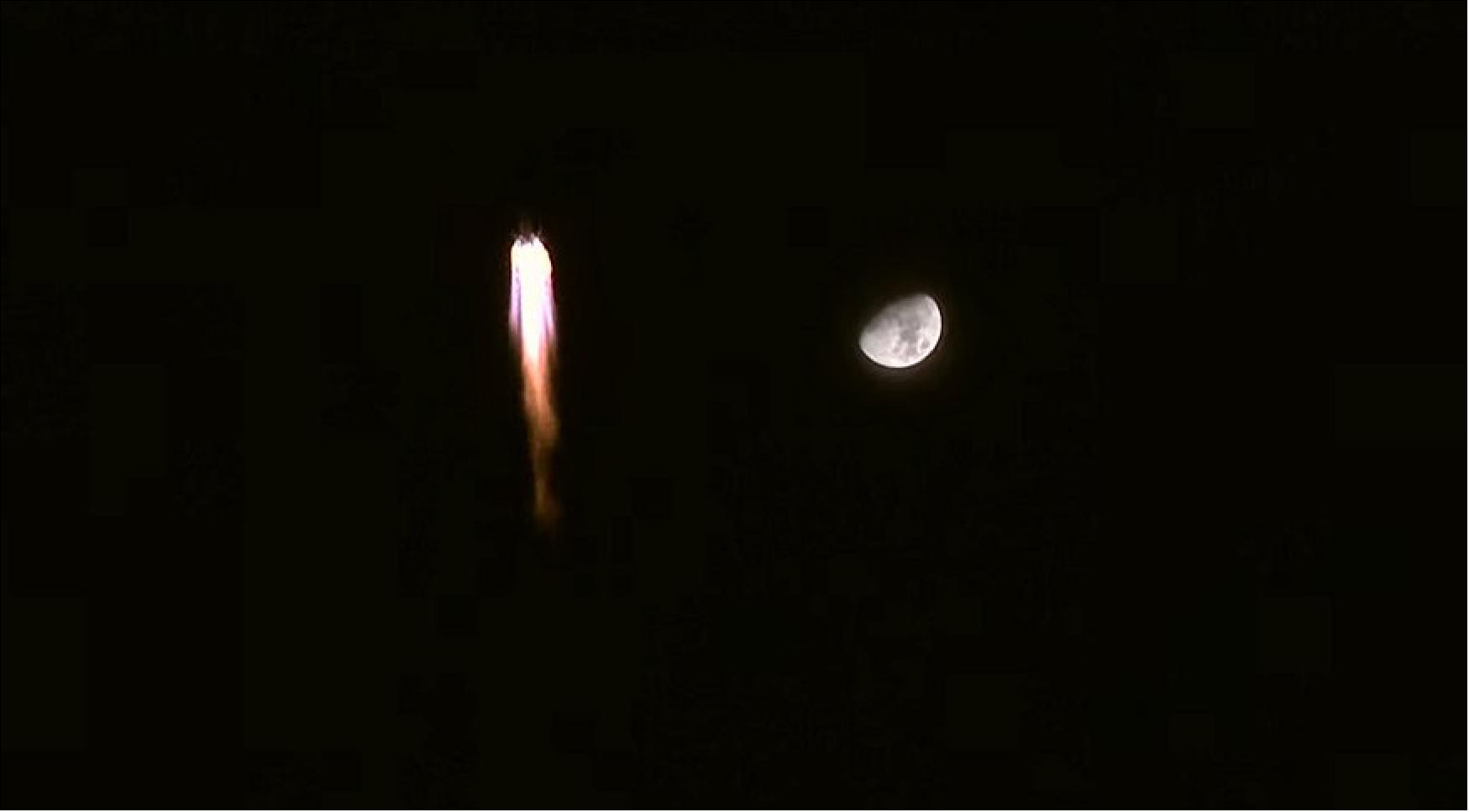
- The trio are expected to stay aboard the 16.6-meter-long, 4.2-meter-diameter Tianhe for six months, which would be China’s longest by three months.
- Major mission objectives include conducting two or three extravehicular activities, installing an adaptor to combine large and small robotic arms and carrying out a range of medicine and physics-related experiments.
- Wang Yaping, 41, is also expected to deliver a live educational lecture from orbit, following on from her first such session during 2013’s Shenzhou-10 mission.
- Zhai, 55, took part in China’s first spacewalk during Shenzhou-7 in 2008. In an Oct. 14 press conference he expressed confidence but also felt a sense of pressure.
- “Now 13 years later, I will conduct another space mission. Apart from excitement, I am feeling pressure. But our Shenzhou-13 crew will remain true to our original aspiration and keep our mission firmly in mind, and do all we can to live up to our country’s and people’s expectations. We have the confidence and ability to accomplish this mission successfully,” Zhai said.
- Ye Guangfu, 41, is making his first trip to space. Ye participated in ESA’s 2016 CAVES analogue exploration training with European, Russian, Japanese and American astronaut colleagues. ESA’s Loredana Bessone told SpaceNews that Ye integrated well and took responsibility to lead the cave survey segment, and as such got to name a newly discovered branch “Guang Ming”.
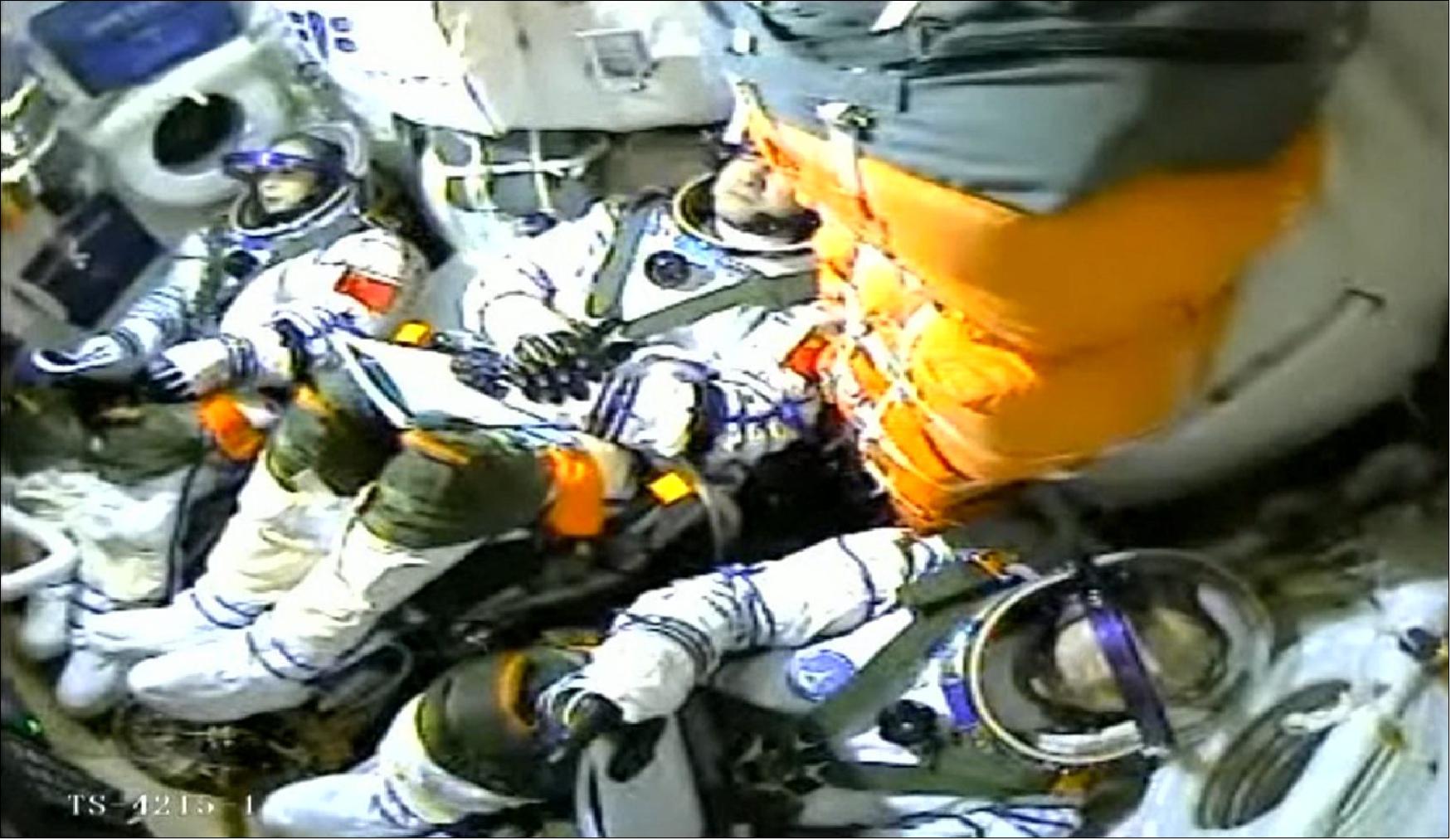
- So far in 2021 China’s first interplanetary mission entered Mars orbit and landed a rover on the Red Planet, as well as launching five space station missions. A recent analysis of Chang’e-5 lunar sample-return mission material confirms the spacecraft collected the youngest lunar samples so far, announced plans for a joint International Lunar Research Station, while a second, highly-secretive spaceplane launch has also been conducted.
Preparing for New Space Station Modules
- Two cargo spacecraft, Tianzhou-2 and Tianzhou-3, are currently docked at Tianhe’s forward and aft docking ports. Tianzhou-2 will be used for a test of the ability of Tianhe’s robotic arm to manipulate future modules and transfer these from the forward to lateral docking ports.
- Tianzhou-3 launched Sept. 20 to deliver nearly 6,000 kg of provisions, equipment and experiments for the Shenzhou-13 mission.
- The 22.5-ton Tianhe launched late April and is the first module of an initial three planned modules to make up the Chinese space station. The first crewed mission, Shenzhou-12, visited from June to September.
- Experiment modules Wentian and Mengtian are planned to launch in 2022 following the Shenzhou-14 mission, which will follow completion of Shenzhou-13 and launch of Tianzhou-4.
- China approved “Project 921” in September 1992, setting out the goals of developing human spaceflight capabilities and eventually constructing a low Earth orbit space station.
- Yang Liwei launched on Shenzhou-5 in October 2003 to make China only the third country to achieve independent human spaceflight. Two 8.2-ton Tiangong space labs were used for on-orbit rendezvous and docking tests and life support during short crewed visits.
- Today’s mission is only China’s eighth crewed launch, but regular six-month missions will become the norm as China first tests, constructs and operates the Tiangong space station complex.
- The launch is the second crewed Long March 2F mission of 2021 and 35th Long March launch of the year. China’s main space contractor has planned more than 40 launches in 2021.
• September 20, 2021: China’s Tianzhou-3 cargo spacecraft docked in orbit with the Tianhe space station module Monday following launch from the coastal Wenchang launch center. 37)
- A Long March 7 rocket lifted off from Wenchang LC-2 at 3:10 a.m. EDT (07:10 UTC) September 20. Tianzhou-3 separated from the second stage after 597 seconds, having entered orbit and on track to catch up with Tianhe.
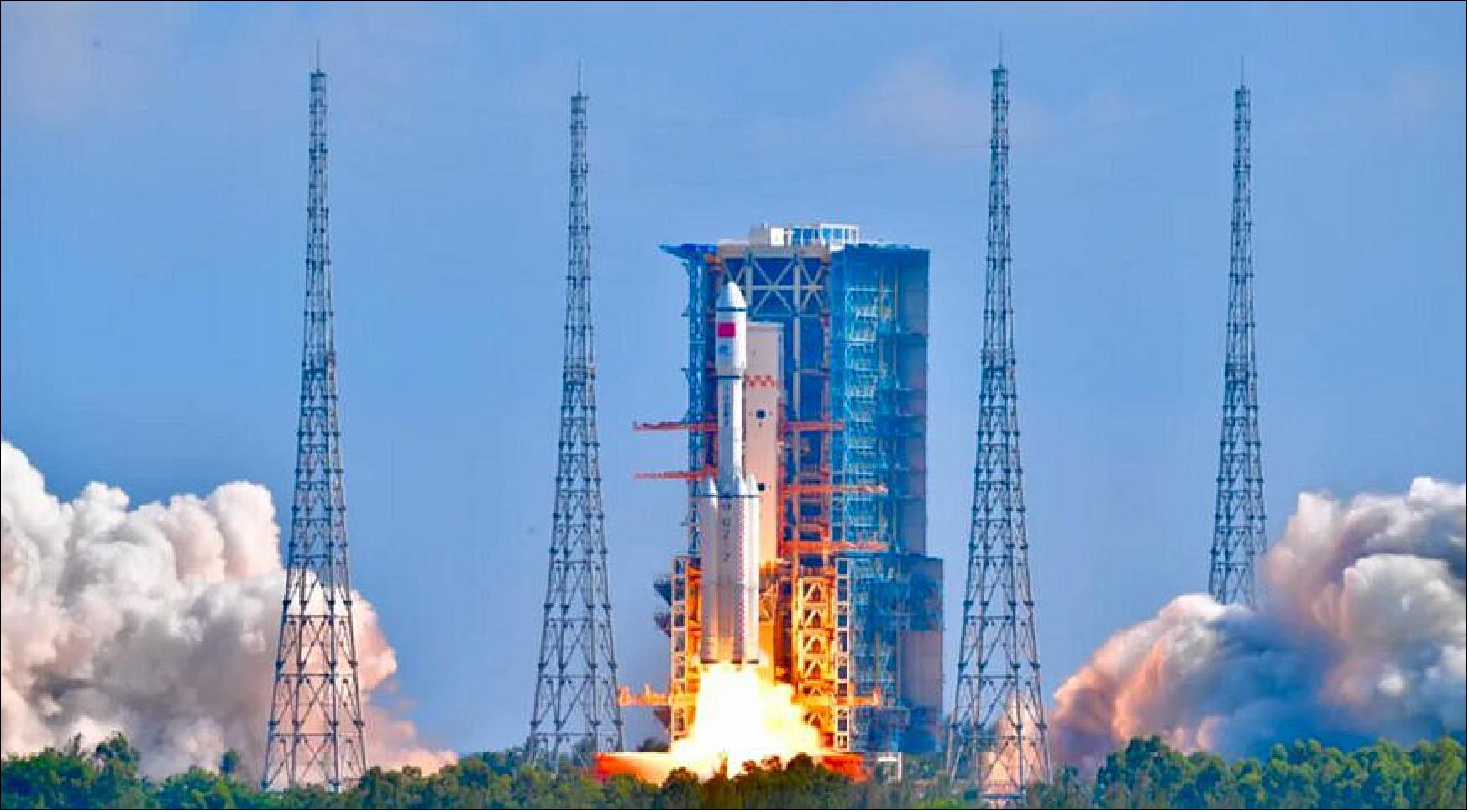
- Deng Hongqin, director of the Xichang Satellite Launch Center, which administers Wenchang, declared the launch was a complete success during live coverage.
- The uncrewed Tianzhou-3 spacecraft completed automated rapid rendezvous and docking maneuvers with Tianhe just under seven hours later at 10:08 p.m. EDT, CCTV reported. The spacecraft used six orbital maneuvers after reaching orbit to approach Tianhe.
- Tianzhou-3 is carrying around six tons of supplies for the upcoming crewed Shenzhou-13 mission as construction of China’s space station continues. The cargo consists mainly of fresh provisions for astronauts for what will be China’s longest human spaceflight mission yet. Other payloads include experiments and equipment.
- The six-month-long Shenzhou-13 mission will launch from Jiuquan in the Gobi Desert as soon as early October. The spacecraft and its Long March 2F rocket have been in a state of readiness at Jiuquan for some time to allow possible rapid response to an emergency in orbit.
- The crew is rumored to include one of China’s two women astronauts. Wang Yaping, a veteran of 2013’s Shenzhou-10 mission, is in training for space station missions.
- The Tianzhou-3 mission is the fourth for construction of the Chinese space station. Tianhe, the station’s 22.5-ton first module, launched late April 28 and is currently in a 386 x 380 km orbit inclined by 41.5 degrees.
- The first crewed mission, Shenzhou-12, returned to Earth Sept. 17 following 90 days docked with Tianhe. Following this the Tianzhou-2 spacecraft, which provided supplies and equipment for the crew, undocked from Tianhe’s aft port on Saturday and carried out circumnavigation and forward docking maneuvers, making way for Tianzhou-3.
- Tianzhou-2 and Tianzhou-3 will remain docked with 16.6-meter-long, 4.2-meter-diameter Tianhe (“harmony of the heavens”) until after the arrival of Shenzhou-13.
- This requires the Shenzhou spacecraft to complete a radial, or R-Bar, rendezvous and docking with Tianhe’s nadir docking port. In preparation for this step Shenzhou-12 tested the relatively more challenging radial rendezvous without docking before returning to Earth. The spacecraft approached to and stopped at distances of 200 and 19 meters.
- Tianzhou-2 will be used for a verification test of the space station’s main robotic arm before deorbiting. The arm will test its ability to manipulate modules to the lateral rings of the Tianhe docking hub.
- China has planned 11 missions to complete the three-module, 66-metric-ton Tiangong Chinese space station by the end of 2022. Tianzhou-3 and Shenzhou-13 will be the final two of the technology verification phase.
- Key technology verification includes testing systems such as regenerative life support, radial rendezvous, robotic arm, solar energy systems, propellant transfer at forward and aft docking ports and executing extravehicular activities.
- Unofficial projections have Shenzhou-13 running from October to March 2022. The Tianzhou-4 supply mission would then follow in around a month later, with Shenzhou-14 lifting off in May 2022. This crewed mission will oversee the main construction developments for the space station.
- The two experiment modules, Wentian and Mengtian, are to launch May-June and August-September 2022, respectively. Finally, Tianzhou-5 would launch in October in preparation for Shenzhou-15 in November 2022, completing the construction phase.
- China has hinted at plans to extend the Tiangong complex to six modules. The expansion would utilize backup modules or potentially include an international contribution.
• September 17, 2021: Three Chinese astronauts safely returned to Earth Sept. 17 after completing the first crewed mission aboard the Tianhe space station module. 38)
- Commander Nie Haisheng, Liu Boming and Tang Hongbo touched down inside the designated landing zone near Dongfeng in the Gobi Desert, Inner Mongolia, at around 1:34 a.m. EDT Friday.
- The main, 1,200 m2 parachute opened around 10 km above the ground, with the heat shield jettisoned at around 5.5 km up. The landing occurred within the time and area indicated by airspace closure notices issued earlier in the week. Ground search and rescue teams swiftly located and secured the capsule after touchdown.
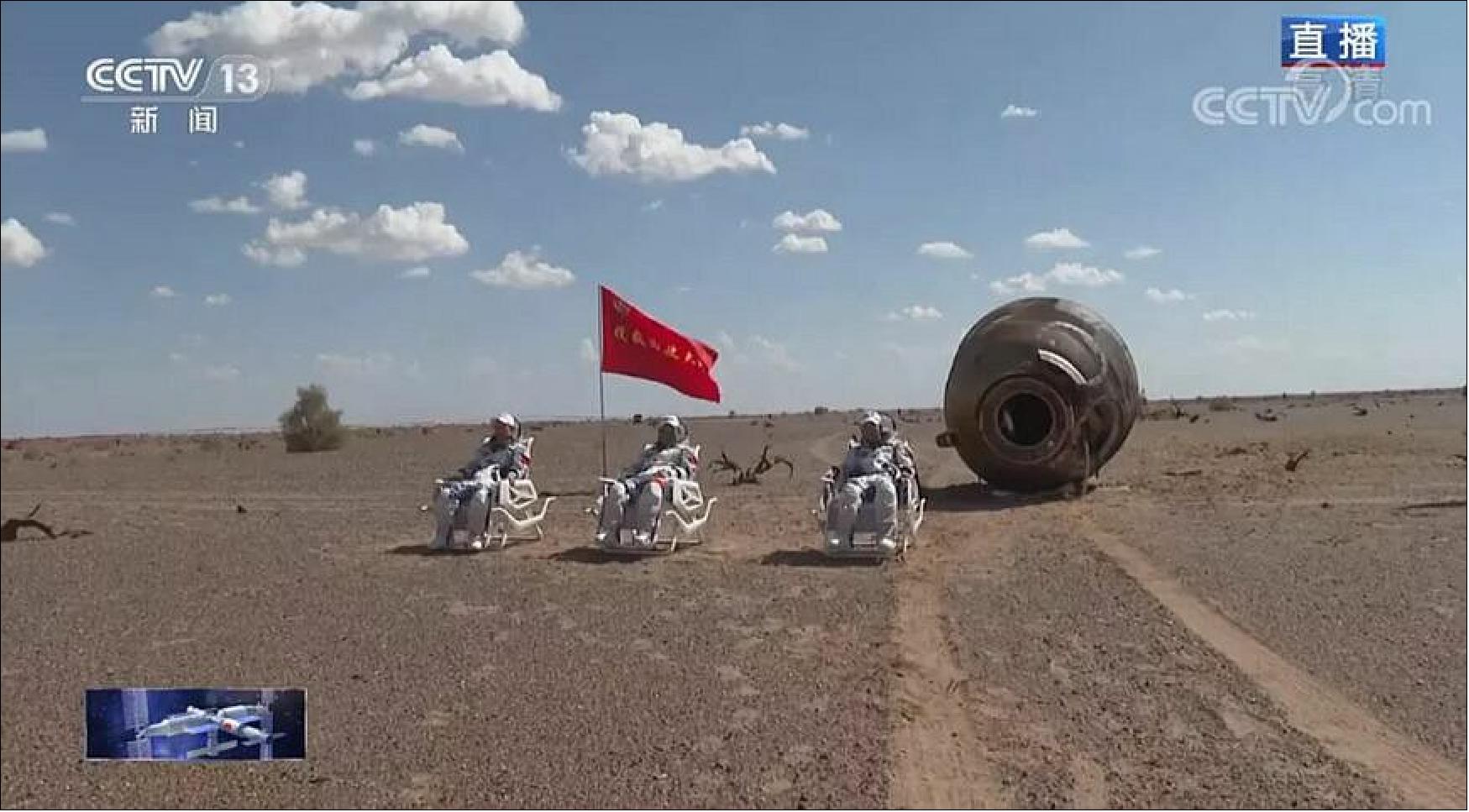
- The Beijing Aerospace Flight Control Center declared the Shenzhou-12 a “complete success.”
- The three Shenzhou-12 astronauts had on Wednesday completed a 90-day stay aboard the core module for China’s under-construction space station. The Shenzhou-12 spacecraft separated from the Tianhe module then carried out circumnavigation of Tianhe and a radial rendezvous test. China Space News reported that Shenzhou-12 approached as close as 19 meters from Tianhe.
- Shenzhou-12 included the verification of regenerative life support systems aboard Tianhe, installation of equipment for future missions, numerous experiments, outreach, Earth imagery and two extravehicular activities.
- The mission also set a new national human spaceflight duration record of just over 92 days and four hours, eclipsing the 33 days of Shenzhou-11.
- The landing took place in a new designation area in the vicinity of the Jiuquan Satellite Launch Center. Previous landings occurred in the grasslands of Siziwang, Inner Mongolia. Factors for the change include increasing population density around Siziwang, and the need to optimize for astronaut recovery as the duration of China’s spaceflight missions increases.
- The mission was the third of 11 missions scheduled to construct, supply and inhabit China’s three-module, 66-metric-ton space station.
- The Tianhe core module launched in April and is the first of three space station modules. It is currently in a 381 x 384 km orbit inclined by 41 degrees. The Tianzhou-2 cargo spacecraft launched in may to deliver supplies, EVA suits, experiments and propellant to Tianhe ahead of Shenzhou-12.
- Tianhe hosted the three Shenzhou-12 astronauts Nie Haisheng, Liu Boming and Tang Hongbo from June 17 to September 15.
- Tianzhou-2 will soon undock from the Tianhe aft port and dock with the forward docking port and test microgravity propellant transfer. Tianzhou-2 will then later be deorbited over the South Pacific.
- Tianzhou-3 is being prepared to launch around Sept. 20 from Wenchang following rollout of the fourth Long March 7 rocket Sept. 16. It will provide supplies and other equipment for the six-month-long visit to Tianhe of the three Shenzhou-13 astronauts. The latter mission will launch from Jiuquan on a Long March 2F as soon as early October.
- Unofficial projections have Shenzhou-13 running from October to March 2022. Tianzhou-4 supply mission would then follow in around a month later, with Shenzhou-14 in May 2022. The two experiment modules, Wentian and Mengtian, are to launch May-June and August-September respectively. Finally, Tianzhou-5 would launch in October in preparation for Shenzhou-15 in November 2022, completing the construction phase.
• September 16, 2021: China is preparing to launch its second space station cargo mission just as its Shenzhou-12 astronauts are set to return to Earth. 39)
- The Long March 7 rocket carrying the Tianzhou-3 cargo spacecraft rolled out at the Wenchang Satellite Launch Center, south China, early September 16, China’s human spaceflight agency announced. Launch is targeted for September 20, according to local traffic restrictions.
- Tianzhou-3 is expected to carry supplies, equipment and propellant to the Tianhe space station core module in preparation for the arrival of Shenzhou-13.
- The three-crew, six-month-long Shenzhou-13 mission is set to launch from Jiuquan, northwest China, in October.
- Tianhe launched in April and is the first of three space station modules. It is currently in a 381 x 384-kilometer orbit inclined by 41 degrees.
- The module had been hosting the three Shenzhou-12 astronauts Nie Haisheng, Liu Boming and Tang Hongbo since June 17.
- The 90-day mission is China’s seventh and longest human spaceflight mission to date and is set to conclude Friday. The mission has included experiments, technology verification, outreach, Earth imagery and two extravehicular activities.
- The crew entered the Shenzhou-12 spacecraft Wednesday (Sept. 15) and separated from Tianhe at 8:56 p.m. EDT. The spacecraft then circumnavigated Tianhe and performed a radial, or R-Bar, rendezvous test, completing the maneuvers at 1:38 a.m. EDT Thursday.
- The radial rendezvous test did not include docking, instead acting as a test of required sensors and guidance systems, measurement accuracy and determining variables such as different lighting conditions when approaching from below Tianhe with respect to the Earth, instead of along the flight path.
- Shenzhou-12 will reenter and land around 1:30 a.m. September 17, according to airspace closure notices. Whereas all earlier Shenzhou missions had landed in grasslands at Siziwang, Inner Mongolia, the return module will target Dongfeng in the Gobi Desert, to the northeast of the Jiuquan Satellite Launch Center.
- Tianzhou-3 will mark the fourth of 11 missions for space station construction. The two experiment modules, named Wengtian and Mengtian, will launch in 2022.
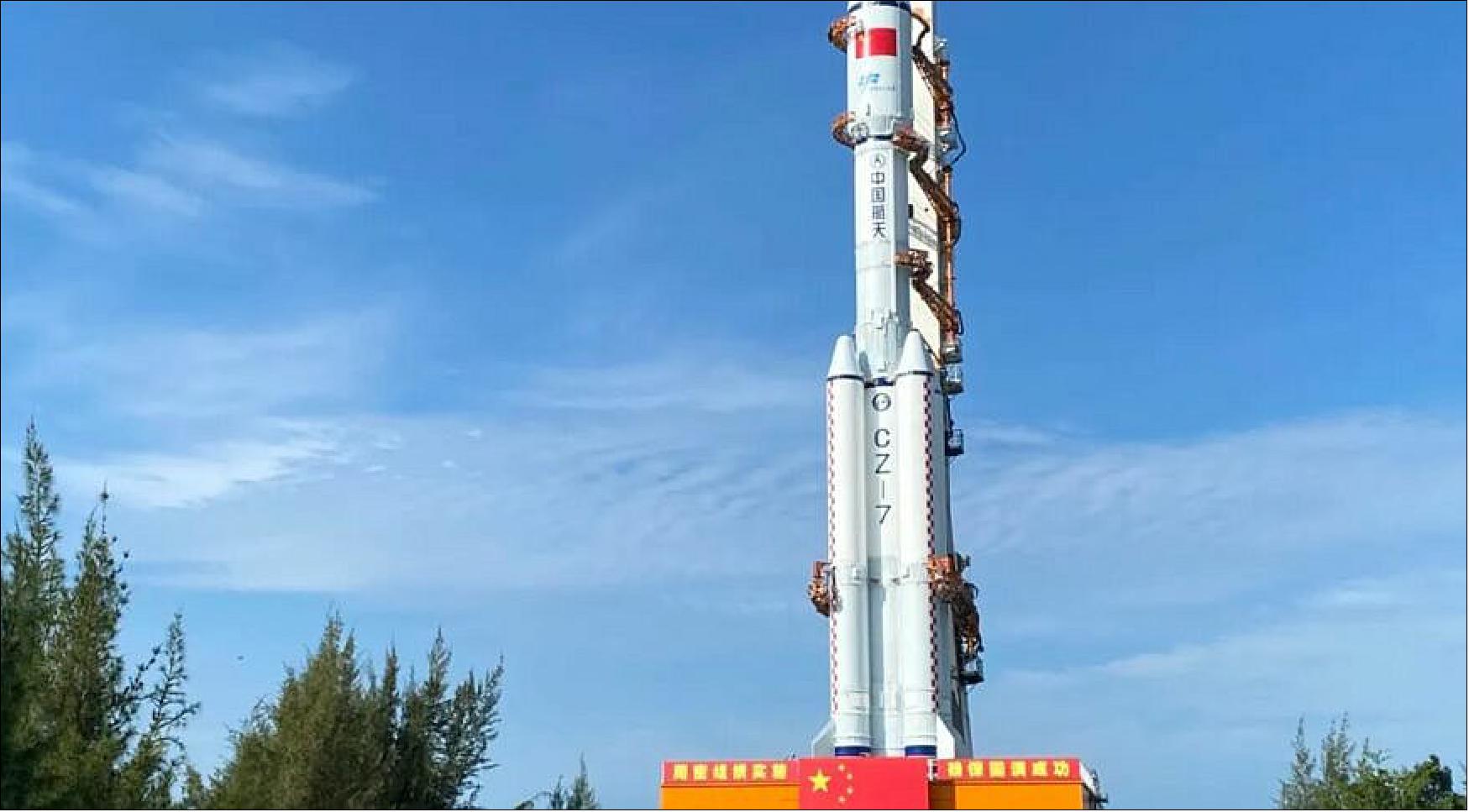
- The Long March 7 is one of a number of new-generation kerolox and hydrolox rockets developed by China over the past decade. Its main role is to launch Tianzhou cargo spacecraft.
- The launcher is powered by 120-ton-thrust YF-100 and 18-ton-thrust YF-115 engines burning kerosene and liquid oxygen on the first, second and booster stages.
- Tianzhou cargo spacecraft have a mass of up to 13.5 tons and can offer differing pressurized and unpressurized configurations. Tianzhou-1 was launched in April 2017 to test technologies crucial to establishing and maintaining a space station.
- Tianzhou-2 launched in May and remains docked with Tianhe. It is expected to soon undock from the Tianhe aft port and dock with the forward docking port and test microgravity propellant transfer. Tianzhou-2 will then later be deorbited over the South Pacific.
- China is apparently looking to foster smaller, commercial cargo capabilities to service the Chinese space station.
• August 16, 2021: China is preparing to launch its second space station cargo supply mission in mid to late September following delivery of a Long March 7 rocket to Wenchang spaceport. 40)
- The fourth new-generation Long March 7 arrived at Wenchang Satellite Launch Center, Hainan island, Monday, Aug. 16 after being transported by ship from Tianjin in north China, China’s human spaceflight agency announced.
- The rocket will launch the roughly 13,000 kg Tianzhou-3 cargo spacecraft into low Earth orbit to dock with Tianhe, the core module for China’s space station.
- The mission is likely to launch around mid September, though China has not officially released a planned date of launch.
- The Tianzhou-3 mission will provide supplies for the upcoming Shenzhou-13 crewed mission which is currently planned to launch in October.
- Preparations for that mission at Jiuquan, northeast China. The Long March 2F rocket for the mission has been readied in advance for use in the case of emergencies.
- China launched Tianhe from Wenchang in late April. The Tianzhou-2 spacecraft docked with Tianhe May 29 before the arrival June 17 of the first crew aboard the ongoing Shenzhou-12 mission.
- Tianzhou-3 will be the fourth of 11 missions set out for the construction phase of the Chinese Space Station.
- The 16.6-meter-long, 4.2-meter-diameter Tianhe (“harmony of the heavens”) will be joined in orbit by two further modules, named Mengtian and Wentian, in 2022. The pair are designed to host an array of experiments in areas including astronomy, space medicine, space life science, biotechnology, microgravity fluid physics, microgravity combustion and space technologies.
- The modules will host domestic and international science payloads. CubeSats can also be deployed from the orbital facility. The chief executive of Nanoracks said earlier this month the company had already lost business to China and its space station.
- Tianhe provides regenerative life support and the main living quarters for astronauts as well as propulsion to maintain orbital altitude.
- The Shenzhou-12 crew of Nie Haisheng, Liu Boming and Tang Hongbo have been aboard Tianhe for 60 days, far surpassing the previous national record for human spaceflight mission duration of 33 days set by Shenzhou-11 in 2016.
- The crew completed a first spacewalk July 4, installing foot restraints and an extravehicular working platform on Tianhe’s robotic arm and raising a panoramic camera. A further extravehicular activity is planned before the crew return to Earth in September.
- The Shenzhou-12 mission is also carrying out a series of 14 space medical experiments, including use of a human system research cabinet aboard Tianhe. The crew conducted a magnetic levitation experiment earlier this month.
- The Long March 7 is one of a number of new-generation kerolox and hydrolox rockets developed by China over the past decade. These include the Long March 5, 6, 7 and 8 series of rockets.
- The launcher is powered by 120-ton-thrust YF-100 and 18-ton-thrust YF-115 engines burning kerosene and LOX on the first, second and booster stages.
- Tianzhou cargo spacecraft have a mass of up to 13.5 tons and differing pressurized and unpressurized variants. Tianzhou-1 was launched in April 2017 to test technologies crucial to establishing and maintaining a space station.
- As well as cargo, experiments, supplies and spacesuits, Tianzhou-2 carried 1.95 tons of propellant into orbit for transfer to the 22.5-ton Tianhe module for maintaining orbit.
- A Beijing startup announced this month it is developing spacecraft which it hopes can provide flexible and cost-effective cargo services to and from the Chinese space station. The development follows a January call for proposals from China’s human spaceflight agency.
- The Chinese space station is expected to operate in orbit for at least ten years. It will be joined in orbit by the Xuntian optical module, a co-orbiting Hubble-class space telescope. The space telescope will have a 2-meter-aperture comparable to Hubble but feature a field of view 300 times greater, allowing 40 percent of the sky to be surveyed across a decade.
• On 17 May 2021, China is set to launch the Tianzhou-2 space station cargo mission this week after rollout of a Long March 7 rocket at the Wenchang spaceport. 41)
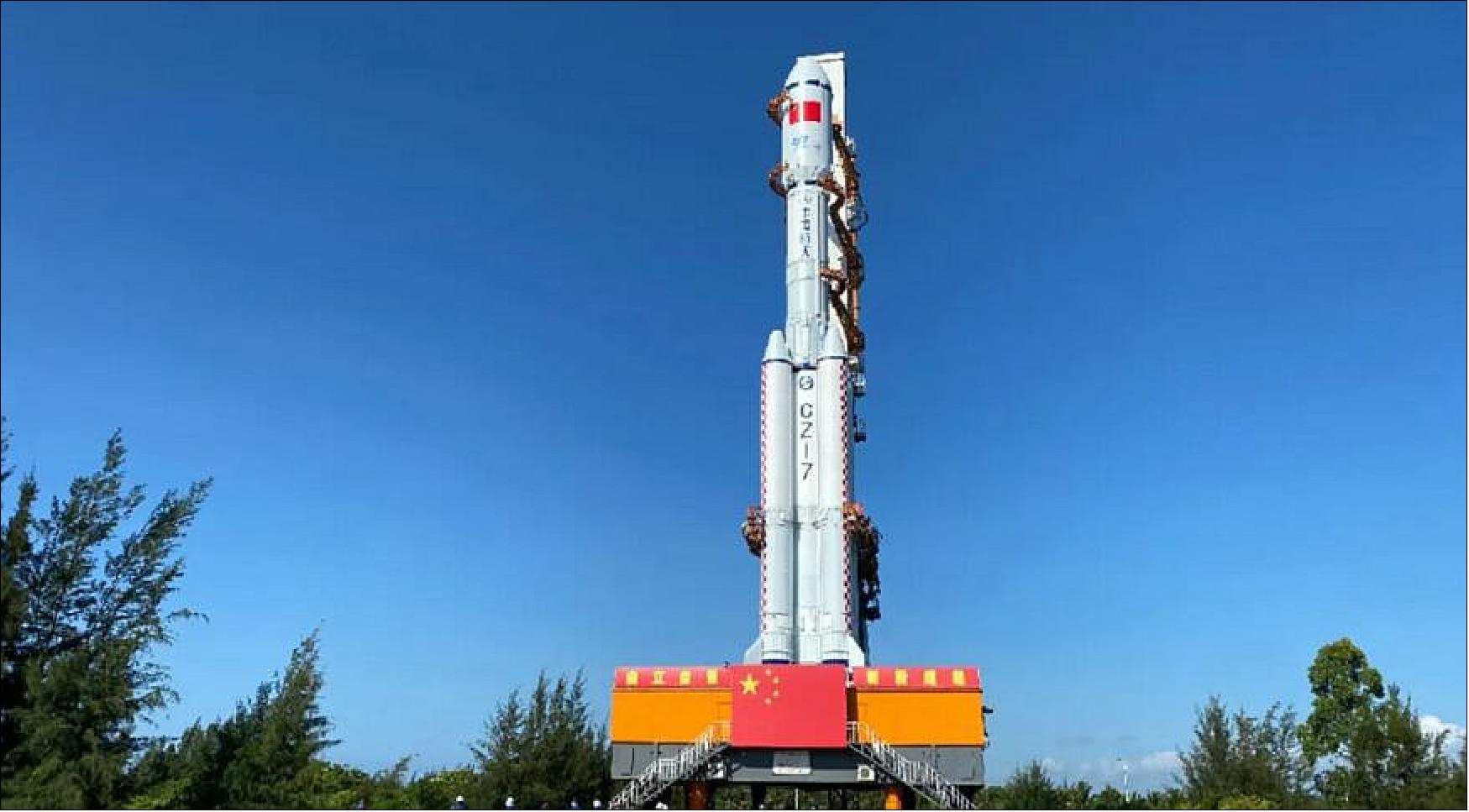
- The Rollout took place on 16 May (Beijing time) at the coastal Wenchang satellite launch center. Final checks, rehearsals and pre-launch preparations will take place ahead of an instantaneous launch window expected around May 20 local time.
- The roughly 13-metric-ton Tianzhou-2 cargo spacecraft will head to low Earth orbit to rendezvous and dock with China’s Tianhe space station core module.
- Tianzhou-2 will transfer propellant to Tianhe for maintaining its orbit and also to deliver supplies to support crewed future missions.
- Three astronauts are set to launch for Tianhe on the three-month Shenzhou-12 mission in June. The mission will launch on a Long March 2F rocket from Jiuquan in the Gobi Desert.
- Tianzhou-2 will carry 4.69 tons of cargo in a pressurized segment and 1.95 tons of propellant, according to CMSA (China Manned Space Agency.
- The 22.5-ton Tianhe space station core module launched on 29 April 2021 at 03:23 UTC on a Long March 5B rocket and is now in an orbit of 360 x 385 km with an inclination of 41.5º. The core stage of the Long March 5B made an uncontrolled reentry May 8 after intense media coverage.
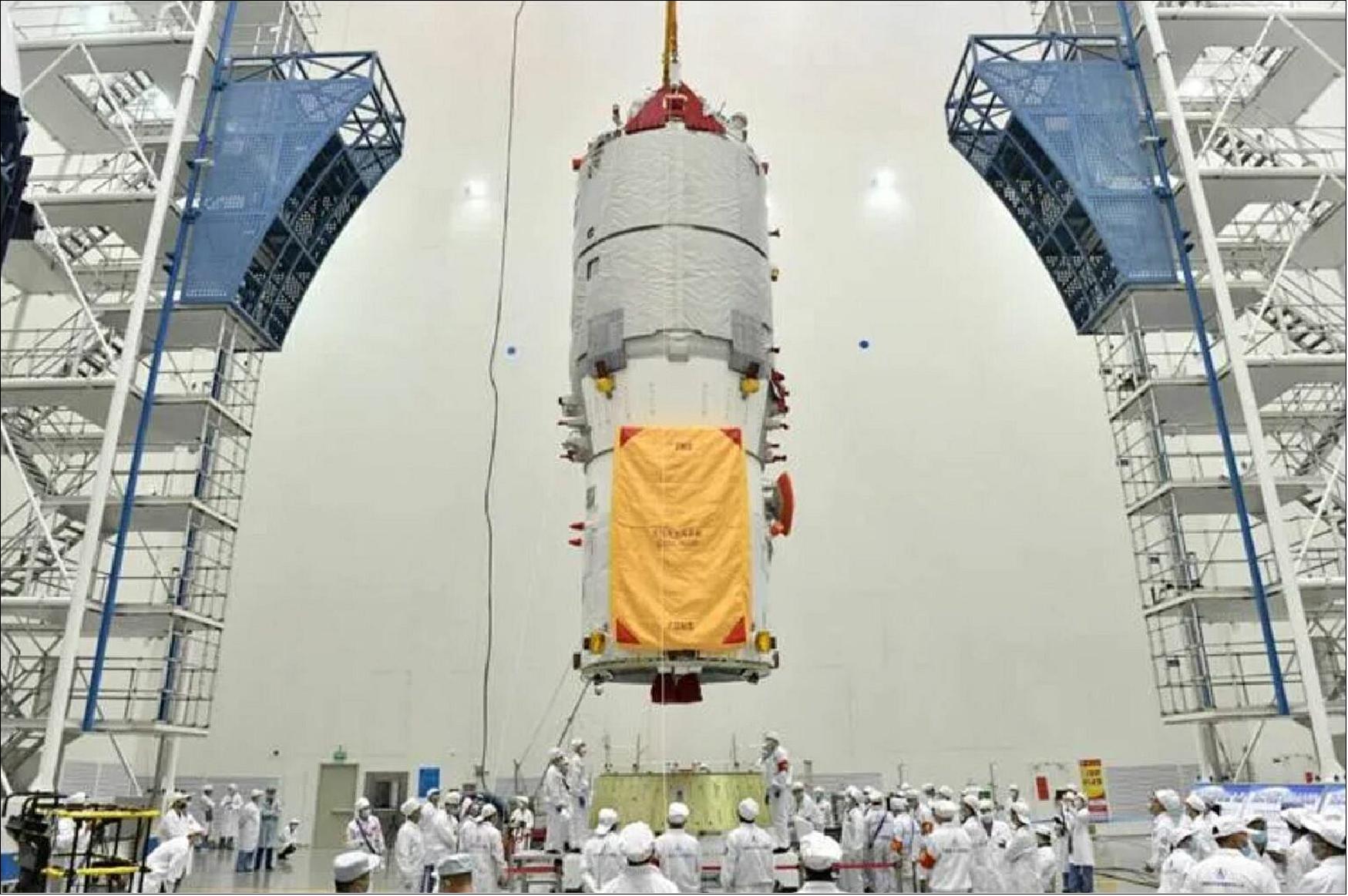
- Tianzhou-2 is the second of 11 launches scheduled for 2021 and 2022 to construct China’s 66-ton, three-module orbital outpost (CSS).
- A Long March 2F rocket and Shenzhou spacecraft will also be on standby at all times at Jiuquan to perform emergency rescue missions to the space station.
- China launched Tianzhou-1 in 2017 to dock with the Tiangong-2 space lab. That mission tested and verified technologies for fuel transfer in microgravity, a necessary capability for maintaining the orbit of the Chinese space station.
- The Long March 7 is one of a number of new-generation kerolox and hydrolox rockets developed by China over the past decade. These include the Long March 5, 6, 7 and 8 series of rockets.
- It is powered by 120-ton-thrust YF-100 and 18-ton-thrust YF-115 engines burning kerosene and LOX on the first, second and booster stages. The first stage will not reach orbital velocity and will fall within a predefined area in the ocean.
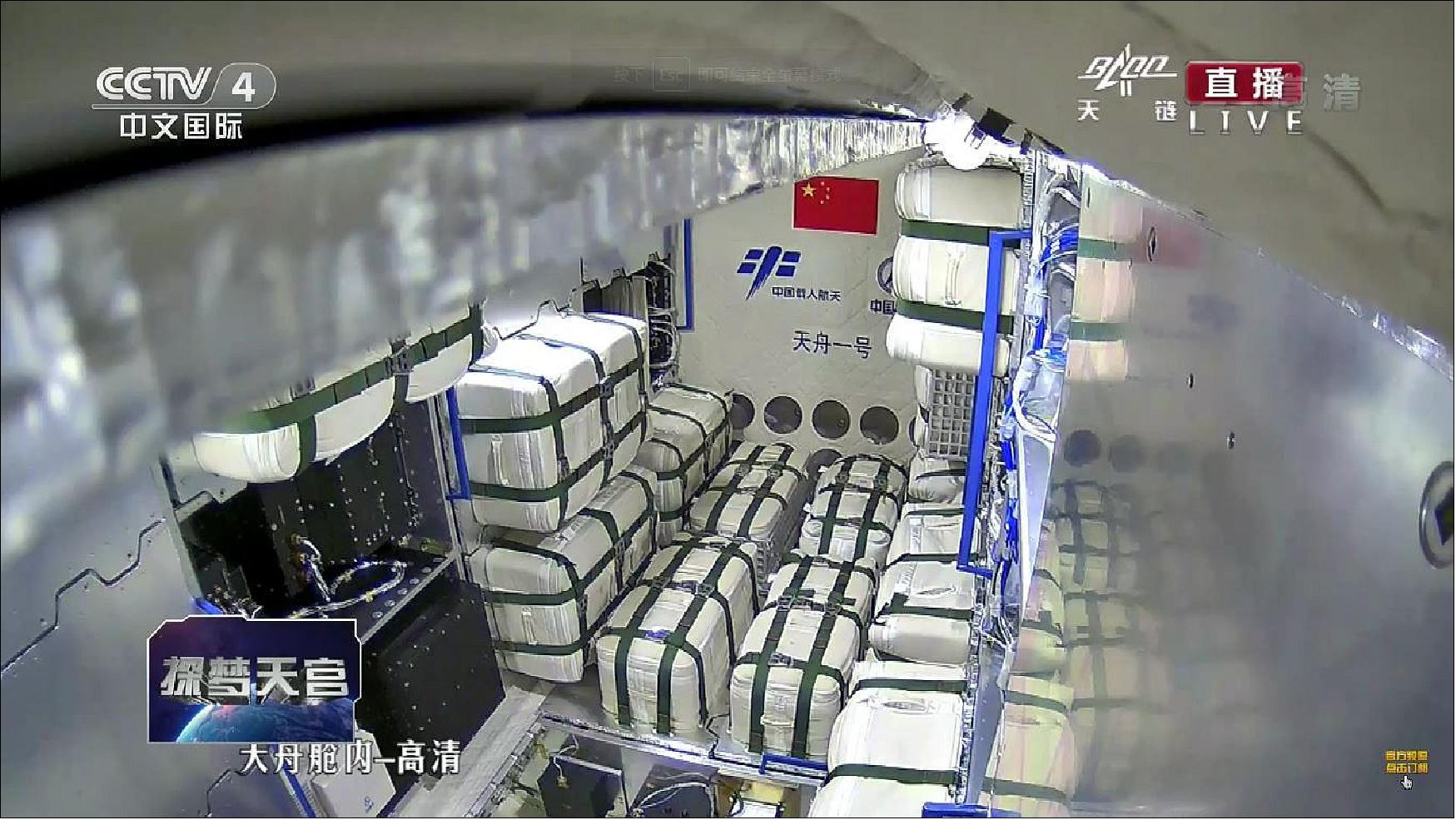
Launch: On 29 May 2021, a Long March 7 medium-lift rocket lifted off from the coastal Wenchang spaceport on Hainan Island at 12:55 UTC [8:55 Beijing time = CST (China Standard Time)]. The roughly 13-metric-ton Tianzhou-2 cargo spacecraft entered its intended orbit and deployed its solar arrays at 13:17 UTC, the China Aerospace Science and Technology Corp. (CASC) confirmed within an hour of liftoff. 42)
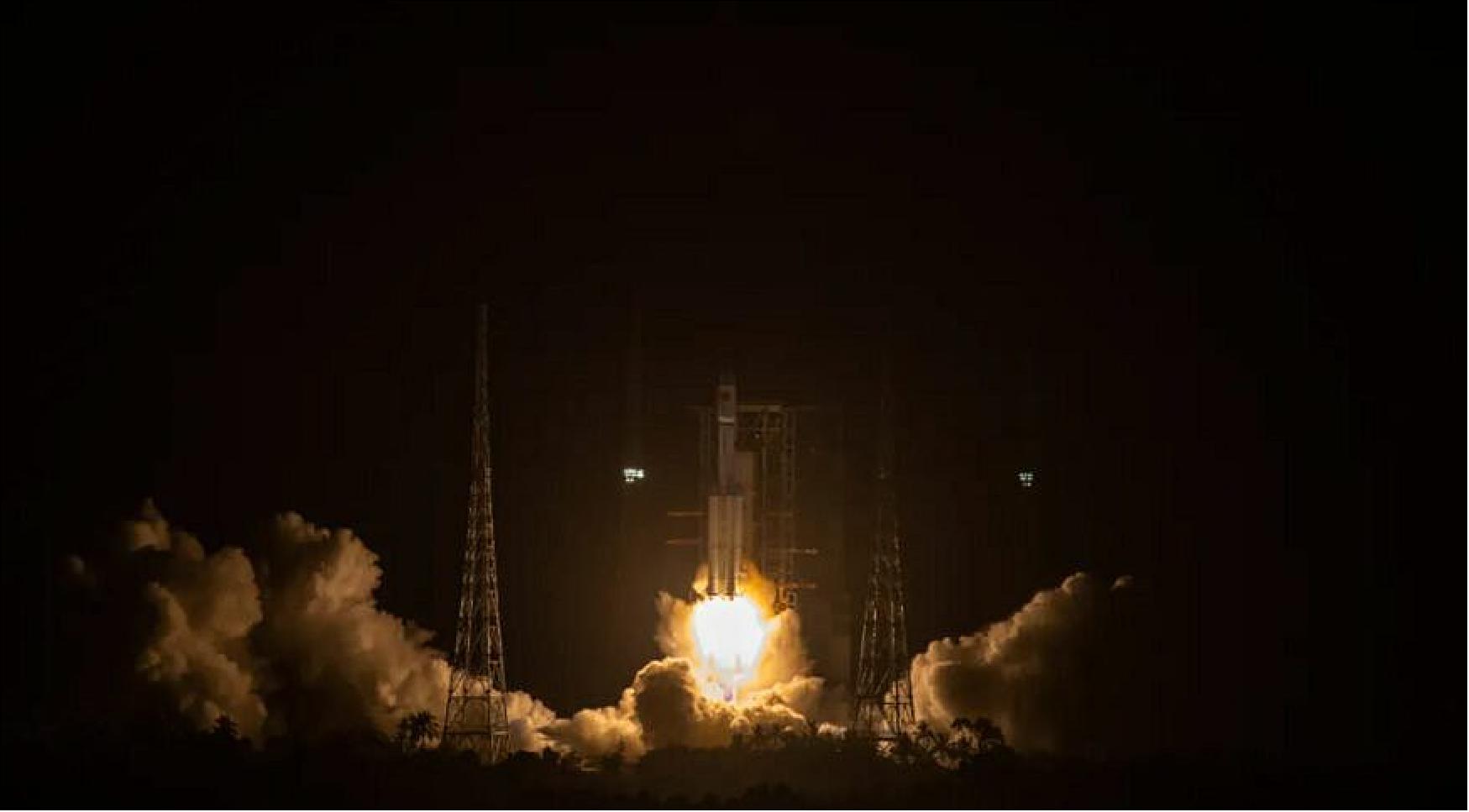
- The uncrewed Tianzhou-2 spacecraft completed automated rendezvous and docking maneuvers with Tianhe at 17:01 CST (22:01 UTC) on 29 May 2021.
- Tianzhou-2 is tasked with delivering propellant and supplies ahead of a first crewed mission to Tianhe in June.
- Tianhe, the first module for China’s space station, launched late April 28 and passed on-orbit testing May 18, according to the China Manned Space Engineering Office (CMSEO).
- Tianzhou-2 matched its 343 by 371-kilometer orbit for rendezvous. Now docked, Tianzhou-2 will conduct an automatic transfer of 1.95 tons of propellant to the 22.5-ton Tianhe module.
- It will remain docked to the station module to support the upcoming crewed Shenzhou-12 mission in June. Tianzhou-2 holds 4.69 tons of cargo in a pressurized segment, including food for the Shenzhou-12 crew for three months. It also carries extravehicular activity space suits and other supplies.
- The 16.6-meter-long, 4.2-meter-diameter Tianhe (“harmony of the heavens”) will provide regenerative life support and the main living quarters for astronauts as well as propulsion to maintain orbital altitude.
- Tianzhou-2 was first expected to launch May 19 but the mission was delayed due to “technical reasons,” according to CMSEO. It is unknown how the delayed Tianzhou-2 docking will impact the Shenzhou-12 mission expected around June 10.
- Tianzhou-2 is the second launch of 11 missions planned for the construction phase of the three-module Chinese space station across 2021 and 2022.
- Experiment modules named Wentian and Mengtian are expected to launch in 2022. The pair will host a plethora of experiments in areas including astronomy, space medicine, space life science, biotechnology, microgravity fluid physics, microgravity combustion and space technologies.
- The Chinese space station is expected to operate in orbit for at least ten years. It will be joined in orbit by the Xuntian optical module, a co-orbiting Hubble-class space telescope. The space telescope will have a 2-meter-aperture comparable to Hubble but feature a field of view 300 times greater, allowing 40 percent of the sky to be surveyed across a decade.
Mission Status of Tianzhou-2
• June 16, 2021: A small proportion of debris from a Long March 7 carrier rocket fell back to waters in the southern Pacific Ocean on Tuesday (15 June) afternoon, said the China Manned Space Agency. 43)
- According to analysis of tracking data, most of the debris burned out during the atmospheric re-entry that started around 4:49 pm, the agency said in a brief statement.
- The rocket, the third in the Long March 7 series, blasted off at a coastal launchpad at the Wenchang Space Launch Center in Hainan province on May 29, sending the Tianzhou 2 robotic cargo ship to a low-Earth orbit to dock with the core module of China's Tiangong space station.
- Propelled by pollution-free fuel, each Long March 7 is 53.1 meters tall and has a core-stage diameter of 3.35 meters. With a take-off weight of 597 metric tons, the rocket is capable of sending 13.5 tons of payloads to the low-Earth orbit or 5.5 tons to the Sun-synchronous orbit.
- One of China's most adventurous space endeavors, the Tiangong station will consist of three main components - a core module attached to two space labs - with a combined weight of nearly 70 metric tons. The entire station is set to work for about 15 years, mission planners have said.
References
1) ”Chinese large modular space station,” Wikipedia, URL: https://en.wikipedia.org/wiki/Chinese_large_modular_space_station
2) China Power Team,” What’s Driving China’s Race to Build a Space Station?," China Power, 7 December 2016, updated 29 April 2021, https://chinapower.csis.org/chinese-space-station/
3) Andrew Jones, ”China prepares for July 24 launch of second space station module,” SpaceNews, 14 July 2022, URL: https://spacenews.com/china-prepares-for-july-24-launch-of-second-space-station-module/
4) Andrew Jones, ”Rocket to launch China’s next space station module arrives at launch center,” SpaceNews, 31 May 2022, URL: https://spacenews.com/rocket-to-launch-chinas-next-space-station-module-arrives-at-launch-center/
5) Liu Yiwei and Yu Fei, ”China's space station to support large-scale scientific research,” Space Daily, 19 March 2022, Source:Xinhua News Agency, URL: https://www.spacedaily.com/reports/Chinas_space_station_to_support_large_scale_scientific_research_999.html
6) Ludovic Ehret and Poornima Weerasekara, ”China ready to launch first crew to new space station,” Phys.org, 15 June 2021, URL: https://phys.org/news/2021-06-china-ready-crew-space-station.html
7) ”Private firms expected to help build space station,” Space Daily, 30 April 2021, URL: https://www.spacedaily.com/reports/Private_firms_expected_to_help_build_space_station_999.html
8) Andrew Jones, ”China rolls out Long March 5B rocket for space station launch,” SpaceNews, 23 April 2021, URL: https://spacenews.com/china-rolls-out-long-march-5b-rocket-for-space-station-launch/
9) Andrew Jones, ”Chinese space station core module passes review but faces delays,” SpaceNews, 11 September 2019, URL: https://spacenews.com/chinese-space-station-core-module-passes-review-but-faces-delays/
10) Stephen Clark, ”New science lab for China’s space station launches on Long March 5B rocket,” Spaceflight Now, 24 July 2022, URL: https://spaceflightnow.com/2022/07/24/long-march-5b-wentian-launch/
11) Andrew Jones, ”China launches Tianhe space station core module into orbit,” SpaceNews, 29 April 2021, URL: https://spacenews.com/china-launches-tianhe-space-station-core-module-into-orbit/
12) Zhao Lei, ”Shenzhou XIV: Astronauts enter Tiangong space station Sunday evening,” China Daily, 6 June 2022, URL: https://www.chinadailyhk.com/article/274538
13) Andrew Jones, ”Shenzhou-14 crewed mission arrives at Chinese space station,” Space News, 5 June 2022, URL: https://spacenews.com/shenzhou-14-crewed-mission-arrives-at-chinese-space-station/
14) Andrew Jones, ”Tianzhou-4 cargo craft docks with Chinese space station,” SpaceNews, 10 May 2022, URL: https://spacenews.com/tianzhou-4-cargo-craft-docks-with-chinese-space-station/
15) Andrew Jones, ”Shenzhou-13 astronauts return to Earth after 182-day mission,” SpaceNews, 16 April 2022, URL: https://spacenews.com/shenzhou-13-astronauts-return-to-earth-after-182-day-mission/
16) Andrew Jones, ”Chinese spacecraft reenters atmosphere ahead of new space station missions,” SpaceNews, 31 March 2022, URL: https://spacenews.com/chinese-spacecraft-reenters-atmosphere-ahead-of-new-space-station-missions/
17) ”Tiangong's robotic arm performs well in test,” Space Daily, 7 January 2022, URL: https://www.spacedaily.com/reports/Tiangongs_robotic_arm_performs_well_in_test_999.html
18) Andrew Jones, ”China aims to complete space station in another huge year in space,” SpaceNews, 3 January 2022, URL: https://spacenews.com/china-aims-to-complete-space-station-in-another-huge-year-in-space/
19) Andrew Jones, ”China’s space station maneuvered to avoid Starlink satellites,” SpaceNews, 28 December 2021, URL: https://spacenews.com/chinas-space-station-maneuvered-to-avoid-starlink-satellites/
20) Andrew Jones, ”Chinese astronaut pair complete six-hour spacewalk,” SpaceNews, 26 December 2021, URL: https://spacenews.com/chinese-astronaut-pair-complete-six-hour-spacewalk/
21) Andrew Jones, ”Shenzhou-13 heads for space station after reaching orbit,” SpaceNews, 15 October 2021, URL: https://spacenews.com/shenzhou-13-heads-for-space-station-after-reaching-orbit/
22) Andrew Jones, ”Astronauts conduct second Chinese space station spacewalk,” SpaceNews, 20 August 2021, URL: https://spacenews.com/astronauts-conduct-second-chinese-space-station-spacewalk/
23) Jeff Foust, ”China’s space station emerges as competitor to commercial ventures,” SpaceNews, 5 August 2021, URL: https://spacenews.com/chinas-space-station-emerges-as-competitor-to-commercial-ventures/
24) ”China’s space station is preparing to host 1,000 scientific experiments,” Nature News, 23 July 2021, URL: https://www.nature.com/articles/d41586-021-02018-3
25) ”Mechanical arm is Chinese astronauts' space helper,” Space Daily, 7 July 2021, URL: https://www.spacedaily.com/reports/Mechanical_arm_is_Chinese_astronauts_space_helper_999.html
26) Andrew Jones, ”Astronauts complete first Chinese space station spacewalk,” SpaceNews, 4 July 2021, URL: https://spacenews.com/astronauts-complete-first-chinese-space-station-spacewalk/
27) ”Astronauts arrange new 'home' in space,” Space Daily, 18 June 2021, URL: https://www.spacedaily.com/reports/Astronauts_arrange_new_home_in_space_999.html
28) Stephen Clark, ”Chinese astronauts enter Tiangong space station for first time,” Spaceflight Now, 17 June 2021, URL: https://spaceflightnow.com/2021/06/17/chinese-astronauts-enter-tiangong-space-station-for-first-time/
29) ”NASA Administrator Statement on China Crewed Launch,” NASA Press Release 21-081, URL:, https://www.nasa.gov/press-release/nasa-administrator-statement-on-china-crewed-launch
30) Andrew Jones, ”Shenzhou-12 docks with Tianhe space station module,” SpaceNews, 17 June 2021, URL: https://spacenews.com/shenzhou-12-docks-with-tianhe-space-station-module/
31) China Focus: ”Effective power supply energizes China's space station project,” Xinhuanet, 15 June 2021, URL: http://www.xinhuanet.com/english/2021-06/09/c_139999119.htm
32) ”NASA Statement on China’s Zhurong Mars Rover Photos,” NASA Press Release 21-067, 19 May 2021, URL: https://www.nasa.gov/press-release/nasa-statement-on-china-s-zhurong-mars-rover-photos
33) ”China's core space station module Tianhe completes in-orbit tests,” Space Daily, 19 May 2021, URL: https://www.spacedaily.com/reports/Chinas_core_space_station_module_Tianhe_completes_in_orbit_tests_999.html
34) Andrew Jones, ”Long March 5B falls into Indian Ocean after world follows rocket reentry,” Space News, 9 March 2021, URL: https://spacenews.com/long-march-5b-falls-into-indian-ocean-after-world-follows-rocket-reentry/
35) Andrew Jones, ”Chinese rocket stage predicted to reenter atmosphere around May 8,” SpaceNews, 4 May 2021, URL: https://spacenews.com/chinese-rocket-stage-predicted-to-reenter-atmosphere-around-may-8/
36) Andrew Jones, ”Shenzhou-13 heads for space station after reaching orbit,” SpaceNews, 15 October 2021, URL: https://spacenews.com/shenzhou-13-heads-for-space-station-after-reaching-orbit/
37) Andrew Jones, ”Tianzhou-3 spacecraft docks with Chinese space station,” SpaceNews, 20 September 2021, URL: https://spacenews.com/tianzhou-3-spacecraft-docks-with-chinese-space-station/
38) Andrew Jones, ”Shenzhou-12 astronauts return to Earth after 3-month space station mission,” SpaceNews, 17 September 2021, URL: https://spacenews.com/shenzhou-12-astronauts-return-to-earth-after-3-month-space-station-mission/
39) Andrew Jones, ”China rolls out cargo mission rocket as Shenzhou-12 astronauts leave space station,” SpaceNews, 16 September 2021, URL: https://spacenews.com/china-rolls-out-cargo-mission-rocket-as-shenzhou-12-astronauts-leave-space-station/
40) Andrew Jones, ”Rocket arrives for second Chinese space station cargo mission,” SpaceNews, 16 August 2021, URL: https://spacenews.com/rocket-arrives-for-second-chinese-space-station-cargo-mission/
41) Andrew Jones, ”China rolls out rocket for Tianzhou-2 space station supply mission,” SpaceNews, 17 May 2021, URL: https://spacenews.com/china-rolls-out-rocket-for-tianzhou-2-space-station-supply-mission/
42) Andrew Jones, ”Tianzhou-2 docks with China’s space station module,” SpaceNews, 29 May 2021, URL: https://spacenews.com/tianzhou-2-docks-with-chinas-space-station-module/
43) ”Debris from carrier rocket drop safely,” Space Daily, 16 June 2021, URL: https://www.spacedaily.com/reports/Debris_from_carrier_rocket_drop_safely_999.html
The information compiled and edited in this article was provided by Herbert J. Kramer from his documentation of: ”Observation of the Earth and Its Environment: Survey of Missions and Sensors” (Springer Verlag) as well as many other sources after the publication of the 4th edition in 2002. - Comments and corrections to this article are always welcome for further updates (eoportal@symbios.space).
Launch Mission Status Supply Missions References Back to top